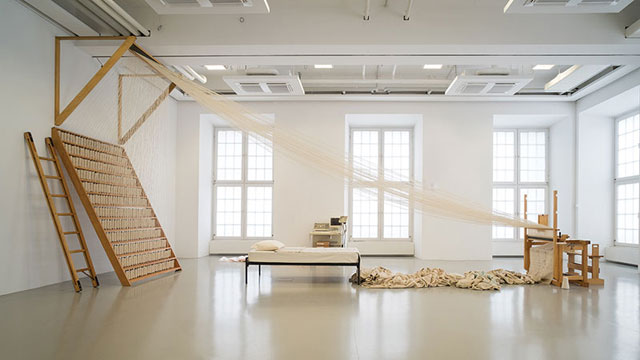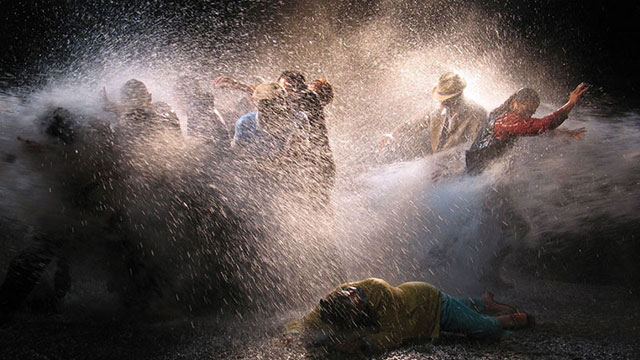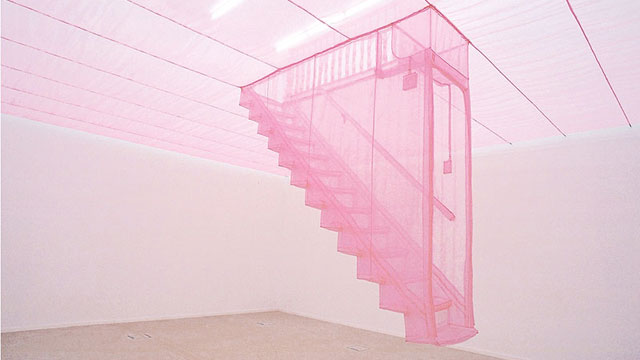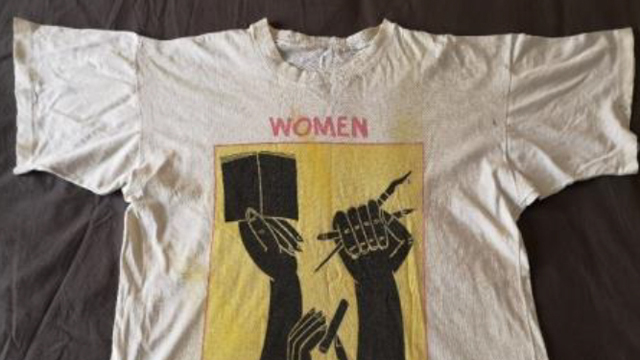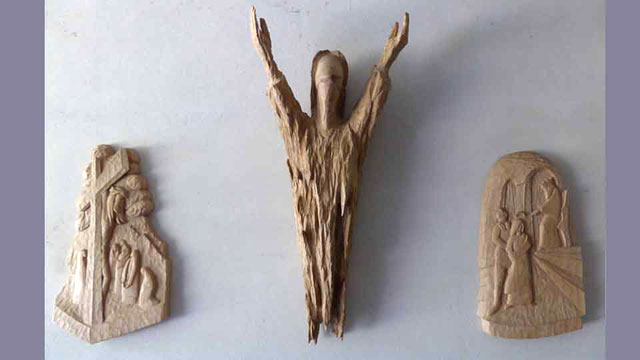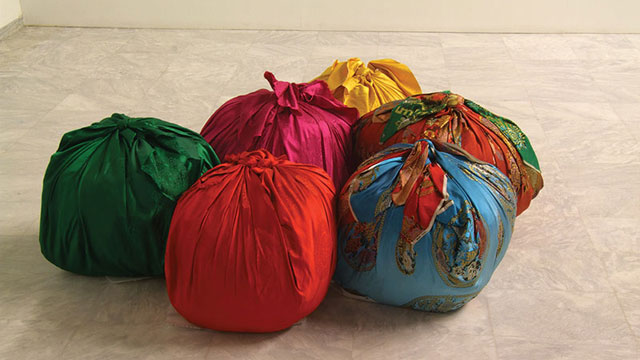Dear user,
This section of our website forms the heart of the EVC project. Here you find a collection of images of objects from different ‘visual cultures’. Our contributors selected and interpreted them in their respective contexts believing that these objects are particularly important for intercultural understanding across boundaries. Each time a user opens this page, the order in which the objects appear changes. In this way we hope to avoid a hierarchical understanding of the collected objects as their entries continue to be accessed in the long run. The constant changing face of the page also reflects the continuous expansion of the collection. As there are already over more than a hundred entries, users may want to form an overview, or to navigate through the growing collection according to their interests. For this purpose, we offer the following search options:

Filter: This enables you to search for objects according to time, place, keywords, etc. / Free title search: If you know the title of an object, you can find it in the free search field. / Lab: In the lab section, objects from the database are grouped under overarching themes. This is an ongoing project and about to be expanded extensively.
Enjoy exploring our database!
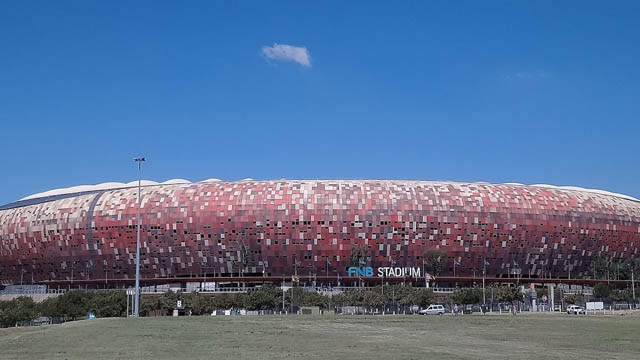
-
 Esther Kibuka-Sebitosi
Esther Kibuka-SebitosiSouth Africa gained its independence in 1994 with Nelson Mandela becoming the first black President on the fall of apartheid. The problem was: Even after the demolition of the apartheid system, social cohesion was a challenge as people still lived and gathered in separate groups, according to their race. Freedom had come but the people still segregated themselves. One of the ways to promote social cohesion is through sport. The hosting of the 2010 World Football cup therefore was a welcome opportunity.
The photograph shows the First National Bank Stadium or simply FNB Stadium. It is also known as the Calabash, because of its resembling an African vase. It is located near Nasrec and bordering Soweto and Johannesburg.
The Department of Arts and Culture defines Social cohesion as “the degree of social integration and inclusion in communities and society at large, and the extent to which mutual solidarity finds expression among individuals and communities”. This means that South African communities or society is cohesive when “ the extent that the inequalities, exclusions and disparities based on ethnicity, gender, class, nationality, age, disability or any other distinctions which engender divisions, distrust and conflict are reduced and/or eliminated in a planned and sustained manner. Thus, with community members and citizens as active participants, working together for the attainment of shared goals, designed and agreed upon to improve the living conditions for all”.
Based on the above understanding, building a nation is a complex process that entails “a society with diverse origins, histories, languages, cultures and religions come together within the boundaries of a sovereign state with a unified constitutional and legal dispensation, a national public education system, an integrated national economy, shared symbols and values, as equals, to work towards eradicating the divisions and injustices of the past; to foster unity; and promote a countrywide conscious sense of being proudly South African, committed to the country and open to the continent and the world“.
The hosting of the World Football Cup therefore was an optune moment in the history of the nation. According to Barolsky, (2011) sport was used as a catalyst to build a non-racial, non-sexist, democratic, prosperous and free South Africa. The FIFA World cup in 2010 referred to it as „African and South African. The Bafana Bafana team received great support from home. The social cohesion was divided into three dimensions: Civic, Social and Economic."
The impact of the FIFA World cup was significant in building social cohesion. There was little doubt that the World cup was an “extraordinarily unifying moment for the country as whole, which broke down social, racial and even gendered barriers as women were increasingly drawn into the fervor around the a game usually predominantly watched by men.” (Barolsky, 2011)
References
- Barolsky, V (2011).Impact of 2010 soccer World Cup on social cohesion and nation-building, Technical Report · January 2011.
- DOI: 10.13140/2.1.2007.5841
- Retrieved from https://www.researchgate.net/publication/271700976
- Department of Arts and Culture statement on Social Cohesion
published April 2020
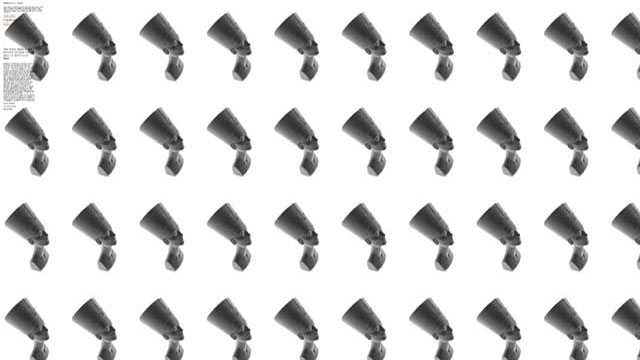
-
 Niklas Wolf
Niklas WolfIn ancient Egypt there was an elaborate system of reproduction around representative works of art. Gypsum casts of royal statues ensured that images of rulers were comparable and consistent nationwide. The formal type of a portrait bust, however, is as special as the material of Nefertiti’s representation. Stone figures, combined with a publicly effective installation, corresponded to ideas of permanence and a ruler’s longevity. The stone bust’s surface is coated with gypsum, which enabled a particularly fine design, and brightly coloured paint. The latter is preserved in its original condition (Tyldesley 2018).
Technology, material, surface and the design of the object play an important role in Nora al-Badri and Jan Nikolai Nelles’ project The Other Nefertiti (Pinther 2018). This project intentionally raises a number of questions that refer to discourses about provenance and access to both one’s own and foreign cultural assets, as well as their relocation. Moreover, it points towards a possible democratization of globally significant, mobile artefacts. What happens to a visual object when it is reduced to the essence of its digital data? How can digital processes and media be part of such discourses, and even possibly their solution? As part of an artistic intervention, the two artists penetrated the space of the museum and photographed the bust with concealed scanners, from which they were able to generate a multitude of detailed data to create a 3D print. Within the framework of a Common Creative License, this data is accessible online to the general public and provides “immaterial material” for future images as well (Nelles 2016). Anyone with access to the Internet and a 3D printer will therefore be able to print a copy that corresponds to the shape of the original, thereby democratizing the cultural asset. This gesture directly counteracts how strongly the accessibility of such assets are typically regulated – not even amateur photographs are permitted in a museum context, as the Berlin State Museums (Staatliche Museen zu Berlin) retain sovereignty over the object and its image. Both the generation of the data and the symbolic return of a Nefertiti copy and its burial in the Egyptian desert were documented on film. The project thus becomes part of a discourse critical of museal practices such as those of the Berlin State Museums: in reaction to the publication of the data, they referred to the legality of ownership, the ban on photography and the possibility of various – strictly regulated – accesses to the object and its reproductions. (SPK 2016)
Questions of accessibility and the relocation of cultural assets were also the topic of a seminar held at the Ludwig Maximilian University in 2019. A female student, who gave a lecture on the relocation of Nefertiti, contributed to the discussion by printing a Nefertiti bust using data from the Nefertiti hack. In contrast to the Berlin original and a printout based on Nelles and al-Badri’s data, this bust was greatly reduced in size and made of fluorescent material. A significantly expanded conception of art developed amidst questions of reproducibility, reproduction, aura and figurative trademarks. Unlike the officially signed copies produced by the Berlin Gipsformerei, these replicas are made at a greater distance from the original. No direct contact is necessary, the distribution is globally possible. There are several processes of translation and transformation that create new networks between bust and recipient. First, an immaterial object – the data set – is created, which gains new materiality through printing. The latter is freely scalable, a series of enlarged or downsized reproductions can be made, which would nevertheless correspond in scale to the dimensions of their source; materially, a Nefertiti created that way would never (want to) correspond to the bust of Nefertiti. Artists thus become the authors of new “truthful” objects. The story of the original begins to overlap with the narrative of its reproduction: the intriguing story of outwitting and interrogating the museum becomes an immaterial and performative work of art, which exists on an equal footing with the shapeless dataset and the multitude of printed and altered Nefertiti busts.
What can an object do as a representative? Which discursive spaces does it operate within? What kinds of questions can be asked of the original and copy? Which terminologies are capable of describing new metamorphical translation processes and aesthetics?
Critical comments on the Nefertiti project point out that simple, transportable scanners would not be able to capture images that would allow such high-resolution data sets. It is possible that Nelles and al-Badri gained access to professional scans commissioned by the Berlin State Museums or that they themselves had a replica of the bust scanned (SPK 2016). Both remarks are difficult to verify after the fact and do not affect the intention of the project.
Little is known about Nefertiti’s life; she encountered the global visual memory through a singular object, the portrait bust exhibited in Berlin, which stands for timeless glorified beauty and power in its own right. Questions about the accessibility of such images are already inscribed in the contexts in which they were created. In the ancient Egyptian tradition of exhibiting, powerful pictures worked between showing and concealing, they functioned as temporarily enlivened representatives of royal or divine power (Hornung 1971). Closely bound to constantly changing contexts of religion and rule, they had a constitutive memorial function in society, represented absent power, and were threatened by iconoclastic destruction. With the beginning of the colonization of the African continent by Western powers, Egypt’s cultural heritage was of particular archaeological and political interest to both public and private collections, as well as the art market.
(Read more on the history of the Nefertiti bust and the concept of partage...)
In contemporary terminology used to discuss ancient Egypt, terms of similarity (likeness) were summarized in discourses between original and copy: tut means (perfect) similarity; image, role and model coincide in one object and correspond to each other. Tut ankh is a living image (Tyldesley 2018) – (…) conceptual art was designed to represent the exact nature of a thing or person in the simplest way possible (…) (Tyldesley 2018). Perhaps the busts of Nefertiti – the dislocated cultural artefact in Berlin, as well as the multitude of possible reproductions from 3D printers worldwide – fall into very similar transcultural categories of representative likeness.
Delve deeper into the reception history of the bust.
References
- Hornung 1971: Hornung, Erik. Der Eine und die Vielen. Altägyptische Götterwelt, Darmstadt 1971
- Nelles 2016: Nefertiti Hack. Artist homepage: http://nefertitihack.alloversky.com (25.01.2019)
- Pinther 2018: Pinther, Kerstin; Weigand, Alexandra (Hrsg.). Flow of Forms / Forms of Flow. Design Histories between Africa and Europe, Bielefeld 2018
- SPK 2019: Stiftung Preußischer Kulturbesitz: „Nefertiti Hack” ein Schwindel?, 09.03.2016. http://www.preussischer-kulturbesitz.de/meldung/article/2016/03/09/nefertiti-hack-ein-schwindel.html (25.01.2016)
- Tyldesley 2018: Tyldesley, Joyce. Nefertitis Face. The Creation of an icon, London 2018
published February 2020
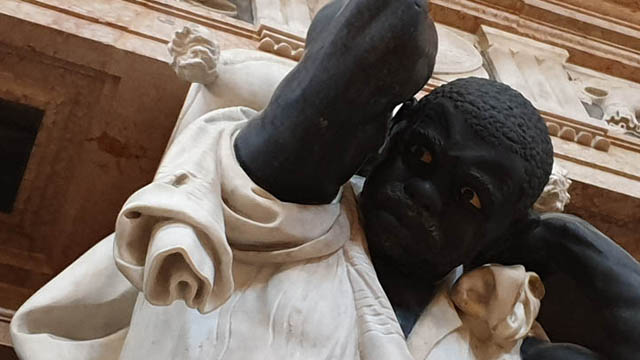
-
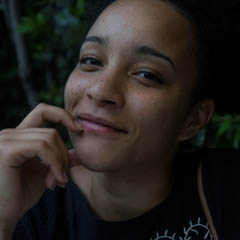 Leonie Chima Emeka
Leonie Chima EmekaFour figures of captured Africans in black and white marble support a massive triumphal arch on their shoulders. On white marble cushions rests the heavy construction with a sculpture of the doge Giovanni Pesaro in its center. flanked by four virtues — Fides, Fortitudo, Caritas and Justitia — the effigy states justice, faith and militant power as the virtues of the Venetian Republic under the reign of Giovanni Pesaro.1 With striking vividness the tomb seems to propagate the subjection of the black body in favour of the Venetian civilisation.
The literally black skin of the slaves, their round faces, full lips and swallowing round eyes encourage the assumption that what we see here is a typed representation of the so called ‘Sub-Saharan African’. Our perception today is materially influenced by the knowledge of images of Blackamoors in American and European popular culture, as well as the concrete exploitation of the black body during colonialism and slavery. The experience of Venetians in the 17th century, however, was considerably different to our postcolonial and post-slavery perception today. What nowadays generates emotions of horror and contempt, was meant to advertise a short reign that lasted merely one year from 1658 until the doge's death in 1659.2 The tomb was built in 1669, ten years after Giovanni Pesaro’s demise, according to the design of the famous Venetian architect Baldessari Longhena (1598-1682).3
The figures of the black slaves are by most accounts ascribed to the German sculptor Melchior Barthel (1625-1672) and relate, not to Africans captured in the transatlantic slave trade, but to the people enslaved in the war against the Ottoman Empire in defence to the island of Candia (today Crete) which was partly lead under Pesaro’s command.4 The weapons and armour which adorn the entablature suggest that the tomb in the shape of a triumphant arch refers to a victorious war. The iconography of victory, however, is a vast exaggeration of the truth, as Pesaro had not been considered successful in his defence of Candia and “ironically the island fell in the hands [… of the Ottoman; note from the author] in 1669, as the monument was completed”.5 Other than the slave’s de-humanising features might suggest the monument does not legitimise systematic exploitation of the black body equally to blackamoor iconography. Although the transatlantic slave trade had already started when the Pesaro tomb was completed, many more Europeans suffered enslavement in North Africa than has previously been commonly acknowledged.6 Venetian enslavement was such a common experience, that “both Ottomans and Venetians counted their imperial rivalry partially in terms of slaves taken and returned”.7
In 1669 Great Britain, which later became the most investigated in the transatlantic slave trade, lost more people to Ottoman enslavement than the other way around. The military strength of the Ottoman Empire rather suggests that the compositional subjection of the black marble slaves are meant to refer, or even constitute, a military strength that was strongly challenged in Pesaro’s lifetime. Unlike the blackamoor iconography, the grave is not to be understood as a visual manifestation of the transatlantic slave trade and colonialism, but postulates a militaristic superiority that was in fact strongly challenged.
Although the black marble slaves in Venice precede blackamoor imagery and its historical context, one cannot disconnect our perception from the traumatic history that would follow. It is hard to overlook the de-humanising effect of the eternally oppressed African sculptures and not to remember the disturbing past of systematic enslavement and its visual representation in de-humanising blackamoor imagery. Even if compared to another massive monumental sculpture featuring Africans as captives the black marble slaves remain singular in their artistic strategy of de-humanisation of the black body.
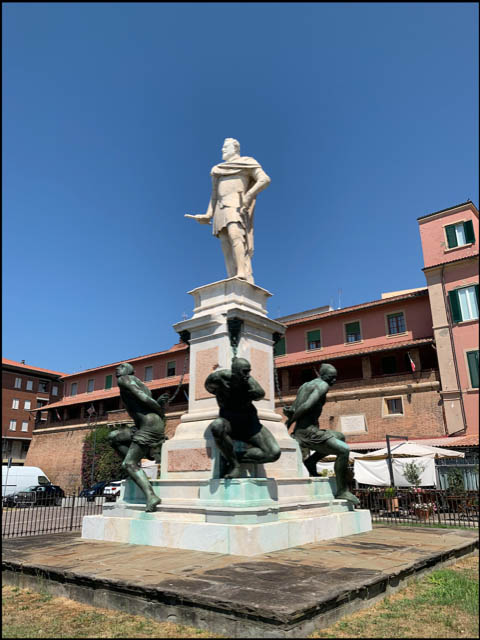
© Leonie Chima Emeka
Giovanni Bandini, Grand Duke Ferdinando I de' Medici 1597-99,
marble, and Pietro Tacca, I quattro Mori, 1621-26, bronze, height 33 ft. 3 in. (10.14 m)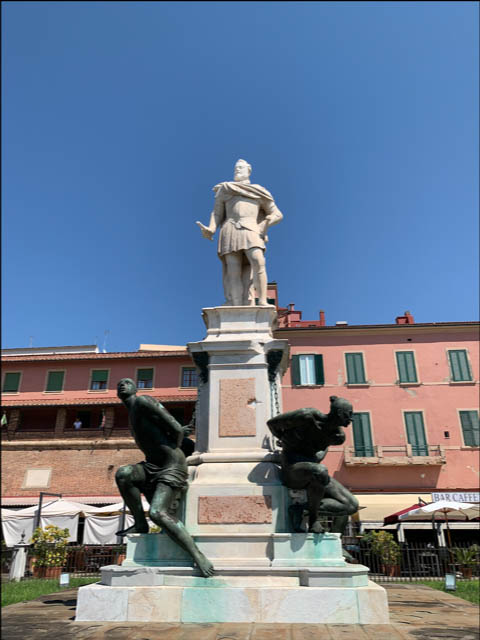
© Leonie Chima Emeka
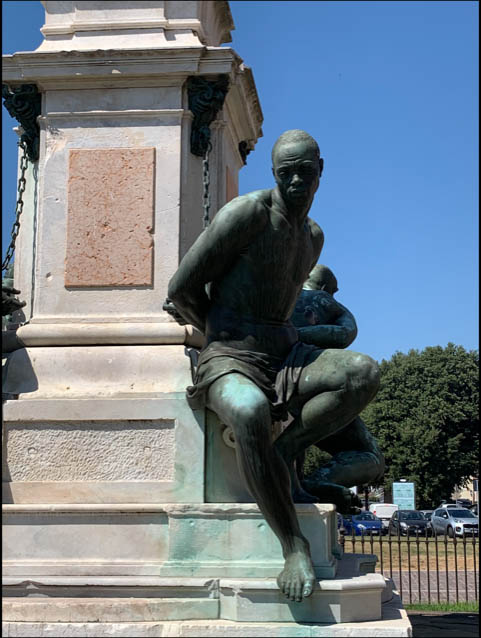
© Leonie Chima Emeka
Pietro Tacca, I quattro Mori, 1621-1626, Piazza Micheli, Livorno
The Monument to Grand Duke Ferdinando I de' Medici in Livorno, Tuscany, is considered the first public monument in early modern Italy to depict enslavement of the black body as a violent act and might have served as a model for the black marble slaves in Venice.8 The four bronze figures were manufactured in 1626, only 33 years before the Venetian sculptures, by Pietro Tacca. The four Livorno slaves are in fact a later addition to the monument of the likeness of Ferdinando I. Grand Duke of Tuscany.9 Tied to the pedestal they are meant to be understood under the control of Ferdinand I. It is the slaves’ strength and the explicitly forced subjection of these muscular bodies that indicate the elegant but lean Ferdinando I as a strong, assertive and powerful figure.
The four attributes of power completed in Pesaro’s youth, might have offered an alluring imagery for the later Doge, who had been highly criticised and actually taken to court for his military actions in defence of the Isle of Crete.10 Also the Venetian slaves represent physical strength as they support the massive tomb on their shoulders. The round eyes and big lips in the grimacing round faces which are contorted to an almost animal expression, however, mark the Pesaro slaves as hideous beings. The Venetian Slaves surpass their models in Livorno transcending the degree of de-humanisation to evoke the impression of the African slave as inferior. The slaves in Livorno, who wear a challenging or defeated expression, invite sympathetic emotions while the Venetian figures are deformed to almost caricatures. The status of dominance and subjugation is already apparent in the Venetian figures themselves. Not the presence of the chains, nor their mere position marks them as victims of subjection. It is rather indicated that the subjection is already incorporated in their hilarious features. In presence of the Pesaro slaves one cannot help but feel the uncomfortable impression, that it is the slaves themselves, their explicitly depicted inferiority, which legitimises their enslavement. Barthel’s artistic strategy of de-humanisation marks a shift in the representation of the black body in European imagery. If racism is defined as the naturalisation of the inferiority of the black body it concludes: the Monumento al Doge Giovanni Pesaro is a racist monument before systematic racism.
Footnotes
1 Identification of virtues: da Mosto, p.250.
2 Da Mosto, p.253f.
3 Da Mosto, p.251. Longhena’s plan can be found in the Zentralinstitute für Kunstgeschichte in Munich.
4 Ascription and life dates: Kaplan, p.186. Residency in Venice and Ascription: De Mosto, p.251.
Ascription to Ottomans and War of Candia: Da Mosto, p.238, p.249, p.253. Kaplan, p.186.
5 Kaplan, p.186. Although Kaplan and De Mosto name “Turks”, I chose the term Ottoman according to Lowe’s statement, that the term ‘Turks’ was often used to describe the whole Ottoman Empire. Da Mosto, p.253.
6 Davis, p.87ff.
7 Rothman, p.429
8 Rosen, p.38.
9 Construction of pedestal and sculpture: 1597 and 1599 by Giovanni Bandini ibid., p.38.
10 Da Mosto, p.254.
published July 2020
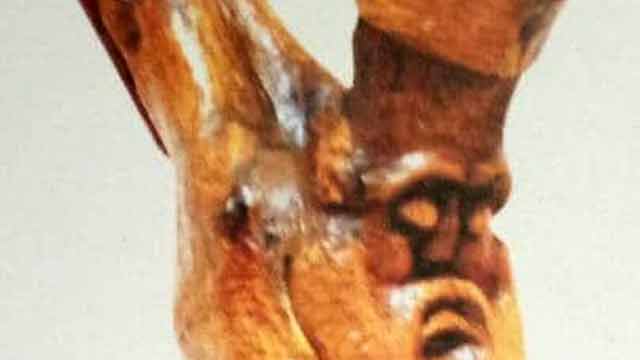
-
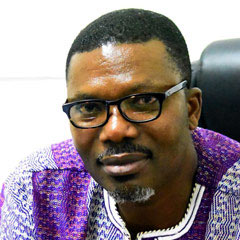 Patrique deGraft-Yankson
Patrique deGraft-YanksonFortunately, contemporary Ghanaian artists like Vincent Akwete Kofi and Kofi Antobam, who by their training, developed both the skills and the mindset to create and fully appreciate African arts have played major interventional roles. They, through rigorous production of masterpieces over the years, led the move to redirect the wavelength of Ghanaian artistic expressiveness along the paths of decolonization. A typical example of these arts is the Crucifix, the selected object for this discussion.
The Artist – Vincent Akwete Kofi
The Crucifix is a sculpture in the round, measuring 45x10x19 inches, and was created by Vincent Akwete Kofi, a Ghanaian artist who lived between 1923 and 1974. Characteristically, Vincent creates outstanding sculptures in humanistic forms. His sculptures speak to traditional African philosophies, ideals and beliefs (Grobel, 1970), and he through his works, seeks to reinforce the beauty, dynamism and complexities of African art. Indeed, Vincent’s artistic posture was largely informed by his training in the then Achimota College in the Gold Coast (now Ghana), an educational institution which sought to bridge the gap between European and African forms of knowledge (Woets, 2014).
Description and interpretation
The Crucifix was carved in tropical hard wood, one of Vincent Kofi’s preferred media, with the style and subject matter reminiscing his belief in the creative and objective fusion of lessons from the history of modernism in the arts by an immersion in his Ghanaian heritage. Like his earlier sculptures therefore, the choice of this Euro-Christian theme throws lights on his Pan-Africanism and decolonization intents.
The sculpture is a depiction of a free-standing human figure with features that conform with his earlier wood carvings, such as depiction of enlarged head and heavy feet which are more representational than naturalistic. Again, the entire form is seen as being directed by the limitations of the tree trunk deliberately chosen for the work. This, of course is one of Kofi’s traditional wood carving styling.
The Crucifix is postured in a clasped forward-bent lower limb. Like the lower limbs, the upper limbs of the figure which are raised over the head and stretched backwards, are also clasped together, depicting the entire image in a rather discomforting posture. Further strengthening the feeling of distress and discomfort in the image is the dropped and lifeless face and facial features of the image. The long thick beard of the image with the tightly fitting cylindrical hat on the head, carved after one of those won by royals among some sections of Ghanaians, give the figure an elderly look.
Other significant features of the image are the exaggerated clasped, forward-bent and wobbly elephantine feet, dropped face with shuttered eyes, flaccid body/skin/muscles (which is visible even in wood), and the heavy beard.
In trying to understand the presentation of the Crucifix, it is important to note that Ghanaians have stories about characters who lived and suffered similar fates as that of the Christ. The Fante people (a section of the Akan ethnic group), for example have records on a man called Ahor, who offered himself as a sacrifice to the gods, when the life of a human being was demanded as an antidote to a calamity which befell the people. Up to today, Ahor is celebrated in a festival called Ahorbaa to commemorate his brave and sacrificial feat. Other ethnic groups in Ghana have similar stories which render the Passion of the Christ not just a familiar phenomenon, but a lived experience recorded in the history of the people.
Also worthy of notice is the familiarity of the various themes which characterize the story of the Christ, such as his kingship, miraculous personality, sacrificial journey and his eventual torture and death. The Crucifix therefore, was Vincent Kofi attempt at depicting the passion of the Christ in a way that would make it familiar and relevant to the people.
The image in Kofi’s Crucifix was therefore needed to be presented as a man with royal personality, as depicted in the cylindrically shaped cap, which is symbolic of some of the Ghanaian royal millinery that depict kingship and authority. This is reinforced by a heavy beard to portray wisdom. Wisdom which is reserved for kings and aged people.
Analysing from the experiences of a people whose history was not devoid of unpleasant experiences, such as enslavement, brutal torture and execution, the image presented in the Euro-Christian Crucifix could not have been a complete representation of the Man of Sorrow described in the Christian holy book (Isaiah 53:3). Kofi therefore saw the need to present a figure which paints a real picture of a man who had gone through an extreme physical pain. Those strong and heavy, yet wobbly feet were a symbol of a man overburdened with sorrows and sins of the world.
Indeed, the man on the Crucifix was dead, with no chance of maintaining a smooth and shiny skin as seen in the Euro-Christian crucifix. In Vincent Kofi’s Crucifix, therefore, he, even in wood, managed to present a flaccid body/skin and muscles which, with the closed eyelids, dropped and lifeless face gave an impression of an extremely tired dead body. Probably an artistic rendition that comes close is Mel Gibson’s crucified Christ in his movie, the Passion of the Christ.
Conclusion
Early missionaries introduced the Christian religion with its attendant icons, images, stories and language in 1400s. Semblance in religious icons, images, stories and their associated functions made the acceptance of Christianity easier among indigenous Africans/Ghanaians. Vincent Kofi’s Crucifix could therefore be considered as a great effort towards connecting foreign Christian belief systems to known religious experiences, thereby making Christianity much more relevant to the African than it has been.
References
- African Artists in America (1978). African Affairs, 11 (3), 84-85.
- Frank, B. (1999). The Visual Arts of Africa: Gender, Power, and Life Cycle Rituals by Judith Perani and Fred T. Smith (A review). African Affairs, 11 (3), 14-16.
- Kwami, A. (2016). Kofi, Vincent Akwete (1923–1974). In the Routledge Encyclopedia of Modernism.: Taylor and Francis. Retrieved 31 Dec. 2021, from https://www.rem.routledge.com/articles/kofi-vincent-akwete-1923-1974. doi:10.4324/9781135000356-REM845-1
- Moore, G. (1967). The Arts in the New Africa African Affairs, 66 (263), 140-148.
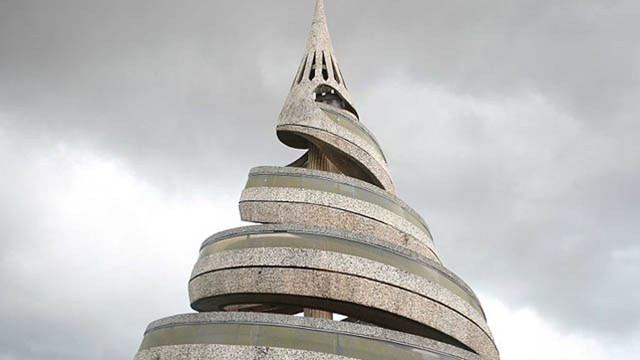
-
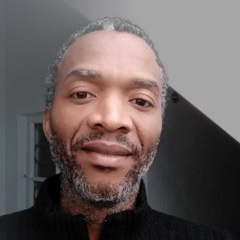 Paul-Henri Souvenir ASSAKO ASSAKO
Paul-Henri Souvenir ASSAKO ASSAKOThe "reunification" is the result of a synergy of different societies willing to modify their way of life and the principles of their socio-cultural organization in order to cope with the vicissitudes of the colonial yoke. These societies are based in the Great West, the Coastline, the Southern Forest, the East and Lake Tchad, the regions that mark Cameroon’s geography. Each of these regions is home to a large number of ethnic groups such as the Bamileké, the Bamun, the Akunakuna, the Babungu, the Duala,the Beti, the Fang, the Peul, the Kirdi, the Fula, the Dourou, the Fali, etc. The date of May 20th, 1972 marks Cameroon’s passage from Federal Republic to United Republic by referendum. This date can be said to be the culmination of the political commitment initiated on the 1st of October 1961 with the reunification. Based on this commitment of 1961, Cameroon continued the construction of a unitary state and the consolidation of national unity encompassing the country's entire population. It can be argued that this unitary state was the only way to protect Cameroon’s sovereignty after Independence and to implement projects of prosperity. In President Ahidjo’s words of 1961: "It is together that we will make our Cameroon finally returned to the borders of our ancestors1, a modern country where it will be good to live in a climate of freedom, fraternity and prosperity." (Mveng 1985, 262).
The Reunification Monument is situated on "Plateau Atemengue", Yaoundé’s political and administrative centre. In this area, the colonial administration had placed institutions for education and administration that were crucial constituents of the new country: the National Assembly, the school of administration and the judiciary, the military headquarters, the Leclerc High School and the University of Yaoundé, to only name a few examples. The large boulevard initially used for the parades commemorating the celebration of the feast of national unity is located on this plateau as well. Placed on top of the city, amongst the republic’s essential institutions the Reunification Monument was obviously meant to become a reminder of the sense of unity amongst the initiatives engaging the Cameroonian republic.
The ensemble of the Reunification Monument consists of an architectural structure and a sculpture. According to Noé Tonye2, its shape emerged from sketches selected by the public authorities following a national and international competition on the theme of reunification launched by the Cameroonian Head of State. However, the identity of the authors of this monument suggests that they might also have been directly commissioned because they appeared qualified for the job due to their previous projects. These artists are Gédéon Mpando and Engelbert Mveng with his “Art Nègre Workshop”, who both used to receive public commissioned in Yaoundé at that time. Annette Schemmel (2015, 66) points out with regard to Engelbert Mveng: “As the author of Cameroon’s first national history, a contributor to ABBIA {Revue}, and a politician in Ahidjo’s service, Mveng enjoyed an excellent reputation among Cameroon’s élites. His social standing also led to secular commissions ». A third partner was the French architect Armand Salomon. His involvement in the realisation of this monument is due to his proximity to the French government, who probably recommended him to the Cameroonian government, according to Noé Tonye.
Although the conditions of the commission are somewhat obscure, Engelbert Mveng is known to be the designer of the spiral tower as well as of the representation of the cultural areas of the new state, while Gédéon Mpando created the monumental statue and Armand Salomon was in charge of the realization of the spiral-shaped building. Arguably, the teaming up of three professionals had a symbolic dimension because building a "merged" nation called for the commitment of society as a whole. Such a vast project required an explosion of research and creative initiatives towards a culture of common values driven by teaching and education. The involvement of several Cameroonian artists and a French architect in the design and the construction of this monument reflects the political will to involve different parts of society and to create mechanisms that are operational and serving the interests of national unity.
The architectural component of the monument to the reunification of Yaoundé has the appearance of a giant cone built of concrete. This cone consists of two spirals which describe a sinusoidal movement, and which unite on the top. The basis of this architecture is a circular structure and each spiral is a form of concrete slide made up of stairs to the top. A high column in the centre and four parallel pillars support the structure as a whole. For these four main pillars, the Art Nègre Workshop has designed reliefs showcasing characteristics of lifestyles, landscapes, cultural and artistic elements from the North, South, East and West of Cameroon. In a similar style, the team has pictured school scenes, construction scenes of modern architecture, scenes of farming, etc. for the decoration of the underground part of the building, thus celebrating the process of transformation and development of both society and land.
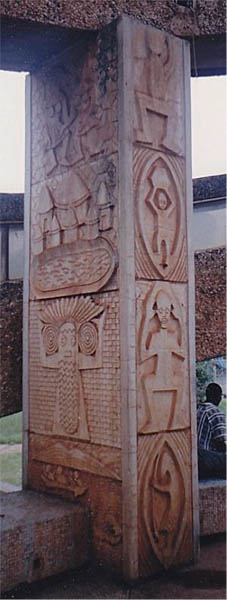
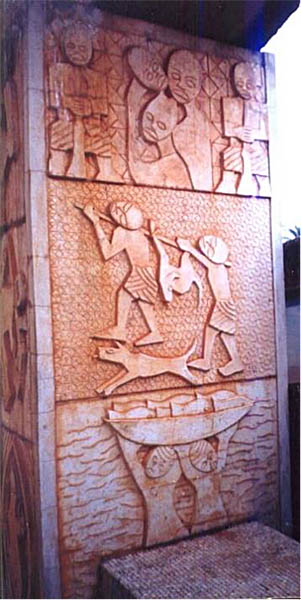
Images: ASSAKO ASSAKO Paul-Henri. 2014. L’art au Cameroun du XXe au début du XXIe siècle : étude des expressions sculpturales en milieu urbain, thèse présentée et soutenue en vue de l’obtention d’un doctorat/Ph.D en Histoire de l’Art, UY1-Cameroun, p. 571.
Details of a pillar cladding representing the diversity in the Cameroonian regions: the cone-shaped architecture and an initiation mask of the Kounga from Cameroon’s West; the abbia motifs and the hunting scene characteristic of the forests on the South Cameroonian plateau and finally the fishing scene which recall the Littoral region.3
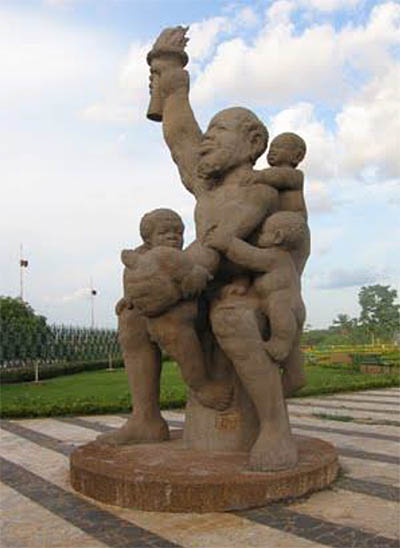
Engelbert Mveng and Atelier Arts Nègre (design, decoration in relief on the architectural structure), Armand Salomon (architecture), Mpando Gédéon (sculpture), 1973 -1976, concrete, H: 7m, Atemengue Plateau Yaoundé, Cameroon. Photo: Paul-Henri Souvenir ASSAKO ASSAKO
The sculpture by Gédéon Mpando that is situated in front of the spiral architecture reinforces the idea of a united nation as a foundation for development, fulfilment and prosperity in its own way. The artist has personified the nation in a figurative sculpture. The composition represents a stocky colossus (53 tons, height of 7m) in a seated posture of great stability. He holds a torch in his right arm while his left hand serves to support the four children who are clutched to him. The children’s visible efforts to climb up the colossus make for a strong vertical tension, echoing the cone-shaped architecture in the background. Mpando’s sculpture reveals a kind of serenity. Its strong expressiveness is due to a harmonious play of masses and volumes in the treatment of forms. Both artists’ contributions translate a vision of the nation that is both poetic and critical and as such essential to the development of a national society. Both components of the monument incorporate the idea of belonging to a nation that is united and hence display the most universal property that an image can acquire in such a context: its true ontological significance (H. Belting, 2004).
Let us come back to the relevance of this monument’s imagery. The inhabitants of the territory of Cameroon have inherited a common history of colonization. This history has forged socio-cultural, symbolic, emotional and political ties between ethnic groups. E. Renam speaks of these ties as the “fusion of populations” (1882). These links constitute the raw material of the national collective memory. It can be argued that it is worthwhile to overcome the obstacles to the consolidation of this nation due to the socio-cultural sedimentation of these ties. Disappointment with the promises of prosperity have resulted in calls to return to regional autonomy, be it in the form of a federal state or in the form of secession. Precaution needs to be preserved, however, because deconstructing the Cameroonian Republic constituted in the 1960s and 70s would imply calling into question the historical heritage, that Cameroon was born from the colonial system developed at the African conference in Berlin in 1884. The consequence would be the restoration of a precolonial environment. Instead, it seems more productive to critically analyse the historical stakes in favour of the development of today’s society.
Overview report on the current political situation in Cameroon (April 2021) - in German: Link https://www.bpb.de/internationales/weltweit/innerstaatliche-konflikte/327306/kamerun?pk_campaign=nl2021-04-07&pk_kwd=327306
References
- RENAN Ernest. “Qu’est-ce qu’une nation?” Bulletin de l’Association Scientifique de France. 26 March 1882.
- BELTING Hans. 2004. Pour une anthropologie des images, Ed. Gallimard
- BAHOKEN J.C. et ATANGANA Engelbert. 1975. La politique culturelle en République unie du Cameroun. Éditions Les Presses de l’Unesco.
- MVENG Engelbert. 1985., Histoire du Cameroun. tom 2. Yaoundé. Ed. CEPER.
- CHEICKH ANTA DIOP. 1079. nations nègres et culture, Ed. Présence Africaine
- SCHEMMEL ANNETTE. 2015. Visual arts in Cameroon - A Genealogy of Non-formal Training 1976-2014, Langaa Research & Publishing CIG, Mankon.
- ASSAKO ASSAKO Paul-Henri.2014. L’art au Cameroun du XXe au début du XXIe siècle: étude des expressions sculpturales en milieu urbain, thèse présentée et soutenue en vue de l’obtention d’un doctorat/Ph.D en Histoire de l’Art. UY1-Cameroun. p. 571.
- https://www.osidimbea.cm/collectivites/centre/monument-reunification/
- www.mbogliaa.com
Footnotes
1) The expression ‘boundaries of ancestors’ refers primarily to the idea of traditional cultural heritage and its appropriation for planning the prosperity of the nation.
2) https://www.osidimbea.cm/collectivites/centre/monument-reunification/
3) Source of images: ASSAKO ASSAKO Paul-Henri. 2014. L’art au Cameroun du XXe au début du XXIe siècle : étude des expressions sculpturales en milieu urbain, thèse présentée et soutenue en vue de l’obtention d’un doctorat/Ph.D en Histoire de l’Art, UY1-Cameroun, p. 571
published February 2021
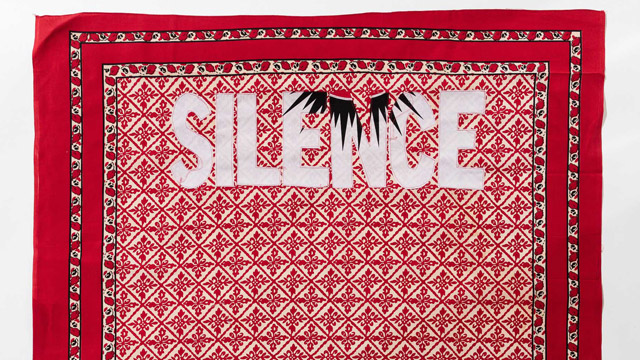
-
 Bernadette Van Haute
Bernadette Van HauteLawrence Lemaoana’s work, entitled SILENCE … FALLS (2017) consists of Kanga fabric with cotton embroidery, measuring 155 x 115 cm. Lemaoana is a South African black male, born in Johannesburg in 1982, who lives and works in Johannesburg. The work serves as an example of the ways in which young black artists in South Africa aim to express a specific South African identity which appeals to the global art world.
The use of Kanga fabric as medium is in itself very significant. Lemaoana states that: "Kanga fabrics [...] are used extensively in my work. Manufactured in the East, and brought to South Africa to be sold in markets and bazaars, the journey of the fabrics speaks of the idiosyncrasies and trade imbalances of globalisation. The textiles themselves though have a wholly different life in South Africa – they are regarded as significant markers of spiritual healing, imbued with great religious and spiritual power, used by diviners and fortune-tellers." (Afronova)
The Kanga cloth is “used specifically in Emandzawe rituals, both as clothing for the sangoma [diviner] performing the ritual and as cloth on the shrine inside the shrine room in which the ritual takes place” (von Veh, 2017, pp. 13-14). The use of this fabric thus establishes Lemaoana’s identification with both global culture and black African culture which does not belong to a mythical past but is still very much alive today. His own familiarity with the sangoma becomes clear when he maintains that the ambiguity of the traditional healer’s utterings parallels that of headlines in the news media. He also exploits the deeper meaning embedded in the three colours white, red and black to heighten the impact of his highly topical messages.
Lemaoana’s work is inspired by current socio-political events and the way in which they are reported in the local media. The composition Silence Falls evokes the #RhodesMustFall movement which began in 2015. This demonstrates the artist’s concern with the plight of the South African youth and his identity as an artist born in the 1980s – the so-called ‘born-frees’ who did not actually experience the ‘struggle’. The works of this generation of artists are described as “symptomatic of the new identity issues of the post-apartheid era. This young generation is appropriating a history that it believes has been confiscated and twisted in order to develop an alternative that takes into account its own subjective experience. Conscious of their responsibilities, these artists are helping to formulate and affirm a specific South African identity” (Pagé and Scherf, 2017, p. 8).
Lemaoana expresses his concern with socio-political issues through a critical engagement with mass media in South Africa. He is particularly concerned by the ability of the local media to shape social consciousness. By isolating news headlines and appropriating political slogans in his very own cynical way he “turns didactic and propagandistic tools on their head” (Afronova). As Lepage (2017, p. 117) states, Lemaoana uses the power of “words as favoured instruments in the political struggle”.
The importance of Lemaoana’s work is vested in his participation in the Fondation Louis Vuitton exhibition in Paris in 2017. The exhibition was divided in three parts; the first one was entitled Being there: South Africa, a contemporary scene and aimed to show South African vitality through the works of 16 artists. In the accompanying catalogue the curators Suzanne Pagé and Angeline Scherf (2017, p. 8) explained that their choice of artists was “based primarily on the action of the artists themselves, on their engagement with the current economic and social institutions, their awareness and conviction that they can act and play a role: BEING THERE”.
Interestingly the curators also comment on the fact that this younger generation of artists, in the context of ongoing economic and social divisions more than two decades after the end of Apartheid, sees it as its mission to transform “disenchantment into the energy for renewal” (Pagé and Scherf, 2017, p. 8). Achille Mbembe (2017, p. 16) elaborates on the current tensions in South African politics and culture which have led to a stalemate. In a society where consumption has become the quintessential state of being, the visual arts are in crisis, characterised by radical fragmentation and dispersion of reality (Mbembe 2017, pp. 23-24). “What is needed in contemporary South African arts”, writes Mbembe (2017, p. 24), “are concepts with which to seek out the real … . This will not happen without a new collective imagination that will help to facilitate the passage from the past and present to the future”.
This is what Lemaoana has achieved in his art. His participation in the show confirms his status as a contemporary South African artist who has managed to decolonise his art by “seeking out the real” and grounding it in a local or national context. Furthermore, in Lemaoana’s works there is no room for, what Mbembe (2017, p. 25) calls, “tropes of pain and suffering” or the injuries inflicted “by the forces of racism and patriarchy” – tropes that are the characteristic traps of postcolonial discourse. His art is decolonised in the sense that all the resources of cultural and artistic modernity – both in terms of medium and narrative – have been mobilised in order to render itself more relevant to a modern Africa and a global humanity (Ekpo, 2017, p. 20).
References
- Afronova. http://www.afronova.com/artists/lawrence-lemaoana-2/ (accessed on September 19, 2017).
- Ekpo, D. (2017). Manifesto for a Post-African art. Unpublished keynote address presented at the SAVAH Conference, Tshwane University of Technology, South Africa, September 21 – 23, 2017.
- Lepage, A. (2017). Lawrence Lemaoana. In S. Pagé & A. Scherf (Eds.), Being there: South Africa, a contemporary scene (pp. 116-21). Paris: Fondation Louis Vuitton and Editions Dilecta.
- Mbembe, A. (2017). Difference and repetition. Reflections on South Africa today. In S. Pagé & A. Scherf (Eds.), Being there: South Africa, a contemporary scene (pp. 15-25). Paris: Fondation Louis Vuitton and Editions Dilecta.
- Pagé, S. & Scherf, A. (Eds.). (2017). Being there: South Africa, a contemporary scene. Exhibition catalogue. Paris: Fondation Louis Vuitton and Editions Dilecta.
- von Veh, K. (2017). Textual Textiles: Gender and Political Parodies in the Work of Lawrence Lemaoana, TEXTILE,1-19. doi: 10.1080/14759756.2017.1337381 (Accessed September 5, 2017).
published March 2020
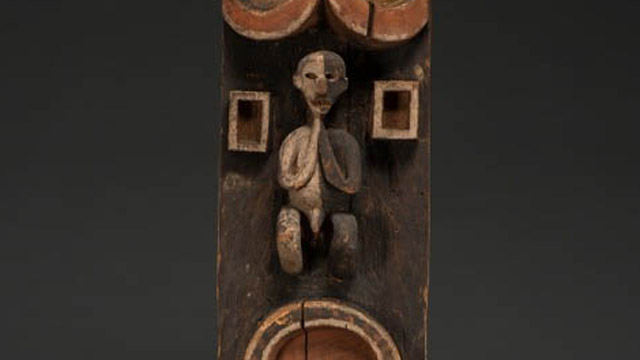
-
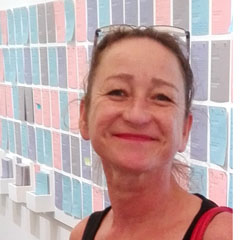 Karin Guggeis
Karin GuggeisObjects from the Global South in early collections of the Global North often lack any information about their specific local context. This is also true for this wooden sculpture made from a single block of hard wood, carved with different figures and forms on two sides and painted with natural colours in red, white and black. It was acquired in 1893 by the “Royal Ethnographic Collection” (Königlich Ethnographische Sammlung) in Munich, today the Museum Fünf Kontinente. No specific information about its geographic origin, its producers, users or use was documented in the inventory book. “Huge four-edged block, 1.80 high made of heavy wood, double-sided carved with human figures and lizards, heavily damaged by termites” is the only information recorded. The wooden block was sent from “Cameroon” (Kamerun) which is therefore documented as its region of origin. It was given to the museum as a present by Max von Stetten, a colonial officer in the German colony.
The post gained a new layer of significance through its inclusion in the almanac “The Blue Rider” (Der Blaue Reiter), one of the most famous and important publications on art in the early 20th century in the Global North. The almanac was edited in 1912 by two artists based in the environs of Munich, Franz Marc and the Russian Wassily Kandinsky. They designed the publication as a starting point for a new epoch of art, rejecting academic art and encouraging new forms of artistic expression. Thus, Kandinsky and Marc included reproductions of different non-canonical art forms, such as artworks from the Middle Ages, folk art, art made by children – and non-Western artworks, in those days called “art of the primitives” (Kunst der Primitiven), among them this sculpted block from Cameroon. In this way, the editors of the almanac aimed to break down the hierarchies between art forms from different times, regions and levels of professional skill, and to expand the canon of art in the Global North.
The editors’ fascination with non-European art had different roots: Wassily Kandinsky was a trained ethnographer and often visited ethnographic museums. Franz Marc, since his visit to the ethnographic museum in Berlin in 1911, especially admired sculptures from Cameroon. Thus Marc included a photograph of this wooden block to illustrate August Macke’s article “The Masks” (Die Masken). Marc captioned the picture simply “Cameroon” (Kamerun), its known geographic origin, and the country whose sculptures he admired.

Fig 1: Almanac "Der Blauer Reiter" (page 58-59)
In his article, the artist Macke stressed that for Africans their “idols” (Idole), as he called their sculptures, were a “visible expression of an invisible idea”, “a personification of an abstract term”. He also stressed the equality of the art forms from different times and regions. For example, Macke valued bronze works from the kingdom of Benin, in what is today Nigeria, and other ethnographic works, because they are just as expressive as a grave marker in the cathedral at Frankfurt. To demonstrate this non-hierarchical attitude to art from different regions and times, Marc and Kandinsky placed two photographs side by side on a double page in the almanac – on one side the Gothic figure of a knight, and on the other a bronze plaque showing a soldier from the kingdom of Benin, which also was in the collection of the Munich ethnological museum by then (Fig 1).
The later fame of the almanac, and of its publishers Kandinsky and Marc as artists, led to the wooden sculpture being named “The Blue Rider Post” in the narrative of the museum.
It is significant for global art history dominated by the Global North that, in contrast to our broad knowledge in respect of the European admirers of this object, very little is known about its original local context in the Global South. The state of our knowledge concerning its producer(s), its patron(s), its use, its specific place of origin, the meaning of special forms, colours, figures or gestures sculptured is poor. There are two reasons for this. First, in the Global North, there has been little interest in investigating its local context. Second, it is actually very difficult to carry out such investigations in respect of such badly documented early works in ethnological museums. To unfold these difficulties: the common method used to trace the local context of poorly recorded works is to look for stylistic similarities and ethnological background information concerning comparable objects in other collections or publications. Spending long periods doing fieldwork in the place of origin is too time- and money-consuming, as there are numerous badly recorded objects, especially in the early ethnological collections. Moreover, in the Forest region of East Cameroon, the assumed place of origin, there are numerous small ethnic communities which have been inadequately studied. Thus the poor results of previous research in the Global North are the following: The sculpted post is valued as unique in ethnological and art publications. Only single figures and their gestures show similarities with a few other objects in collections of the Global North. The current suggested origin of this carved work in view of these stylistic similarities is among the Lundu or Mbo people in the Forest region in East Cameroon. There it was probably used in a cult.
A new approach has been made possible by a provenance research project of the Museum Fünf Kontinente, funded by the German Lost Art Foundation and the Bavarian State Ministry for Science and Art. In collaboration with scholars from Cameroun and the presumed source communities, members of the project are exploring the provenance and the local context of this special Cameroonian wooden block, as well as the whole collection from the German colony of Cameroon donated by Max von Stetten to the museum between 1893 and 1896. Hopefully the blank sheet regarding the original context of this wooden block will be filled.
For comparison, also read Patrique deGraft-Yankson's analysis of this object here.
The post in the context of the the repatriation discourse: Link
References
- Eisenhofer, Stefan (2009): Kulthauspfosten (?). In: Bujok, Elke (ed.): Der Blaue Reiter und das Münchner Völkerkundemuseums. Staatliches Museum für Völkerkunde München, Hirmer, München. S. 16-18
- Erling, Katharina (2000): Der Almanach Der Blaue Reiter. In: Hopfengart, Christine (ed.): Der Blaue Reiter. Bremen, Köln. S. 188-240.
- Kecskési, Maria (1999): Skulptierter Holzblock. In: Kecskési, Maria (Hg.): Kunst aus Afrika. Museum für Völkerkunde München. Prestel, Munich, London, New York. S. 116.
- Kecskési, Maria (1982): Zwei beschnitzte Holzblöcke. In: Kecskési, Maria (ed.): Kunst aus dem Alten Afrika. Pinguin, Innsbruck. S. 238-239, 72.
- Macke, August (1912): Die Masken. In: Kandinsky, Wassily/ Marc, Franz: Der Blaue Reiter. Piper, Munich. S. S. 53-59.
- Marc, Franz and Kandinsky, Wassily (eds) (1912): Der Blaue Reiter. Piper. Munich.
published March 2020
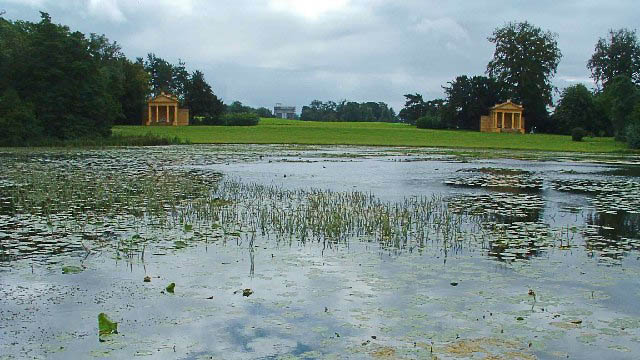
-
 Ernst Wagner
Ernst WagnerThe English Garden perceived as harmonious, lovely, picturesque or graceful to visitors in our present day, is charged with political resistance, struggle for power, projection of social utopias or flight into resignation. Like many interesting creations, these gardens are microcosms full of contradictions – particularly during the time they were created in the early 18th century: utopia and idyll, a mirror of society and its antithesis, dream and melancholy, imitation of nature and going beyond nature.
Stowe House Park, less than 70 miles northwest of London, is considered to be the first and most definitive site of an ‘English Garden’ – Lancelot Brown (1716 – 1783) who was employed there was the first person whose life-long occupation was that of a landscape gardener. The Stowe gardens embodied the ‘English Garden’ paradigm like no other and Benton Seeley’s guidebook (1742), the first garden guidebook to be published in the world, helped to spread Stowe’s influence throughout the 18th century as the model for the ideal English garden.As a country estate of the Temple family, it was – many decades before the redesign – first committed to Baroque, i.e. French models: symmetrically laid out, geometrized nature, combined with the pompous splendor of the manor building. The early model was abandoned and the new complex design of 26 hectares followed more innovative principles, for good reason; however, it still remained a status symbol of the wealthy family.
Thus the many buildings that were built in the park are demonstratively not Baroque. After all, Baroque embodied absolutism, which was despised. Instead, they were inspired by Renaissance, Gothic, antiquity, or Chinese architecture, pre-baroque styles or styles found geographically outside the borders of England. Each style tries to evoke its own mood: Gothic stood (and stands) for the morbid, the unearthly, China for the exotic, antiquity for the free citizenry.
In this sense, the names of the garden parts can be understood as allegories: Temple of Concord and Victory, Grecian Valley, Stauen von Saxon Deities (Germanic Deities) or Homer and Socrates, Gothic Temple, Elysian Fields and many others refer to cultural regions that represent a different, supposedly better social order. It is about an alternative concept to the absolutist principles, about freedom. The dedication inscription on the Gothic Temple makes this very clear: “To the liberties of our Ancestors”.
This directly decipherable political iconography is complemented by a differentiated iconology of forms. For example, the grass around the Temple of Ancient Virtue is subtly maintained as a lawn, while the grass around the ruins of ‘contemporary virtue’ grew wild until the ruins disappeared completely. The outdoors devours the contemporary, decadent, (neo-) absolutist tendencies. Thus nature was liberated from geometrizing corsets just as society was liberated from absolutism. As in free nature outside the garden with its unbridled forms, the garden becomes a free landscape in which free people move freely.
This conception of how such a landscape garden should look was influenced by three main sources: from the personal memories of nature that English nobility brought back with them from their Grand Tours through Europe; various descriptions of exotic Asian gardens; and, finally, from the classical landscape paintings by Ruisdael, Lorrain or Poussin.
Areas in the garden were designed for such three-dimensional pictorial stagings, which in Stowe featured over 90 selected scenes (or one might call them intriguing or harmonious compositions) that could be experienced from certain spots or areas in the garden. The visitor had to and has to set out to walk in order to experience all the spaces and perspectives along the way. Winding paths, which repeatedly open up to surprising glimpses of the unexpected, lift the visitor from everyday life and put him in a special mood. Hence, the course of the path is the central means of the landscape designer to develop his own dramaturgy. He steers the visitor and controls what he sees and when. What the visitor doesn’t see are typical walls. Instead the use of ha-has, a recess in the landscape similar to a sunken ditch, creates a vertical barrier while preserving an uninterrupted view of the landscape. The fine line between art and nature disappears.
The ever-changing weather, light and appearance of the plants, and the multifold of views along the way, allow the visitor to immerse himself again and again in an entirely new visual experience. This sensual experience should have a purpose. In the five-volume Theory of Garden Art by Hirschfeld, published 1779-85 in Leipzig, the aims are clearly outlined: On the one hand, the education of the observer through the enjoyment of art (“inner true cheering up of the soul, enrichment of the imagination, refinement of feelings”) and on the other hand, the “beautification of an earth which is our home for a time”. The aim is thus the refinement of nature by man as well as the refinement of man by nature.
The Temple family had initially acquired its immense wealth through sheep farming, and on the basis of its economic success it provided members of the English parliament for generations, including four prime ministers. English politics in the 18th and 19th centuries would be inconceivable without its influence. Richard Temple, 1st Viscount Cobham (1675 – 1749), who was a key figure in the founding of the park at Stowe, was initially a successful army commander in the War of Spanish Succession against France. In the early 18th century, however, as a supporter of the ‘Glorious Revolution’ (1688/89), which had led to the abolition of absolutism in England, he was marginalized by internal adversaries, which made the development of his garden so important for him.
In search of an aesthetic alternative to the ideologically rejected French garden (as the embodiment of absolutism), Chinese or Japanese gardens offered a central source of inspiration. William Temple had already published a book on Asian gardens in 1690. These gardens were above all a counter-model to the symmetrical arrangement of geometrically limited flowerbeds, the prototype of which was the park of Versailles. The irregular, free composition of trees, plants, stones, and water in Asian gardens was the model for a natural appearance that was as natural as possible and, in turn, created with the highest degree of craftsmanship, that is, artificially. In 1738, this enthusiasm for Asian gardens led to the construction of a Chinese house in Stowe – the first in garden history – an innovation that found its successors in many gardens throughout Europe.
Reference
Sibylle Hoimann, Garten; in: Fleckner U., Warnke M., Ziegler H. (eds.), Handbuch der politischen Ikonographie, Vol. I, München 2011 (Beck), pp. 388.
published January 2020
 Prudence Lau
Prudence LauAt the moment, I find it fascinating that such English and Chinese or Asian cultural exchange upon the built environment started so early on in the 18th century. It reminds me of the Chinese garden that focuses also on landscape, and an emphasis for reflection and escape from the outside world.
published January 2020
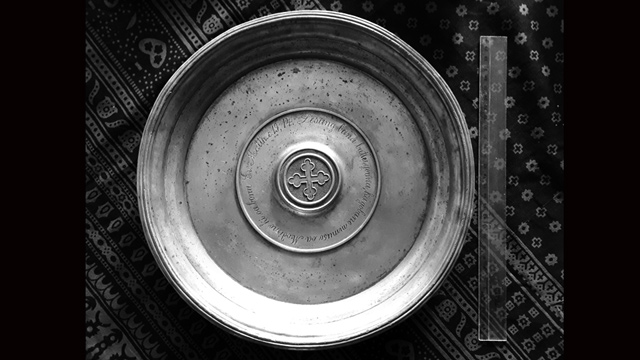
-
 Lize Kriel
Lize KrielA German bowl inscribed in Africa
In the process of finding out more about this baptismal bowl – where it comes from, who used it, and when it was discarded, it becomes a portal into South Africa’s contested past. Methodologically, a cultural-historical approach is taken to investigate the object as multiple signifier, not only as part of a transcontinental network, but also within a local, transcultural, context – what John and Jean Comaroff (1991, p. 200) referred to as the “long conversation” between European missionaries and African Christians.
The bowl was meant to be used with an accompanying, although, in this case, not quite matching, pitcher for the baptism ceremony, in which Christians use water to symbolise the blood of Christ washing away their sins. The Wallmansthal station where the bowl was found, was established by the Berlin Mission Society in 1869. The farm was about thirty kilometres north of Pretoria, today a capital city of South Africa. It became home to African converts gathered from the Kekana-Ndebele and several other pre-colonial northern Sotho polities (Van Rooyen, 1953, pp. 15-20). By the mid-twentieth century, the congregation was approximately 550 people strong (Schulze 2006, p. 456). Together with several other German protestant mission societies, the Berlin Mission contributed to the making of a Christian denomination referred to as “Lutheran” in South Africa today. After a century under white missionary tutelage, the African Church became independent as the Evangelical Lutheran Church of South Africa in the 1970s (Pakendorf, 2011, p. 115).
Knowing that a protestant congregation in Bochum, Germany, donated a church bell to the Wallmansthal Church in 1870 (Van Rooyen, 1954, p. 26), we can deduce that the baptismal bowl may also date from this era. The pitcher bears the mark of Gerhardi & Co. Judged from its Art Nouveau design elements and knowing that this Ludenscheid-based (Gerhardi) company was quite prolific in the production of cast pewter in the Jugendstil (Online Encyclopedia), a post 1890 manufacturing date seems equally probable.
Called Taufgeschirr (Baptismal dishes), bowl-and-pitcher sets of this kind are still being manufactured and used in churches in Germany today. Some congregations include images of old as well as new baptismal bowls on their websites as part of the material markers of their heritage. The exact same design displayed by the Evangelical Church of Illertissen in Germany on their website, is still in use today in the Evangelical Lutheran Church of Masealama (formerly the Kratzeinstein Congregation of the Berlin Mission Church) in South Africa’s Limpopo Province (Joubert, 2015).
Many baptismal bowls were inscribed with verses from the Bible. The quote on the Wallmansthal bowl is a contracted version of Matthew 19:14. What makes this bowl an exceptional object of transculturation, is the fact that its inscription appears in the early orthography of the local African language, Sepedi: “Lesang bana batle gonna, ka gobane mmuso oa Modimo ki oa bona” (NIV: “Let the little children come to me, … for the kingdom of heaven belongs to such as these”).
The bowl was used in church services on mission stations in the same way it would be used in protestant churches in Germany: the pastor would sprinkle the children of African Christians on the forehead with water which had been poured into the bowl from the pitcher. The initial African converts, however, were baptised as adults, only after proving that they had internalised enough knowledge of the Bible and convinced the white missionaries of their commitment to the beliefs and practices of Christianity (which, well into the twentieth century, remained entwined with Western ideas about civilisation).
To these converts, the baptismal bowl was symbolic of their ritual immersion into a foreign way of thinking, living and believing. And yet it was inscribed in their own language, invoking possibilities for cultural translation; for selective appropriation as well as for imbuing the alien culture with own interpretations, relating it to the indigenous and the familiar, and composing new meanings in anticipation of changing circumstances. The baptismal bowl is thus taken as reflective of broader processes of societal, economic and political reconfiguration brought about by the colonial encounter, but with an emphasis on African resilience.
On the site where the Wallmansthal baptismal bowl was used, these processes played themselves out in a series of extraordinary episodes that indirectly also related to broader world-political epochs: Up until the First World War, the Wallmannsthal land sustained an African Christian farming community. In 1936, as an attempt to address their post-war financial crisis, the Berlin Mission sold off a large section of the farm, giving the (exclusively black) African buyers full title deeds for their plots. Until after the Second World War, Wallmannsthal was a bustling African town giving its inhabitants the economic advantage of being close to job opportunities in Pretoria (Van der Merwe, 1987, pp. 69, 135).
In 1967 the Apartheid government forcibly removed all the inhabitants, including the Berlin Mission Christians who had still lived on the retainer of the farm where the Church and other mission station buildings were (Schulze, 2005, p. 458). Wallmannsthal then became a military base and arms depot for the South African Defence Force. During the late 1980s, with the Cold War still dictating international relations and South African whites slowly awakening to the need for political reform, the Defence Force contemplated the restoration of the site. These plans never materialised.
In the early twenty-first century, in a successful land claim, the Wallmannsthal farm was returned to the descendants of its early twentieth century owners. The restitution did not herald a final episode of utopian prosperity. Increasing demands on limited resources seem to be one of the reasons for the reinstated landowners’ current challenges, ranging from obtaining municipal infrastructure, to addressing the status of illegal squatters on their land, and designing the best possible ways of yielding a sustainable livelihood for an increasing population (eNCAnews, 2018).
Today the Evangelical Lutheran Church of South Africa is but only one of several Christian denominations in South Africa with missionary roots. Many more South Africans belong to African independent or African initiated churches – and, increasingly, international churches with their roots elsewhere in the Global South. The process of inscribing Christianity with own meaning and local significance, continues.
References:
- 925-1000.com (2018). Online encyclopedia of silver marks, hallmarks and maker’s marks. Retrieved from https://www.925-1000.com/silverplate_G.html.
- Comaroff, J & Comaroff, J. (1991). Of revelation and revolution. Christianity, colonialism and consciousness in South Africa I. Chicago: Chicago University Press.
- eNCAnews (2018, 27 October). Pretoria land claims. Retrieved from https://www.facebook.com/eNCAnews/videos/pretoria-land-claims/302862580316147/
- Evangelische Kirchengemeinde Illertissen (2019). Die Taufe. Retrieved from https://evang-kirche-illertissen.de/informationen/taufe/
- Gerhardi (2019). Gerhardi – Ein innovatives Traditionsunternehmen. Retrieved from http://www.gerhardi.com/index.php?id=9&L=0
- Joubert, A. (2015). A journey into the life of a mission-ethnographer. doi: 10.6084/m9.figshare.1375528
- Pakendorf, G. (2011). A brief history of the Berlin Mission Society in South Africa, History Compass, 9/2, 106-118.
- Schulze, A. (2005). “In Gottes Namen Hütten Bauen“. Kirchlicher Landbesitz in Südafrika: Die Berliner Mission und die Evangelisch-Lutherische Kirche Südafrikas zwischen 1834 und 2005. Stuttgart: Franz Steiner.
- Van der Merwe, W. (1987). Die Berlynse Sendinggenootskap en Kerkstigting in Transvaal, 1904-1062. Pretoria: Government Printers.
- Van Rooyen, T.S. (1953). Kronieke van Wallmansthal I, Pretoriana: Journal of the Old Pretoria Society 4, 15-20.
- Van Rooyen, T.S. (1954). Kronieke van Wallmansthal III, Pretoriana: Journal of the Old Pretoria Society 2, 24-28.
published February 2020
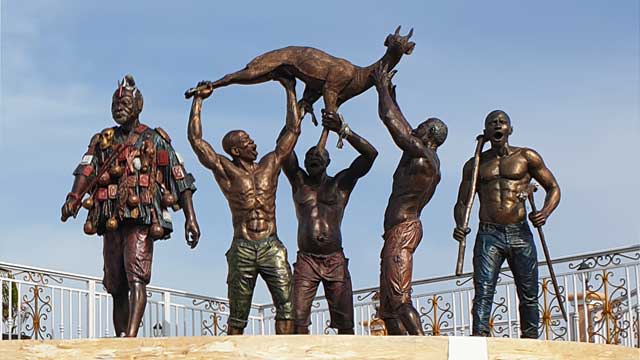
-
 Ebenezer Kow Abraham
Ebenezer Kow AbrahamTheophilus Kwesi Mensah and the Placemaking Paradigm
Within the rebranding and the making of new identity for Winneba as enshrined in the Effutu Dream Project, the name Theophilus Kwesi Mensah cannot be overlooked in this intercourse. This is not only because he engineered the widely talked about installations: the Unity Monument, The Aboakyer Monument, The Fishermen of Akosua Village and the Monument of Ofarnyi Kwegya but the awe-striking aesthetical connotations he incorporated in the aforementioned works. Each of these statues were rendered to mimic the idea of Winneba as a community built on a collective space. Being native of Winneba, heightened his understanding of how the amalgamation of economic, political, and cultural activities in the past, would accord him the impetus to express himself publicly. In so doing, he empowered his sculptures to ventriloquy the unique narratives that define Winneba and redefine this relatively old settlement yet burgeoning municipality as a dwelling place or a place worth visiting.
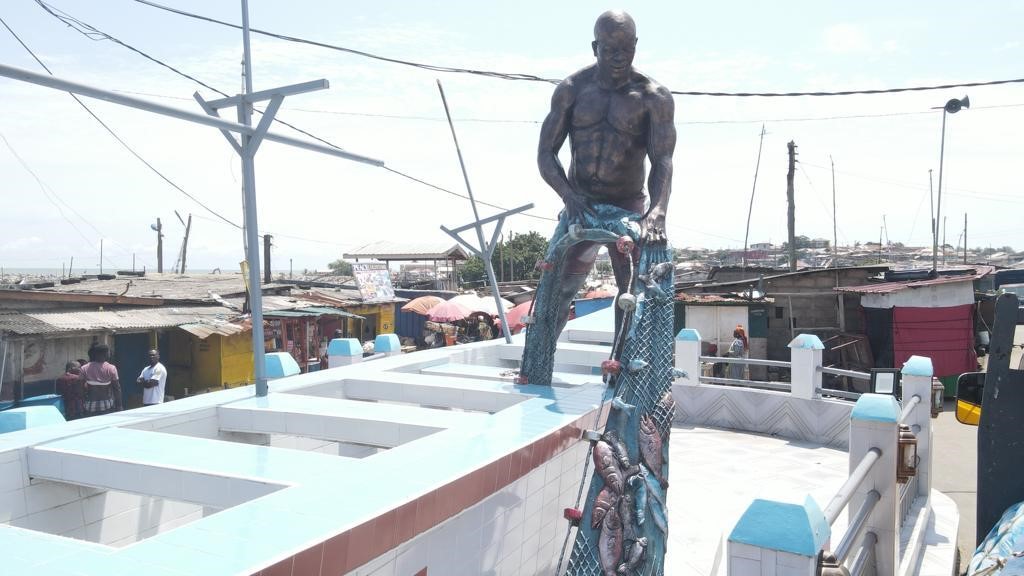
Figure 1: Theophilus Kwesi Mensah, Ofarnyi Kwegya, 2021. Fibre Reinforced Polymer. Yeepimso Community Centre, Winneba. Courtesy of Edem Dedi Photography.
Through the lens of placemaking, Ofarnyi Kwegya (Figure 1) and the Fishermen of Akosua Village (Figure 2) are two typical statues that has beautified the vernacular space of two historical settlements in the older southern half of Winneba.
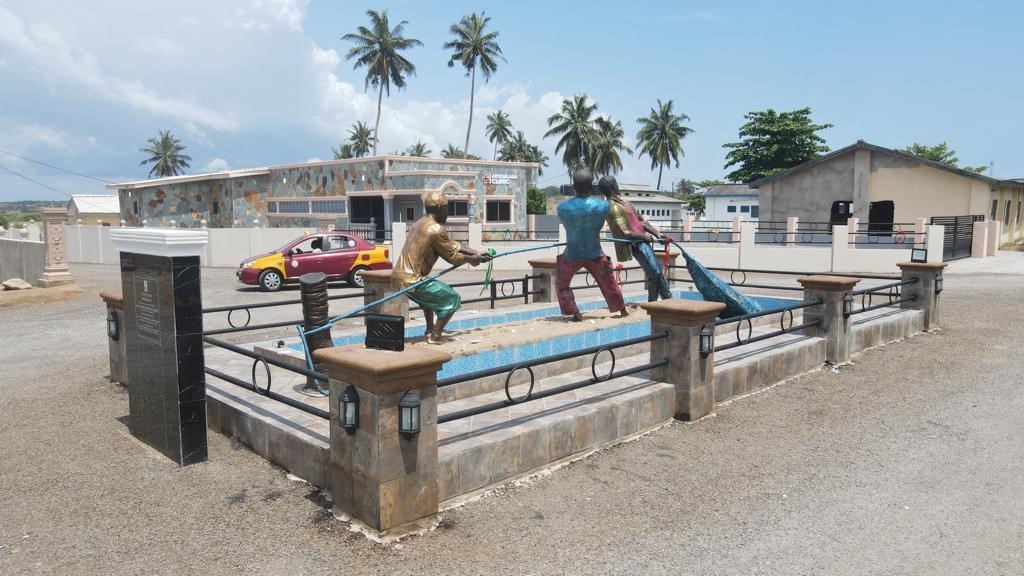
Figure 2: Theophilus Kwesi Mensah, Fishermen of Akosua Village, 2021. Fibre Reinforced Polymer. Akosua Village Community Centre, Winneba. Courtesy of Edem Dedi Photography.
The two statues stand in the middle of Yeepimso and Akosua Village communities respectively as embodiments of vital ingredients helping in creating a sense of community, civic identity, and culture in both spaces. They have both transformed their unique sites as lively and attractive communities with the monumental figures not just becoming legible maps to the sites but turning the spaces into places that support human interactions. The site of the statue has become the most important and attractive places in the two communities. They have become the center of attraction where the community gather for entertainment and trade, especially at night when economic activities in the two communities are at their peak.
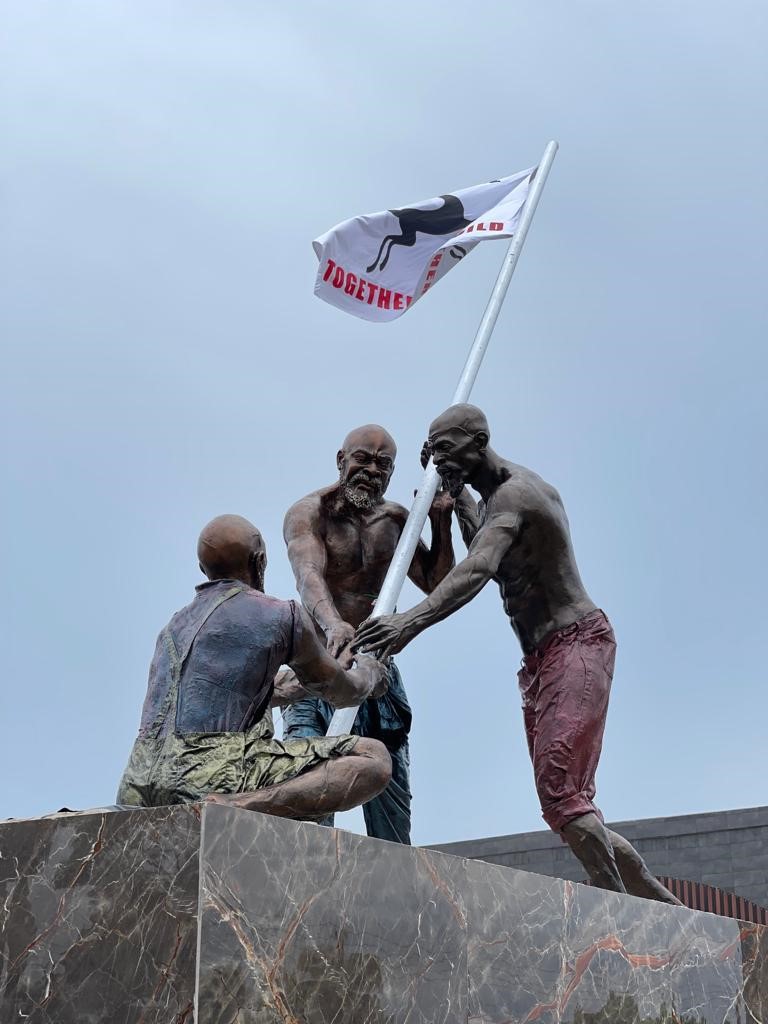
Figure 3: Theophilus Kwesi Mensah, Unity Monument, 2021. Fibre Reinforced Polymer. The Unity Square, Winneba. Courtesy of Edem Dedi Photography.
Another compelling monumental statue that has transformed the landscape of its site is the Unity Monument (Figure 3). Before the advent of the monument, the site of the statue (the Y-intersection – Winneba Traffic Light) was a deserted barricaded mere chaparral which displayed all forms of notices including obituaries and political posters (Mensah & Abraham, 2022). Yet, Theophilus Kwesi Mensah’s statue has transformed the space into an ideologically charged space for a deliberative unity and peace agenda in Winneba. The environment is so aesthetically pleasing that people like to visit the site for selfies and sightseeing thereby generating income for the Municipal Assembly.
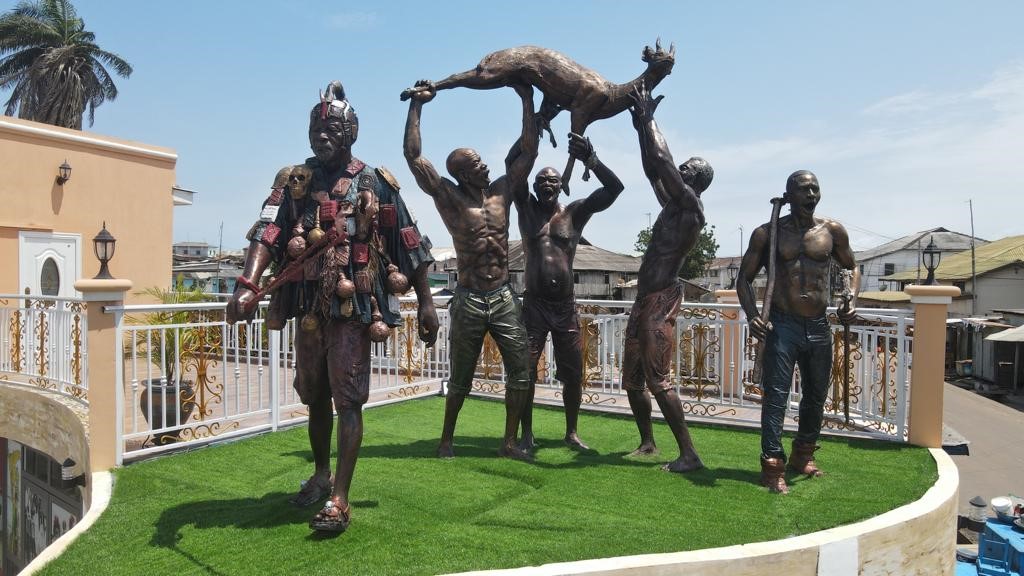
Figure 4: Theophilus Kwesi Mensah, The Aboakyer Monument, 2021. Fibre Reinforced Polymer. Osimpam Museum, Winneba. Courtesy of Edem Dedi Photography.
Theophilus Kwesi Mensah’s ontological orientation of Winneba is multifaceted. Hence, he found significance in the century’s old festival of the people of Winneba, Aboakyer to sculpt a monumental statue to this honour (Figure 4). The Aboakyer Monument mounted on the roof-top of the Osim Pam Museum is at the heart of Winneba as an embodiment of Winneba’s heritage. Owing to the enormous narratives surrounding the Aboakyer Festival, it is seen as one of the most popular and most significant festivals in Ghana (Akyeampong, 2019). The people of Winneba are invariably identified by the Aboakyir Festival. Theophilus Kwesi Mensah captured the very essence of the festival by vividly depicting the most significant characters: the Supi, the Asafo warriors, and their cheer leaders in procession with the catch.
During the 2022 Aboakyer Festival, it was observed that both celebrants and tourist were awe-struck by the aesthetic connotations of the monument. People gathered around the site for various reasons. Whilst some were seen taking tourist photos, others were seen venerating the ancestors who in the past led the festival.
In view of the Effutu Dream Project, Theophilus Kwesi Mensah’s artistic ingenuity to a large extent has contributed to rebranding the Winneba Township by beautifying the place and making it attractive for tourist. However, beyond the beautification agenda, part of the underlining philosophy of the statues was to consciously bring to the fore, some compelling memories of Winneba in relation to the current narratives within the land.
Theophilus Kwesi Mensah and the Collective Memories of Winneba
Theophilus Kwesi Mensah capitalized on his creativity to translate some notable historical events pertaining to his beloved native, Winneba into tangible remnants of the recent past to shape and, indeed, consolidate the Effutu Dream Project. Whilst usurping a storyteller, he equipped his statues to mimic the historiography of Winneba as collective memorials for the publics of Winneba. This is underpinned by his inclination to the truism that cities are built based on their histories and for that matter, Winneba cannot be gentrified without laying claims to the past publicly. Therefore, he ensured that whilst the Effutu Municipal Assembly initiated the Effutu Dream Project, the glorification of the public triumphs of Winneba was not taken for granted. This desire culminated into transforming some important public vernacular spaces into storehouse of memories embedded and inscribed on the landscape of Winneba.
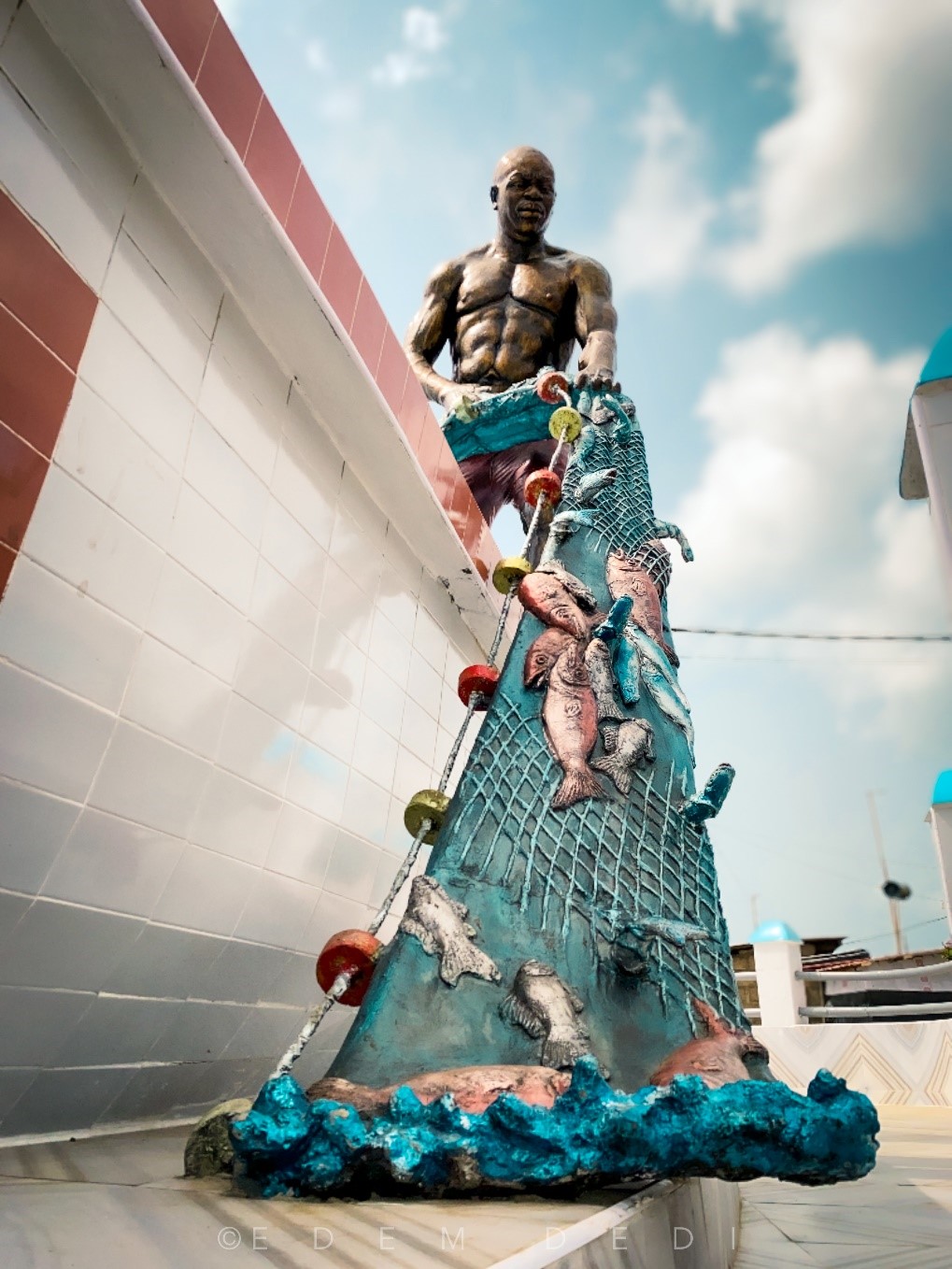
Figure 5: Theophilus Kwesi Mensah, Ofarnyi Kwegya, 2021. Fibre Reinforced Polymer. Yeepimso Community Centre, Winneba. Courtesy of Edem Dedi Photography.
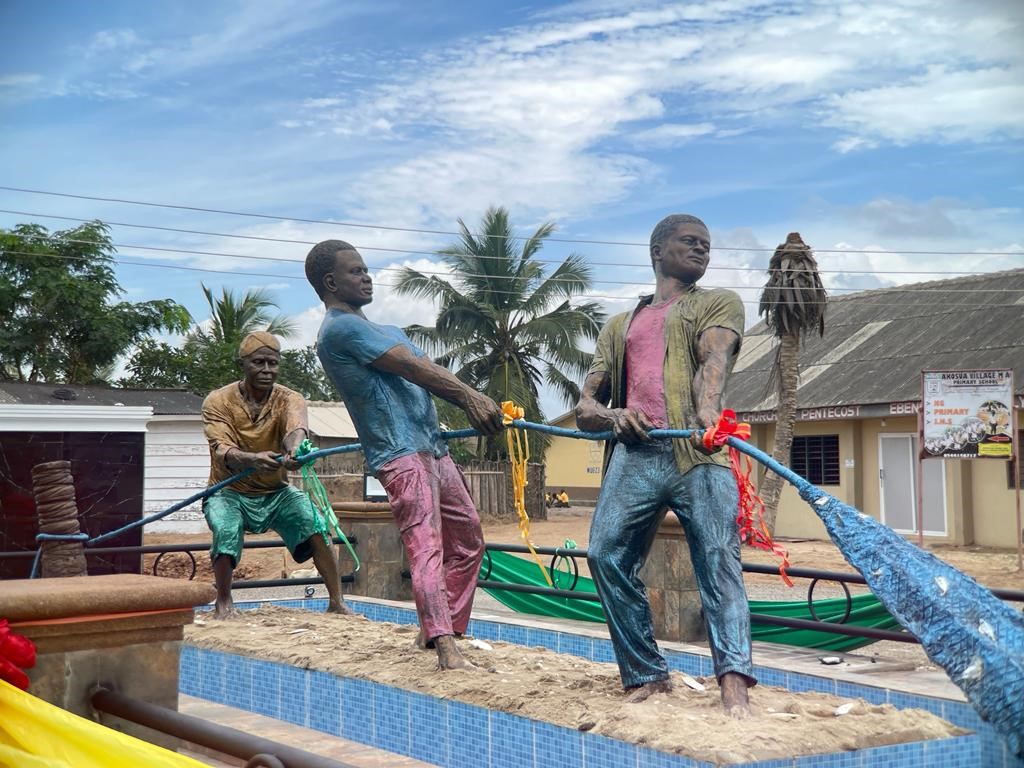
Figure 6: Theophilus Kwesi Mensah, Fishermen of Akosua Village, 2021. Fibre Reinforced Polymer. Akosua Village, Winneba. Courtesy of Edem Dedi Photography.
Knowing Winneba traditionally as a fishing community, Theophilus Kwesi Mensah produced two major monuments, Ofarnyi Kwegya (Figure 5) and the Fishermen of Akosua Village (Figure 6) as a concretized instantiation to the noble trade that has in the past defined what place Winneba is. Ofranyi Kwegya, is the statue of the unheralded giant master fisherman, an exponent of mid water trawling in Winneba who captured huge number of fish whereas the Fishermen of Akosua Village depict the famous trio: Zagada Afadzinu, Kwami Akpade and Sogbka Dagodzo who introduced artisanal fishing or subsistence fishing to Winneba.
Although the fishermen portrayed in these monumental statues have died long ago, they constitute such significant heroes in the historiography of Winneba. In view of their important roles in the socio-economic phenomenology of Winneba, Theophilus Kwesi Mensah aimed at stopping their decay and position them into the realm of the timeless with the erection of their statues as memorials that transmit their archetypal narratives.
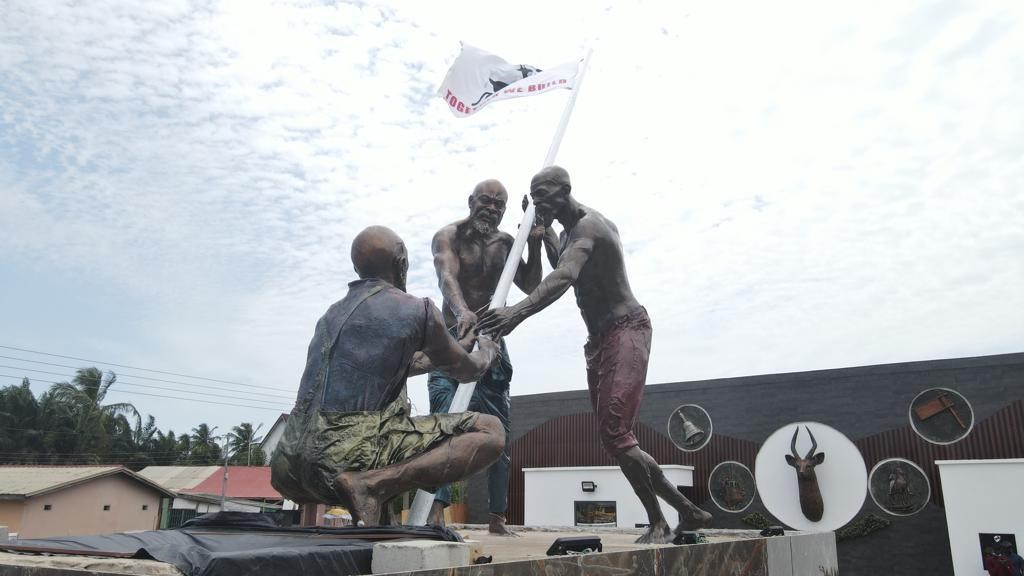
Figure 7: Theophilus Kwesi Mensah, Unity Monument, 2021. Fibre Reinforced Polymer. The Unity Square, Winneba. Courtesy of Edem Dedi Photography.
In view of Theophilus Kwesi Mensah’s understanding of the political and dynastic heritage of Winneba, he engineered the construction of the Unity Monument in commemoration of the end of the protracted chieftaincy feud that had ensued in Winneba in the past. Ephraim-Donkor (2019) recount that since the latter part of the nineteenth century, the people of Winneba have clashed in violent struggle for power until 22nd July, 2015 when the Supreme Court of Ghana, finally intervened. The feud was rooted in an uncanny clash of cultures within the same family three, resulting in a political quagmire as to which succession mode to follow, the male or female model. The people of Winneba traditionally follow the patrilineal line of succession, however the Acquahs who are for the female model, tasted power as caretakers but refused to cede power back to the original benefactors, the Otuano Royal Family (Gyatehs or Gharteys) who are for the male model.
The female model became popular in Winneba because of their hospitality which allowed their Akan neighbours to live with them and rendered Winneba as a cosmopolitan community. Theophilus Kwesi Mensah’ depicted the two families, Gharteys and the Acquahs and a third figure representing the non-natives as a united force in the gentrification of Winneba as they erect a flag as signifier to this commitment. The Unity Monument does not only exhibit an aesthetically astute display of Theophilus Kwesi Mensah’s artistic ingenuity but also, it encapsulates the political and dynastic history of Winneba whilst being a crucible of memory to the unity and peace in Winneba presently.
As part of Theophilus Kwesi Mensah’s memorialization agenda with regards to his statues in Effutu Dream, he produced the iconic Aboakyer Monument as a memorial to the Aboakyer Festival of the Effutus of Winneba. The Aboakyer, known throughout Ghana as the "Winneba Deer Hunting Festival," is held annually in early May. It commemorates the founding of Winneba some three centuries ago, when the Effutu, led by one Osim Pam and accompanied by the god Penkye Otu, settled on the coast at the end of their migratory journey from northern Ghana to the present location.
Pedagogical Connotations of Theophilus Kwesi Mensah’s Statues in Effutu Dream
As artist academic, having been under the tutelage of the Emancipatory Art Teaching Project (EATP) by Professor kąrî’kạchä seid’ou, he is an alley of the blaxTARLINES community in Kumasi. Theophilus Kwesi Mensah’s practice ties in with contemporaneity in the arts. In his teaching, he identifies with the philosophy that trainee art educators ought to think and act creatively. He does this by championing their epiphany in the studio as nexus of exploring emerging issues in art education. Through the studio, his statues in Effutu Dream creatively imparts on his students as agents of transformation in addressing the urgent call for equity, diversity, and inclusion in our educational structure and practices.
Whilst his students have the liberty to choose their own masters, he has been readily available, and the doors of his studio was opened to all students who loved art whilst working on his statues in Effutu Dream. After all, he too has absorbed lessons from legendary Ghanaian Artist Academics such as Benjamin Menya, Kwamevi Zewuze Adzraku and Buckner Komla Dogbe. So, students with varied backgrounds are mainstays in his studio beyond the statues in Effutu Dream. He reckons the studio space as a crucible of intellect and a window to add to knowledge as his students pick his brain as apprentices there.
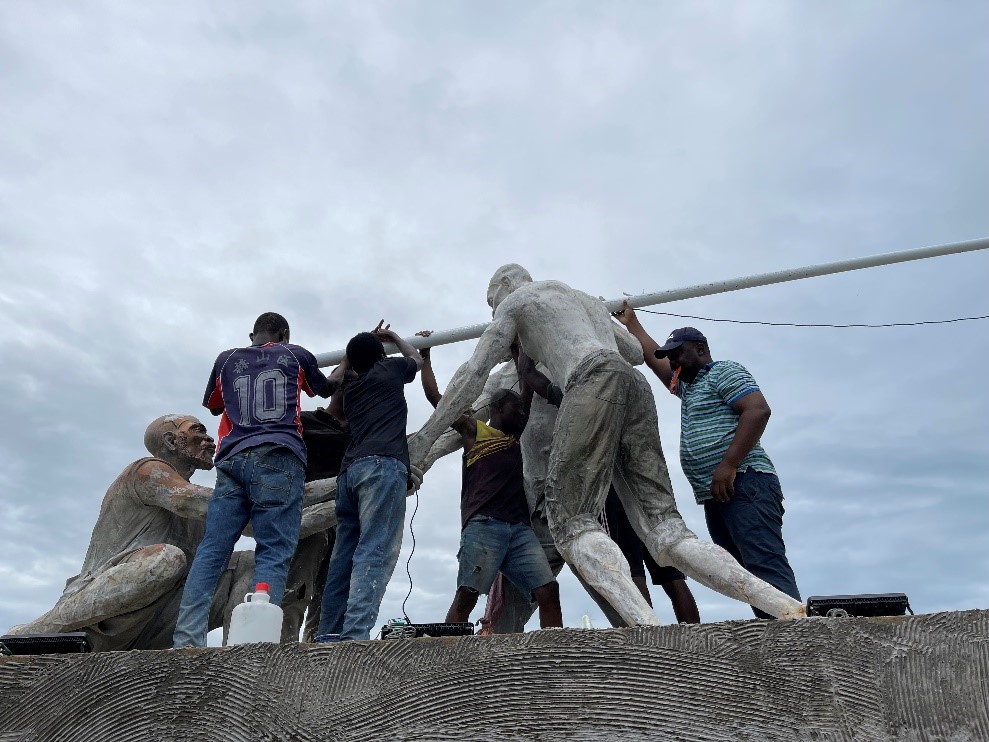
Figure 8: Theophilus Kwesi Mensah working with his students (Courtesy the artist)
Despite his inclination to EATP, he does not sway from being a traditionalist in the sense that he continues to enjoy working from the human figure. His preference to the human figure in his statues in Effutu Dream was informed by the truism that life changes and the language of sculpture evolves. So, it does not really matter if he is being repetitious with a subject that has preoccupied sculptors throughout history. Yet, as didactic symbols, he sought to make explicit what many sculptors make implicit in contemporary memorials in a classical sense with his figurative renditions.
Whilst the public may tend to be passive receptors of his statues in Effutu Dream, his students cannot afford to be indifferent. There are obvious educational imperatives they naturally cannot ignore. As far as they look and see the statues, there are predisposed to learn from them by asking questions. Reis (2010) citing Silva (1984) concerning public art claimed that even if we do not pay any attention to it, daily contact influences our attitude towards the conservation of artworks and our intellectual and sensory appropriation of them. What more do students need to get motivated in their studies aside having the opportunity to see the works of their lecturer installed all over the community? As artist academic, Theophilus Kwesi Mensah thrives to integrate his vast knowledge in the art into the practice of cultivating artistic design talent. His contribution to knowledge is application oriented. His statues in Effutu Dream make meaningful contributions to practical solutions that are at the core of art education. His students garner the nuances of what he says in the classroom when they see his statues in town.
Conclusion
Theophilus Kwesi Mensah’s ingenuity as a sculptor, draftsman and an academician are undeniable, so too is his energy and prolific creative output in the wider Effutu Dream Project. Within a trilogy of paradigms, he displays a profound representation of Winneba as a beautiful place to live and work. He does so by immortalizing four important collective memories of the town whilst using Fibre Reinforced Polymer, a material that stands the test of time and exudes a sense of eternalness. In the process, his students tapped into his creative sense both at his studio and on site.
Whilst Theophilus Kwesi Mensah’s artistic praxis is eclectic, what I have sketched is a heuristic effort to describe his monumental contribution in the Effutu Dream Project in his beloved Winneba where he lives and practice as artist academic. The few details I have carved may at times be minor, but they add up to have a larger impact to his contributions in the effort to redesign and develop Winneba.
References
- Akyeampong, O. A. (2019). Aboakyer: traditional festival in decline. Ghana Social Science Journal, 16(1), 97.
- Farman J (2015). Stories, spaces, and bodies: The production of embodied space through mobile media storytelling. Communication Research and Practice 1(2): 101–116.
- Mensah, T. K. & Abraham, E. K. (2022, June). The unity monument: A hope of the end to the political quagmire in simpa. Paper Presented at The Creative Arts Conference, University of Education, Winneba, Ghana
- Reis, R. (2010). Public art as an educational resource. International Journal of Education through Art, 6(1), 85-96.

-
 Patrique deGraft-Yankson
Patrique deGraft-YanksonWe may be right to assume that the level of awareness just at a little over four years of its implementation should not be too alarming. However, analyzing such low level of SDGs awareness among a people a country whose president is a Co-Chair of the Eminent Group of Sustainable Development Goals Advocates in Africa leaves some cause to worry.
The good news however is that, not being directly aware of the SDGs in the way they have been blueprinted does not mean the people are insensitive to its calls and claims. The fact is that, most of the demands of the SDGs are already embedded in the culture and belief systems of the people, and I consider this as an important resource to deploy for awareness creation and enthusiastic implementation of the SDGs.
For the realization of UNs commitment to leave no one behind in the mobilization of the citizens of the world to achieve the 2030 agenda (UN, 2020) therefore, I am of the belief that efforts at linking the relevance of the 17 goals to cultural manifestations of the people should be highly considered. The image shown above is a demonstration of how various traditional symbols speaks to the SDGs in a language which is understood by the traditional Ghanaian. These symbols transcend language barriers and their meanings are inherent within their traditional belief systems, making the goals both physically and spiritually relevant to people.
The meanings of the symbols are as follows:
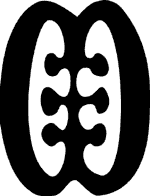
Ese Ne Tekrema (The teeth and the tongue)
Symbol of generosity towards one another. Through the formation of a linear relationship in diversity towards a common goal, both the personal and societal needs of the people will be realized.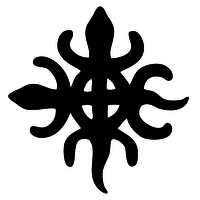
Funtumfunafu Denkyemfunafu (Siamese/conjoined crocodiles)
Symbol of brotherly feeling, caring and sharing. The society stays stronger when people coexist in the belief that we all smile and grow together when we feed and enjoy the good things in life together.
Dua Afe (Wooden comb)
Symbol of sanitation, cleanliness and beauty. This symbol reechoes the essence of physical and spiritual wellbeing through personal and environmental cleanliness.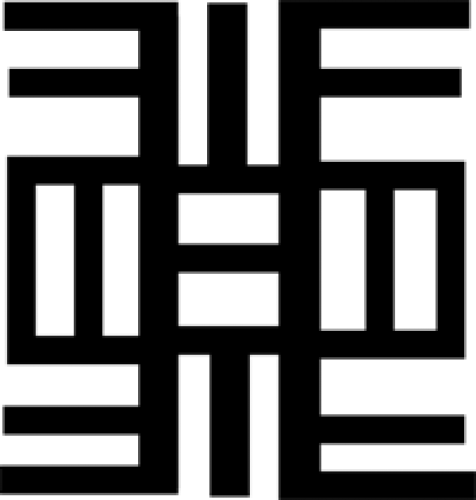
Nea Onnim No Sua a, Ohu (Anyone who does not know is capable of ‘knowing’ through education)
Symbol of educational opportunities. This symbol plays down ignorance by reminding people of their inert capabilities to get educated to any level of their preference. In other words, opportunities for quality education exist for all.
Obi Nka Bi (No one bites the other)
Symbol of equal regard, recognition and treatment for all. No one bites the other as a value ensures that all genders and age groupings have equal rights for existence in the society which allow them to listen and be listened.
Sesa Wo Suban (Change your life)
Symbol of deterrence and admonition towards all unapproved societal behaviors that affect the natural environment. This symbol represents strong advocacy for transformation and dynamic life patterns that affect nature. One of the unacceptable life patterns this symbol is currently addressing is the Ghanaian youth’s preference for wealth through illegal mining which destroys precious water bodies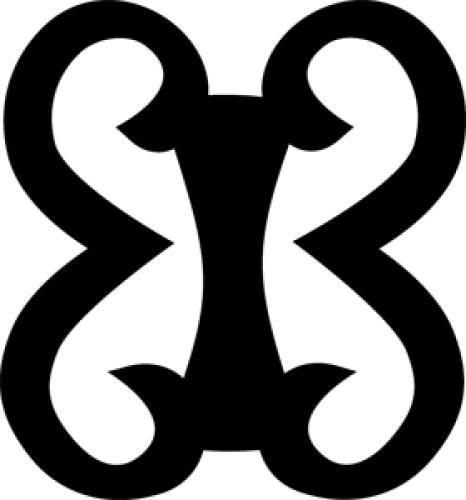
Pempasie (Sew in readiness)
Symbol of production and sustainability. This symbol emphasizes the importance of societal preparedness and readiness for the future through effective production and management of all resources for posterity.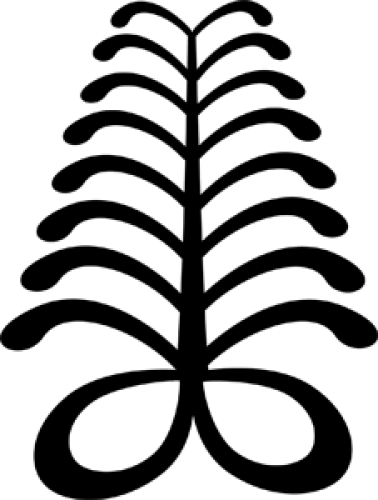
Aya (Fern)
Symbol of resourcefulness through resilience, self-reliance, hard work and judicious engagement of the environment and its resources.

Nkyimkyim (Twisting)
Symbol of collective action towards the building of the human society through initiative, dynamism, versatility, innovation and resilience. Indeed, building a successful society, like life itself, is not a smooth journey. The journey of life is tortuous and it requires a great amount of innovation and creativity to sail through.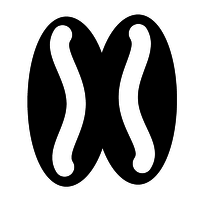
Nkonsonkonson (Chain)
A symbol of unity. This symbol, depicting two links in a chain, advocates for the need to heal the componentized society since in unity lies strength.
Eban (Fence)
A symbol of love, safety and security. The fence symbolically secures and protects the family from unhealthy activities outside of it.
Hwehwe Mu Dua (Measuring stick)
Symbol of examination and Self/Quality Control. This symbol emphasizes the need for circumspection in all human endeavors. It directs attention to self and quality control in everything including production and consumption. It admonishes against over consumption, over production and all forms of egoistic instincts and behaviors which adversely affect the general good of the society.

Nyame Biribi Wo Soro (God resides in the heavens)
Symbol of reverence to the heavens, the abode of the Supreme Being. Recognition to the ‘heavens’, or the skies as the residence of the supreme being is tied to the belief that all good things come from the heavens – rains, sunshine, fresh air, etc. The ‘heavens’ need to be respected for continuous flow of life-given goodies.
Ananse Ntentan (Spider’s Web)
Symbol of knowledge and wisdom about the complexities of life. This symbol alludes to the intricate personality of Ananse, the spider, a well-known character in Ghanaian/African folktales. In Ananse’s world, all facets of life need to be somehow manipulated, positively or negatively, for good or bad reasons. This sometimes led him to dire situation. Ananse therefore is a character for admonitions and reprimanding. Being conscious about the character of Ananse guides your steps against any unfair treatment to the world around you, be it the skies, on the land, in the waters or below the waters.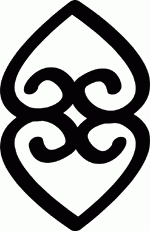
Asase Ye Duru (The Earth/Land is heavy)
Symbol for reverence and recognition to the providence and the divinity of the ‘Earth/Land’ and everything associated with it. The ‘Earth’ is the mother to everything. It carries the entire humanity, trees, water bodies, the sea (and what is in it and beneath it), big and small animals, etc. This why it is described as ‘heavy’. Respect/reverence to the Land is respect/reverence to life.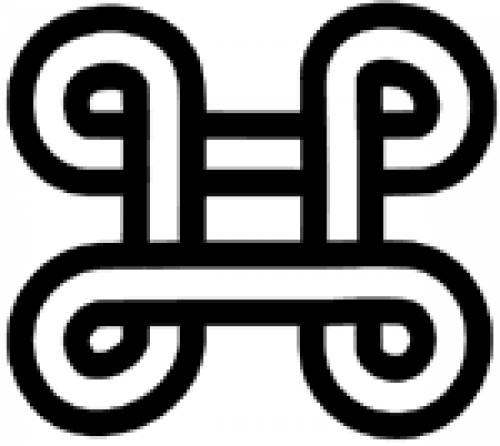
Mpatapo (Knot of Pacification/Reconciliation)
Symbol of bonding and adjudicatory factor which brings back parties in a dispute to a peaceful, harmonious and reconciliatory coexistence to ensure unified and strong societies and institutions.
Ti Koro Nko Agyina (One Head does not forma Council)
Symbol for partnership, collaboration and teamwork. This symbol emphasizes the importance of cooperation and collective efforts in the realization of all goals. Obviously, the attainment of the SDGs is a collective responsibility. No one nation (one head) can make it happen. It takes the concerted efforts of the entire citizenship of the world.Bibliography
- Adinkra Brand, A. (2020, November 15). African adinkra symbols and meanings. Retrieved from Adinkra Brand: https://www.adinkrabrand.com/blog/african-adinkra-symbols-and-meanings/
- Kasahorow Adinkra Library, K. A. (2020, November 15). Adinkra symbols and meanings. Retrieved from Kasahorow Adinkra Library: https://www.adinkrasymbols.org/symbols/nkyinkyim/
- United Nations, U. (2020, December 7). Sustainable Development. Retrieved from Uited Nations: https://www.un.org/sustainabledevelopment/development-agenda-retired/
published January 2021
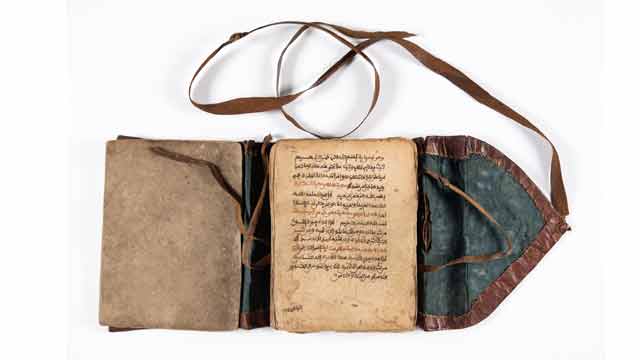
-
 Mahmoud Malik Saako
Mahmoud Malik SaakoThe Qur'an is typical for the time and the West African region in general. The idea originated in North Africa such as Morocco and Algeria. But the writing was later, influenced by the Hausa and Mande scholars in West Africa. The texts in this Qur'an are the same as the original from Arabia. But there are differences in the kind of calligraphy found in these Qur'ans and those found in Arabia. One important aspect of these Qur'ans is the calligraphy that comes after the beginning of a new chapter or Surah. Again, the use of red, gold and black colour in writing the Qur'an makes them unique.
Artistic features of the Qur'an
- The leather cover used to protect the Qur'an was designed with some relief using black ink. It shows that leather workers were very important in society. Similar covers are made but in a form of a bag for the Qur'an while others are wooden covers with a leather thong used to hold the wooden covers together with the Quran.
- The Holy Qur’an has Ayahs (words or verses) and Surahs (chapters). There is Bismillah before each Surah. The Qur'an has 114 Surahs or chapters.
- Calligraphy works in some portions of the Qur'an. Calligraphy as the art of beautiful, decorative writing has existed in Islam since the word of God, the Qur'an, began to be written. In West Africa which was known to the Muslim world as Bilad-al-Sudan (land of the blacks), Islamic calligraphy naturally came with Islam. They are just symbolic to honour the holy text.
- The use of three colours in writing such as gold, red and black: This shows how versatile the person was in giving an artistic impression of the Qur'an based on the Kanemi
- A large decorated sign known as shurafah (ennoblement) is written at the end of every fifteen hizb (that is the division of the Qur’an into parts and portions). This is done as a means of honouring the holy text. (See images below.)
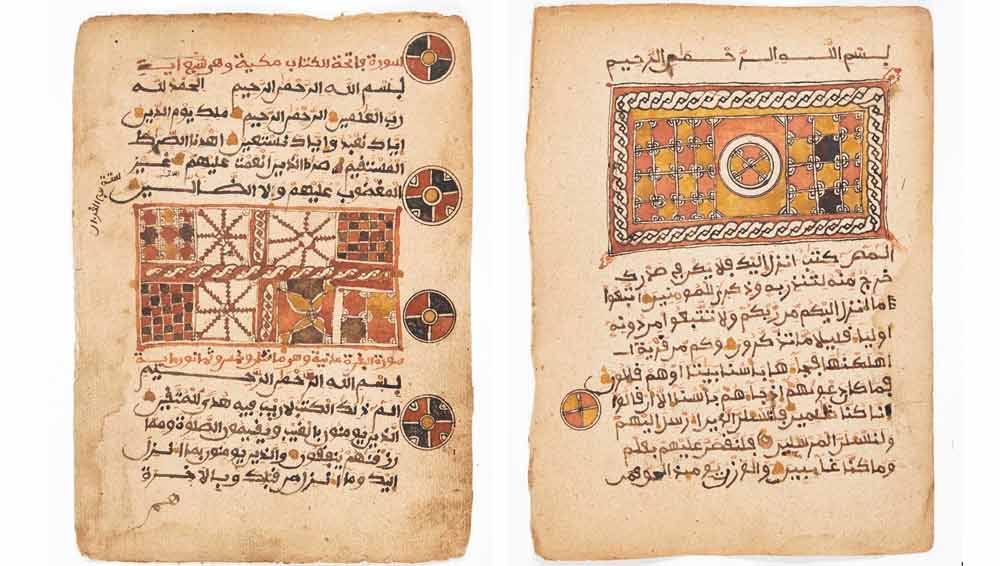
The shurafah or ennoblement at the beginning or end of a chapter (surah) is indicated in the two images. The gold, red and black colours are used to give it a splendid look. (Qur’an. 16th-17th century. Mossi in Togo. Museum Fünf Kontinente Munich. Courtesy Museum Fünf Kontinente. Nr. 20-3-1. https://onlinedatenbank-museum-fuenf-kontinente.de/detail/collection/b77d064f-c603-493c-af03-fc167f739586. [Stand: 08.08.24]. Photo: Nicolai Kaestner)
Material used for the Qur'an
The paper used is brown and a bit hard as compared to today’s paper used for printing. The ink is mixed in a variety of colours. There is jet-black ink that shines. Then there is a colour of black mixed with red and another colour which is neither black nor red. The ink is obtained through the following method. The roots of the desert date tree are collected and burnt into charcoal. This charcoal is then scraped into fine powder. The powder is filtered through a light piece of cloth. Water and gum Arabic are then added and the whole mixture is left to warm up in the sun. The mixture once prepared in this way gives out a very nice smell and its taste is very sweet.
Another method employed to produce the calligrapher's ink is to obtain the chaff of bulrush-millet (Pennisetum Spicotum), chips of the gum-yielding acacia (sieberiono), pods of the plant Egyptian mimosa (Acacia Arobico), slag from smithy and some bits of iron. All these items are then mixed with water. The mixture is filtered and boiled and once it is cooled it becomes ink. If the calligrapher wants a reddish colour or magenta colour imported dye of green or magenta colour is added. This type of ink is meant for the writing of the alphabet only and is always done in pure black. The ink is usually stored in small clay ink pots or small round gourds. The recent time, the ink is kept in small bottles.
What are the general specifics of these early Qur’ans?
The Qur'an is the holy text of the Islamic religion. In Islam, the Qur'an is believed to be the book of God’s words. The holy text remains sacred and unchanged since the beginning of time. The Qur'an is known as the most powerful text in Islam. Islam is a monotheistic faith and people of the religion take great pride in believing in pure monotheism. As followers of the Qur'an, Muslims must believe there is no one else besides Allah because Allah is the only one we worship sincerely, thus he is seen as the most powerful figure in the religion of Islam.
The Arabic text of the holy Qur'an in a book is known as the mus-haf (literally "the pages"). There are special rules that Muslims follow when handling, touching, or reading from the mus-haf. The Quran itself states that only those who are clean and pure should touch the sacred text. It is indeed a Holy Quran, a book well-guarded, which none shall touch but those who are clean... (56:77-79). The Arabic word translated here as "clean" is mutahiroon, a word that is also sometimes translated as "purified."
It was only Muslim believers who are physically cleaned through formal ablutions should touch or handle the pages of the Quran. Again, the Qur'an should be closed and stored in a clean or respectable place. Nothing should be placed on top of it, nor should it ever be placed on the floor or in a bathroom. Furthermore, when copying the Qur'an by hand, it should be legible with good handwriting. If you are reciting it you need to use a clear and beautiful voice. A worn-out copy of the Quran, with broken binding or missing pages, should not be disposed of as ordinary household trash.
Acceptable ways of disposing of a damaged copy of the Quran include wrapping it in cloth and burying it in a deep hole, placing it in flowing water so the ink dissolves, or, as a last resort, burning it so that it is completely consumed. But the translated Qur'an according to some scholars can be handled either by Muslims or non-Muslims.
Uses of the Qur'an
The Qur'an is meant for reading or recitation known in Arabic as taliwa. The recitation of the Qur'an is a highly honoured performance in Islam in which Allah blesses both the reciter and the listener. A person who memorizes the whole Qur'an is given the honorary title of a Hafiz (memorizer of the Qur'an). Again, the reproduction of the written Qur'an is as important as oral recitation. Two early calligraphic styles evolved in the writing of the Qur'an, Kufic (the more boxy, angular, heavy, and formal script) and Naskhi (the more elongated, rounded, cursive script).
The words in the Qur'an are regarded as the words of Allah and, therefore, handled with respect. Muslims also hold the view that some of the words contain mystical properties and as a result, Muslim religious scholars are sometimes consulted by people who have spiritual or psychological problems. They write verses from the Qur'an to ward off such evil spirits or for protection. The Qur'anic verses are often accompanied by diagrams drawn on a board and then washed off and given to the client to drink. As a result, these boards have high values based on the extent they have been used. It is believed that the older the board the more efficient it would be and vice versa.
At the Museum, there is one of the Qur'anic writing wooden boards that have verses from the Quaran on one side and diagrams on the other side. This board is brown and round at the base with a handle in a form of an animal beak. The surface is smooth while some old writing has remained and can be seen (see image below).
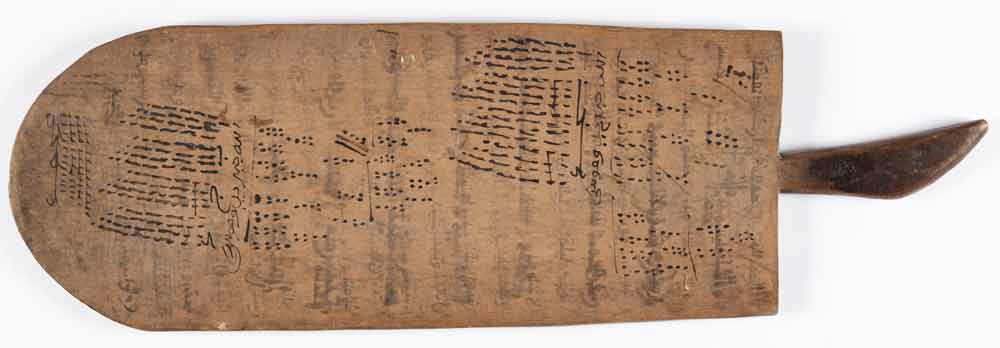
Board (Courtesy Museum Fünf Kontinente. Nr. 9-48. Photo: Nicolai Kaestner)
Where is the Qur’an kept?
Old Qur'ans were usually placed in two wooden covers before the use of leather cases or bags. It was easy to carry it once it was placed either in the wooden covers or in the leather bag. This is very important not to mess up the loose papers of the Qur'an. The two wooden covers after the Qur'an is placed and bound with a thong. There are two holes in the middle edge of the covers where the thong is passed through to bind the two wooden covers with the Qur'an. This method of bounding the Qur'an with wooden covers was practised during the early Abbasid period. Many of the early Abbasid manuscripts were copied into several volumes based on the Kufic script which was fairly heavy and not very dense. The Qur'ans of this early period were bound in wooden covers, structured like a box enclosed on all sides with a movable upper cover that was fastened to the rest of the structure with thongs. In this period, the Quran was arranged into 20 Juz or parts instead of the original 30 Juz during the Umayyad period. These wooden covers can be found at the Museum Fünf Kontinente (Inventar Nr 15-17-148).

Wooden cover of a Qur'an. Museum Fünf Kontinente. (Courtesy Museum Fünf Kontinente. Nr. 15-17-148. Photo: Nicolai Kaestner)
Appendix
When is it read and how?
It is read during the five daily worship by Muslims, at leisure times, during periods of hardship, during important occasions etc. However, in West Africa, it is read even at funeral celebrations. In many instances, the whole Qur'an is shared among those who can read, or the 30 Juz are shared among 30 people who recite or read it.
Islam in West Africa
Islam as a religion was revealed to the Prophet Mohammed in the 6th century in the Arabian Peninsula. Africa was the first continent into which Islam spread, from the Arabian Peninsula in the early 7th century. By the 10th century, the Berbers of West Africa were converted to Islam by their North African counterparts. It was the Berber Muslims who began to spread Islam into Western Sudan by the end of the 10th century through their trading activities. The Berbers of West Africa also converted some of the Manding-speaking traders to Islam, and they also began spreading it alongside their commercial activities. It was the Mande traders who began to spread Islam into many parts of West Africa through trading activities. The nature of Islam made it easy for the indigenous people to accept it as adherents were able to tolerate, to some extent, some of the local beliefs.
Later, the Hausa from northern Nigeria were also involved in the Kola-nut trade in the mid-15th century. The rulers of many of the Western Sudanese States encouraged the trans-Saharan trade and extended hospitality to both traders and visiting Muslim clerics. The most crucial factor in the diffusion of Islam into many parts of West Africa was the conversion of some of the rulers to Islam. Between the 14th and 16th centuries, many rulers of the Mali and Songhai empires were Muslims and performed the annual Islamic pilgrimages to Mecca to establish trade relationships with the Muslim world. It was during the era of European colonization of West Africa that led to the spread of Christianity among the locals.
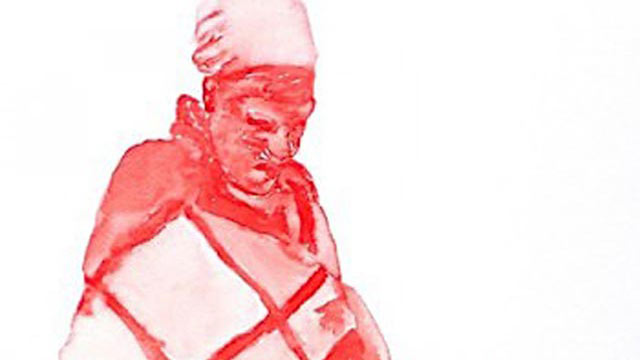
-
 Elfriede Dreyer
Elfriede DreyerOver the last three-and-a-half centuries, South Africa has experienced volatile and turbulent histories of a colonial, postcolonial and global kind. These brought on substantial nomadic movement of people, leading to political and social displacement, and hybrid identities. Since 1652, as a multifariously colonised country South Africa has shown cultural patterns of movement in and out of the country, and from place to place. The country is extraordinarily rich in mineral resources and gold, which has brought about massive wealth, but also instability. Johannesburg was established in 1886, due to the so-called gold rush, with fortune seekers and diggers flooding from all over the world to the country. Since then, the gold mines have attracted an influx of locals as workers, which contributed to much nomadism, but ironically – especially since 1948 during apartheid – such mine workers were allowed to work underground but once above ground they had to return to townships outside the large cities. During apartheid, non-whites or ‘people of colour’ were removed from the city and forcibly established in townships outside the city; they were only allowed as workers into the city; and had to carry passbooks (identity documents) on them all the time.
Such nomadic identity as a result of marginalisation and displacement is still presiding, but for different reasons since 994 and the end of apartheid. From this time onwards there has been a immense influx of people from all over the African continent to South Africa in search of greener pastures. Whereas during apartheid many intellectuals and people ‘of colour’ emigrated from the country, over the past two decades there has been an outflux of people due to a strong degree of political uncertainty and actions of political redress in the post-apartheid constitution, or to convicted beliefs of ‘not belonging’ to the new political dispensation.
Senzeni Marasela’s series of works entitled Waiting for Gebane (2015-2016) entails a continuation of her previous work, such as the embroidery series Theodorah in Johannesburg (2006) and Sarah, Senzeni and Theodorah come to Joburg (2011). In the latter works she explored her relationship with Johannesburg as city and experiences her mother had when she first arrived there. She used embroidery as technique and thread due to its associations of fragility, and conceptually she considered the issue of black women in migration to the cities. Theodorah was depicted as travelling to the city with the aim to finding out exactly what it is that has made many people disappear into Johannesburg. She is uncertain of what she is actually looking for. In the 2014 exhibition catalogue for Nomad bodies at the Wintertuin gallery of the Royal Academy of Fine Arts in Antwerp (curator: Elfriede Dreyer), Marasela stated that “I continuously return to the city, looking and relooking as it undergoes massive transformation. Having grown up in a catholic environment, penance informs a great deal of methods which are labour intensive. The city of gold is important as a transitory space: people go through the city, they come to the city and many dream of this city. There is something impermanent about this city, and it is precisely at this point that I began to write my own histories. The social climate of the city has never been favourable to the women that enter it. It is deliberate that I leave the city arid, without indications of lived experiences, as I seek to build the Johannesburg I can safely occupy.”
However, in Sarah, Senzeni and Theodorah come to Joburg the artist includes herself and Sarah Baartman also as nomads or pilgrims in the city. The three women’s plights are fundamentally different – Theodorah is on ajourney looking for her lost son Gebane; Senzeni is on her journey finding her foothold as individual, and colonial Sarah was displaced to Europe from the Eastern Cape– but they are one in their search for a place, recognition and restitution. They are each other’s doppelganger in their journey through the city of Johannesburg which forms the backdrop to the works. The metaphor of the rhizome is of particular interest to an engagement with nomadic identity in the context of a continent such as Africa. Already in 1987 Deleuze and Guattari (1987:7). coined the idea of rhizomatic being, stating that the “rhizome itself assumes many diverse forms, from ramified surface extension in all directions to concretion in bulbs and tubers”. Living on a vast continent, Africans are accustomed to long journeys; however, poverty, violence, civil wars, imperial infiltrations and oppression have resulted in a generalised nomadic condition where people are constantly moving and travelling in the search for a better life and even survival. However, in a wider sense, globally, Rosi Braidotti (2011:3) states that the nomadic predicament and its multiple contradictions have come to age in the third millennium after years of debate on the “’nonunitary’ – split, in process, knotted, rhizomatic, transitional, nomadic – so that fragmentation, complexity and multiplicity have become everyday terms in critical theory.” Braidotti has been engaged since the 1990s with the question as to what the political and ethical conditions of nomadic subjectivity are, grounded in a “politically invested cartography of the present condition of mobility in a globalized world” (Braidotti 2011:4).
Zygmunt Bauman (in Hall & Du Gay 1996:19) views the ontologies of nomadic identity as becoming critical when there is uncertainty as to where one belongs, a view that is crucially relevant to emerging urbanising African identity. `the figure of Theodorah can be aligned with the idea of the flâneur, which Bauman appropriates in his presentation of the stereotype of the pilgrim who as a stroller is on a teleological journey – ordered, determined and predictable (Bauman in Hall & Du Gay 1996:21). Comparing the contemporary world to a desert through its fragmentation, Bauman views it as being inhospitable to the notion of the pilgrim, being unable to leave a footprint in the sand. The forward march of the pilgrim (Theodorah) is equally compromised and in the context of the wind effacing footprints (of Gebane) and the rhythmical similarity of the desert environment, the pilgrim goes in circles (Bauman in Hall & Du Gay 1996:23). “The overall result is the fragmentation of time in episodes, each one cut from its past and from its future, each one self-enclosed and self-contained. Time is no longer a river, but a collection of ponds and pools” (Bauman in Hall & Du Gay 1996:25).
As in these afore-mentioned works, in the series Waiting for Gebane the artist’s mother is depicted as going from her rural environment to the ‘big city’, Johannesburg, in a search for her son Gebane who left for the city and never returned. She becomes a nomad in her searching ritual, but it is a dystopian journey, providing no teleological “good ending” and leading nowhere, since she cannot find him. The works depict a potent image of Africans searching for a better life elsewhere, but simultaneously failing in finding answers to their economic and other dilemmas. Waiting for Gebane explores cultural and artistic mappings of the social and political power geographies and complexities that dominate cities. Of pertinent interest here is how people’s decolonial transition from rural to urban contexts have been voiced, claimed, renegotiated and contested, especially in the context of capital cities as locations where there is a conflation of global and local influences. Mendieta (2001:15, 23) argues that cities have become the “vortex of the convergence of the processes of globalization and localization … [and] epitomes of glocalization, to use Robertson’s language (1994)”; and that the “city is the site at which the forces of the local and the global meet: the site where the forces of transnational, finance capital, and the local labour markets and national infra-structures enter into conflict and contestation over the city.”
In Marasela’s work, contemporary African identity is characterised by particular cultural histories, as well as by identifiable patterns of transitivity and how people construct their identities psycho-geographically. Dispossession of the embodied and embedded self is articulated so that the city and placelessness become sides of the same coin (Braidotti 2011:6). Braidotti (2011:7) argues that “The contrast between an ideology of free mobility and the reality of disposable others brings out the schizophrenic character of advanced capitalism”, which is nowhere more visible than in the political and social extremities in South Africa. Marasela’s work expresses the idea that meaning is created through the crossing of space and distance between bodies, or as Soja (1989:133) argues, “To be human is not only to create distances but to attempt to cross them, to transform primal distance through intentionality, emotion, involvement, attachment.”
New decolonised Identities emerge through movement through in the world and interfaces with alterity. Often, it is a sense of alterity or the attraction to the exotic other that produces nomadism. Waiting for Gebane thus presents the ambivalent Baumanian idea of the pilgrim-tourist who keeps going in circles, driven by a non-teleological sense of survival and looking for a better life, which might not lead to a ‘good ending’. Nomadic identity is essentially rhizomatic here, and in South Africa – also in an amplified sense on the African continent – the drive to belong and the utopian quest for a better life have resulted in identity being redefined, renegotiated, rerooted and sprouting in many directions.
Senzeni Marasela is a female South African artist of Zulu origin, born in Thokoza, KwaZulu Natal in 1977. She is currently completing a MA degree in Art History from Wits University (SA); she has exhibited widely in the national and international contexts; and she has been awarded several grants and residencies, for example from Devon Arts Residency (Scotland) The Ampersand Foundation and Axis Gallery in New York; The Thami Mnyele Foundation in Amsterdam; and the Kokkola Art Academy in Vasa. Her artist website is found at http://www.senzenimarasela.com.
References- Bauman, Z. ‘From pilgrim to tourist – or a short history of identity’. In Hall, S and Du Gay, P (eds). 1996. Questions of cultural identity. London/New Delhi/Thousand Oaks: SAGE.
- Braidotti, R. 2011. Nomadic subjects: embodiment and sexual difference in contemporary feminist theory. Second edition. Gender and culture: A series of Columbia University Press. New York: University of Columbia Press.
- Deleuze, G & Guattari, F. 1987 [1980, French original]. A thousand plateaus. New York: University of Minnesota.
- Hall, S and Du Gay, P (eds). 1996. Questions of cultural identity. London/New Delhi/Thousand Oaks: SAGE.
- Mendieta, E. 2001. Invisible cities: a phenomenology of globalization from below. City: analysis of urban trends, culture, theory, policy, action 5(1):7–26.
- Soja, E. 1989. Postmodern geographies: the reassertion of space in critical social theory. New York/London: Verso.
published February 2020

-
 Esther Kibuka-Sebitosi
Esther Kibuka-SebitosiRainbow Nation
The rainbow in the Bible given in Genesis 9:16 is a reminder that we have a covenant with God not to destroy the earth again by floods. “I set My rainbow in the cloud, and it shall be for the sign of the Covenant between Me and the earth,” says the Lord. God had made a covenant with Noah and his seed for generations. Genesis 9:9. And I, “behold, I establish my covenant with you, and with your seed after you”. Since we are all Abraham’s seed, we are covered in this covenant, although Jesus makes a better covenant in the New Testament. Returning to the rainbow nation, this covenant is saying “ no more destructions”. It is as if God is saying we should no longer fight each other but live together in peace. He made us all people with different colours (rainbow).
The metaphor describes a people with multi-cultures living together. The image of the flag is a symbol of togetherness or unity. The different colours. Adopted in 1994, the red, white and blue were adopted form the colours of the Boer Republic while the yellow, black and green were taken from the ANC (African National Congress) flag. The black colour is a symbol of the people; the green represents fertility of the land while the gold represents the wealth from minerals beneath the soil. The ANC adopted these colours way back in 1925.Associated with the flag is the national anthem. This is unique in that it has many languages:
- Nkosi sikelel’ Afrika
- Maluphakanyisw’ uphondo lwayo,
- Yizwa imithandazo,
- yethu,
- Nkosi sikelela,
- thina,
- lusapho lwayo.
- Morena boloka setjhaba sa heso,
- O fedise dintwa la matshwenyeh
- O se boloke (Ntate)
- O se boloke
- setjhaba sa
- heso,
- Setjhaba sa
- South Afrika
- – South Afrika.
- Uit die blou van onse hemel,
- Uit die diepte van ons see,
- Oor ons ewige gebergtes,
- Waar die kranse antwoord gee,
- Sounds to call to come together,
- And united we shall stand,
- Let us live and strive for freedom,
- In South Africa our land…
Songwriter: Cornelius Jacob Langenhoven
Summary
The Rainbow metaphor is characteristic of a nation that aspires for peaceful living; building a peaceful nation. The symbol taken from the Bible donating the Noahic covenant reminds us that God will no longer send the floods to destroy us.
The flag is a symbol of unity between the Boers and the African National Congress colours, which represents the whole of South Africa. It is a sign of hope and nation building.
Associated with the Flag and the Rainbow nation is the National anthem. It is written in many languages signifying the rainbow nation of multi-cultures.
References
- https://en.wikipedia.org/wiki/Rainbow_nation
- https://www.worldatlas.com/webimage/flags/countrys/africa/soafrica.htm
published January 2020
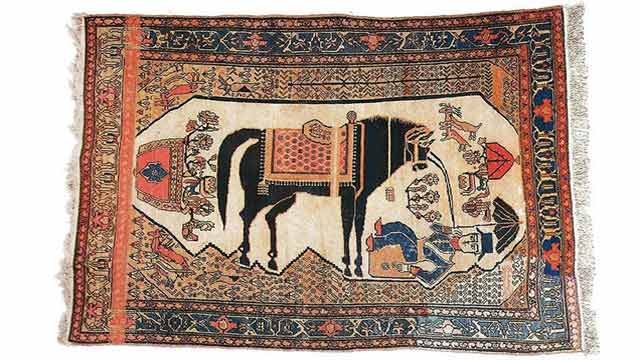
-
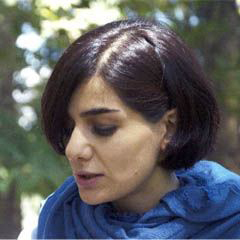 Azar Emami Pari
Azar Emami PariA carpet is neither produced nor read like other pictures. As such, how does it communicate and what is the proper way of reading a carpet? Does it enjoy an esoteric meaning? A meaning beyond that of its patterns? In other words: is the carpet a decorative object with a symbolic or iconic meaning added on top, or does it contain—at least for viewer who belongs to Persian visual culture—a meaning completely different from any other quotidian object? The mesmerizing power of the carpet lies in the fact that it convinces the viewer of the latter. Many studies on the subject aim at understanding how different Persian carpets are made, trying to elucidate the nature of their mode of production. Yet, “how the appearance is consumed”[1] has rarely been the subject of study, as well as inquiring about the causes behind the formation of such a bizarre appearance. It can easily be shown that the answer cannot be reduced to how a carpet is produced: it is clear that Persian carpets are more than, as it were, a pixelated version of Persian images found in other Persian decorative arts, or the product of a “design process” (as one understands the term today) and sheer creativity; it is rather an object unlike any other quotidian objects and not just another branch of fine or decorative arts.
It is very difficult to penetrate the different layers of meaning in a Persian carpet, at least much more so than Persian miniature paintings for example there is a winding path from form to meaning in carpets. A Persian carpet has something to say that is not a statement: it is not a text with a definitive meaning, not even one that we could call “abstract” in the sense of avoiding any reference to the real world. Similar to mystic verses of Sufis, known as shat-hiyyāt, whose general meaning is unclear to the reader, yet written down, with meaningful words, for a purpose clear to the author, the appearance of carpets insists on signifying something: they are not just pleasant melodies without words. As such, the carpet cannot be studied as an abstract painting. (Probably that is why it has rarely inspired modern Persian paintings and protects itself against easy visual plagiarism.) The image of a carpet is not the same as the carpet itself: the carpet is not produced to be “seen”, rather be “watched” in the long term. It is meant to be lived on, not to be distanced from the viewer to produce a moment of reflection, which is the essence of European painting. It is not an exaggeration to say that every Iranian grows up on a carpet and learns visual literacy from it. It is the very first window through which every Iranian look. The opposite of a Renaissance painting, i.e. a window opening to the outside world, is the carpet, not even the Persian miniature painting.
Despite its decorative function, the effect of Persian carpets, and in particular pictorial Persian carpets, on viewers do not depend on the text that accompanies it (as is the case with urban, fictional, pictorial carpets[2] and Persian painting alike). The origins of pictorial carpet have been, as it follows, purely aesthetical, nothing more.
Historically, pictorial carpets appeared as new art, not only because of a change in their function but also because of their new appearance[3]. They were woven according to the personal taste of weavers or specific clients, and for that reason, they were less mass-produced. There is no doubt that such carpets as Persian miniatures are ultimately born of the poverty of illustration[4] in Iran. Such carpets, also known as figural carpets, “emerged in the late twelfth century AH (18th century AD) following developments in various other fields of art in Iran and coincided with the emergence of new possibilities in the visual realm, such as printed pictures or photographs. All these led to a new expression in Persian carpet weaving.” (Tanavoli, 1989:9) The story narrations in the pictorial carpets of Iran have different origins. Themes of pictorial carpets include kings, epic and romance stories from classical Persian literature, religious themes and stories of Quran, dervish and Sufism, Armenians pictorial carpets, nomads’ pictorial carpets, pretty women, and animals.
In order to enter the realm of the Persian carpet, let us begin from a simpler point of departure. We ask: what is the relationship of the carpet to the space in which it is unrolled? What is the horizon of the carpet and what is space and time in the carpet? The objective form of such a relationship is reflected in the relation between the carpet and the architectural space. Of course, we have samples of carpets woven for a particular space, as well as spaces built to house a particular carpet. We know, for example, that Nasser al-Din Shah (who reigned from 1848 to 1896) ordered a complete building to be fitted with a carpet he received as a present from the Ottoman sultan. Mo’ayer al-Mamālek writes: “Abyaz Palace: Although the building is still in place, not everybody knows why it was built, therefore, some facts are mentioned here. Sultan Abdul Hamid sent dozens of pieces of furniture and some precious Turkish carpets to Nasser al-Din Shah. Several large portraits of European kings and queens painted by the most influential painters of the era were also given to Nasser al-Din Shah. As other palaces were all decorated with various ornaments and were not suitable for the aforementioned gifts, so the king ordered the Abyaz palace to be built and tailored to the size of the largest Ottoman carpet. When it was finished, they unrolled the carpet in the hall and decorated the space with precious upholstery. They hung the portraits together with another painting depicting Napoleon I, given to Fat’h Ali Shah, thus creating a magnificent hall for receiving kings and dignified guests. One day I was there when the king went to the treasury, and there he chose some artifacts to complete the arrangement of the Abyaz palace.”
The visual significance of the Persian carpet must be considered as Iranians’ historical understanding of art and painting as an independent language, and pictorial carpets can perhaps be formulated as a new form of testimony to such a language. The language begins with the synchronicity of Persian painting with literature and fiction texts and its culmination in the pictorial carpet. Persian painting is considered narrative art. “Because some example of Persian painting is an illustrated book that depicts a literary text, most of which are fiction.” (Shokrpour, Azhari, 2019:104) In Persian painting, the drawings depend on the text “and this feature is one of the main features of the illustrations of Shahnameh, which includes short and concise themes in which the narrative aspect lies. These texts were chosen for illustration because their readers were fully acquainted with the leading text, allowing the painter to show the last minutes of the events and the most notable or most tragic moments in his work.” (Shokrpour, Azhari, 2019:104) The logic of the carpet, however, is much more complex than painting. The charm and wonder of the pictorial carpet stem from the middle point between the carpet and painting, where the story originates, and which, of course, has become “inexpressible.” Neither the image nor the story is a reality of this world; just like the miniature, pictorial carpet is also an imaginary window to stories; no event or thing in that frame has a real presence. They are pure images (without any text) that create a suspended and immaterial world of colors, shapes, and textures. Pictorial carpet is a unity resulting from the contradictions between the common presence of figural pictures and details of carpet designs. That is why the carpet frame and its details have added to its grace and appeal rather than reducing the magical attractiveness. The “childish” aspect of such images, which are not solely due to the weaver's inability to render everything realistic, is a result of a vast game of imagination combined with pictures.
What is unique in the pictorial carpet is the magical aspect, and the subject of the painting is completely insignificant. Of course, in harmony with the scene, each picture has its own special figural drawing and necessities in terms of color combination. (The color combination is insignificant in nomadic and rural pictorial carpets. For example, the skin color of the body could be very strange, e.g., red, etc.). But whatever the image is, whether romantic like countless scenes of Shirin bathing with Khosrow secretly watching her or battle scenes, such as the battle of Rostam and Sohrāb, the shocking effect of the pictorial carpet is the same in each case.


Figure 4: Lilihan Poshti. The story of Khosrow and Shirin. Natural color, size 100*67 cm, Yousef Samadi Bahrami’s Collection.
Figure 5: Rostam and Sohrab, Karabakh (South Caucasus), inscription reads: “Sohrab” (inverted text), late 13th century AH, 120*85 cm, asymmetric knot, displaying 672 knots per square decimeter (Tanavoli 1989, 43) When the carpet depicts a story, it does not narrate it.
A pictorial carpet is not really depicting the place of an event or the feeling or interpretation of what happened in the scene. Apart from the feeling of wonder at the visual beauty reflected in the carpet, there is nothing but a thoughtful or emotional expression: there is no drama, no sadness or sense of impression. The event as a whole is an absent element in the pictorial carpet. All details are equally important; thus, the important function of a pictorial carpet is that it guides the viewer's gaze on numerous details of the carpet, while an inner harmony skillfully creates a strong, decorative unity. Such carpets attract viewers’ attention, not because the scene is a special story that is unsuccessful in its narration, but in the harmony with the story figures within the form of a carpet.
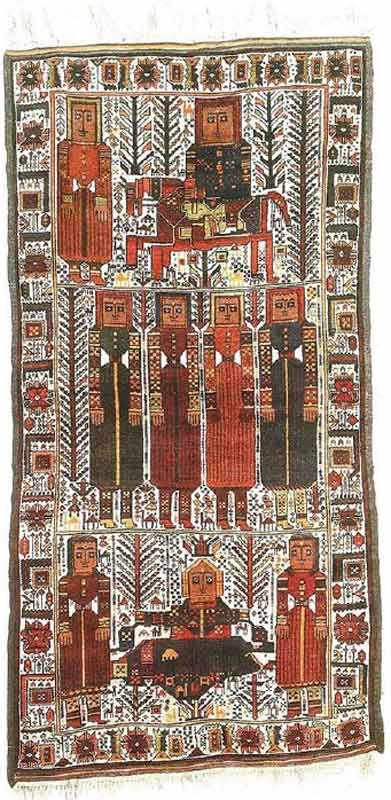
Figure 6: Baluch, Zabol, mid-14th AH century, asymmetric knot, 1280 knots per square decimetre; this carpet displays a scene from the story of Khosrow and Shirin. However, the images in the carpet do not narrative anything and if the viewer is unfamiliar with the story there is little to be understood from the images. (Tanavoli 1989, 48)
Of course, the carpet, in its physical aspect, has a distinctive relation to space in Persian architecture, as it covers a rectangular space that shall not deflect both horizontally and vertically. It is true that the carpet was not always considered a floor covering and not necessarily been rectangular in shape: as in the case of saddlebags and cushions, or carpets hanging from walls or covering a horse or a mule, and so on. Yet it is the Persian architectural space that provides a flat, rectangular space for the carpet: it is part of the formal relationship of carpets with the architectural space. This is why in European paintings that feature a Persian carpet, the first thing that strikes an Iranian viewer is the unusual use of these carpets: Hung from a window crawled up the stairs and deflected in height. This, in itself, has a definite relation to the way the carpet is seen: on the one hand, the formal carpet looks like a horizontal tableau that is clearly framed and as such forms a totality. It does not resemble, for example, the scattered Islamic designs on glazed tiles that crawl up walls whose entirety forms the totality of the building; on the contrary, the carpet has a strong, coherent framing that protects it against any deflection.
In the past, Persian carpets were not masked by pieces of furniture and thus better seen in their entirety. The carpet was the most important part of interior design. It was a furniture in itself. Thus, the carpet is fundamentally different from a painting: viewers of a carpet never actually see it in its entirety because they are already standing “on” the carpet. They never lose contact with it or distance themselves from it, far enough to see it in its entirety. They can kneel and touch it, or sit or lie down on it and get closer to it as much as they want, but their distance to the carpet never exceeds their height. The prohibition of walking on carpets with footwear allows a close and intimate relationship with the carpet, emphasizing its dignity and sanctity. Even paintings on ceilings (which sometimes reflect the patterns of a carpet, as in the case of Sheikh Safi’s tomb) do not enjoy such quality and can be seen and appreciated in one glance while remaining out of viewers’ reach. In the case of carpets, viewers can see the design from different angles and need to move in space and change their standpoint to fully appreciate the work (exactly the same way they need to circulate within the introverted spaces of Persian architecture in order to grasp a proper sense of space).
It might seem that the distance between the carpet and the observer is a secondary quality of the carpet and does not have a direct impact on the aesthetic aspect of the Persian carpet. However, we know of aesthetic systems (including that of Kant) that define the aesthetic experience fundamentally on the basis of an idea of distance. The most prominent is that of Edward Bullough (1880-1934), the English aestheticist, i.e. Psychical Distance. In a paper published in 1912, Bullough writes that the aesthetic experience takes place at a certain distance from the work, not too far nor too close, and this applies to the locative, temporal, and subjective distance of the observer from the object, and is an aesthetic principle (Neil 1995, 304), and is an element present in all art forms (ibid., 299). The transition from the agreeable to the beautiful takes place through distance (Neil 1995, 305). And it is advisable to reduce this distance both in creating and in understanding art, without having it completely removed. (Neil 1995, 302) In his view, this depends both on the audience and the object (Neil 1995, 302). For instance, the Persian miniature takes advantage of its small dimensions to reduce such distance. In carpets, however, the distance is completely different, both objectively and subjectively. The maximum distance is a person’s height and the minimum is zero. It is this distance that has resulted in the unique form of viewing carpets. The Persian carpet is not seen, but “watched” (tamāshā), as was the case with Persian gardens. That is to say, carpets were observed in motion, with a constant shift of the viewer’s point of view. The term tamāshā means “to watch” and “to walk in the garden with a friend” at the same time. Such a relationship between how carpets and gardens are viewed is by no means a coincidence. Persian carpets have long been associated with Persian gardens, sometimes even reflecting and imitating their patterns. In terms of function, the Persian carpet brings nature into the interior and plays the role of green in times of the year when grass does not grow. We know that the famous Sassanid “Baharestan” carpet had a similar function. Tabari History writes about this carpet:
“They wove a carpet with colored silk, sixty cubits in sixty cubits … they unrolled it in wintertime when no flowers blossomed and no green was seen on the globe. On the margins were sown emeralds and peridots… Omar ripped the carpet and the gems and gave each person a fair share… Ali ibn Abi Talib received his, which he sold for twenty thousand Dirhams.” (Tabari History, 1985, 41).
Thus, we encounter one of the most important subjective aspects of the relationship between carpets and architecture: the viewer is a part of the image; the observer of a carpet is “inside” the carpet. This also properly explains the horizon line in Persian carpets, which is very different from that of miniature painting: the carpet does not necessarily have a horizon line, and the horizon line is not necessarily within the carpet or in its “upper” part. The figures in pictorial carpets are not depicted “on” the carpet but are rather “inside” the carpet, like a letter in an envelope.

Figure 7: Horse and stableman, Hamedan, Darjazin, early 14th Century AH, 189*129 cm, symmetrical knot, 1296 knots per square decimeter (Tanavoli 1989, 95). The logic of the carpet design is much more bizarre than miniature. Where is the horizon line in this carpet?
This statement is also true on another level: the observer is “within” the carpet subjectively too. The carpet is not a home decoration, it is part of the home: it is home itself. This is why the unit for counting carpets, was called “home” (khāneh), or why the carpet sometimes imitates the plan of the Persian houses or gardens. Children are well enough familiar with this concept and elders respect it too. Children carefully trying to walk on the lines of a carpet pattern imagine themselves walking on a bridge above avoid. The patterns of a Persian carpet always show depth, as opposed to Persian miniature painting which appears flat and even.
So, when confronted with carpets, even pictorial ones, “touching” is more important than “seeing”. In fact, this is the only way to see it. Touching renders, us more dominant. Seeing does not allow one to understand the physical quality of a phenomenon, but the tactile sensation does. In pictorial carpets, this touching proximity is more realistic than an unattainable distance, as it empowers the viewer to touch the universe once again. The carpet is a representation of the universe, as the root of the Persian term indicates: in Haji/Engineer Travelogue, Ali Hassouri traces the root of the word Qāli (carpet), back to Qalin in the early Islamic centuries, to the words Kalinin the Sassanid era and Kar’einé in Avestan, back to the word Kāshtan (“planting”), as making every carpet knot is like planting a seed, that would later represent grass at the time of its absence in winter: the carpet is a perpetuated Persian garden. (Hassouri 2017, 42) In Mithraism, human beings are descendent of the plants: Mashya and Mashyana, the first human beings to grow out of the earth. Each knot of a carpet is a seed that is planted with hope and carries a wish, the same way lovers knot grasses in Nowruz with the hope of their wishes being fulfilled. Every Persian couple begins their married life with a home/carpet on which their children will later grow up and flourish.
Resources
- Emami Pari, Azar, and Bavand Behpoor. “The Iranian Carpet Is not a Picture”, Herfeh Honarmand (Iranian quarterly journal on visual arts), no. 73 (2019): 151-160.
- Parviz Tanavoli (1989) Iranian Pictorial Rugs (Tehran: Soroush Publication)
- Hafiz-e Abru, Nur-Allah ibn Lotf-Allah ibn 'Abd-al-Rashid Behdadini, edited by Seyyed Kamal Haj Seyyed Javadi (Tehran: Ministry of Culture and Islamic Guidance Publications)
- Ali Hasouri (2017) Haji muhandes Travelogue (Carpet Travelogue) (Tehran: Cheshme Publication)
- Doost Ali Khan Muir al-Mamalek (2011) Notes on the private life of Nasser al-Din Shah (Tehran: Iranian History Publication)
- Alex and Aaron Ridley Neil (ed.) (1995) The Philosophy of Art: Ancient and Modern Readings (Boston, Mass.: McGraw-Hill)
- shokrpour, and f.azhari , Azhari. “The role of the Figure in the Narratology of Persian Paintings” (Case Study: Six Drawings from Shahnameh Tahmasebi), Journal of Visual and Applied Arts (Quarterly Journal of Tehran Art University). no. 25 (2019): 101-121.
- Tabari History, illustrated version, 1208 ed., Astan Quds Razavi, Iran Culture Foundation, 1966, 17-18, quoted from Parham 1985, 41.
Acknowledgments
I would like to express my special thanks to my colleague and friend, Mr. Bavand Behpoor, for his intellectual support and insightful comments on this paper.
[1] The function of a carpet does not justify its appearance: Persian carpet has played throughout history a much more significant role for Iranians than merely providing a warm and soft flooring and has gained its appearance through complex and lengthy historical procedures.
[2] Persian pictorial carpets have been divided into two classes: one is urban carpets, and the other rural and nomadic ones. Urban carpets were woven according to a plan, painted by a carpet-designer, while nomadic carpets had a different origin. In Iranian villages and among Persian tribes, carpets were woven without a plan, and rather based on another carpet. When a weaver intends to weave a carpet, s/he borrows a carpet from their neighbors or relatives and uses it as a model (in local parlance: “Dastūr”). (Tanavoli, 1989:16)
[3] The installation of pictorial carpets on walls brought about changes in the way carpets were used. The new application moved the carpet from the floor and underfoot to the walls, turning it into a painting. Previously, ordinary carpets were occasionally hung on at door gates and walls, but that was a temporary function, in occasions such as wedding, religious celebrations, especially commemorating the birthday of the last Imam (the Messiah or “Mahdi”). Walls of houses, shops and markets could be decorated with carpets, a custom that still exists today. (Tanavoli, 1989:14)
[4] The 19th and 20th centuries should be considered the time of popularization of illustration in Iran. In those two centuries, a significant tendency towards simulation and naturalism became apparent in nearly all branches of art. Simulation, as a pervasive movement, attracted the attention of artists. The leaders of that movement, of course, were painters. Although painters constitute different classes and branches in this, the main goal of all groups was to depict their subjects through likeness and similarity to nature. Two groups of painters had the largest share in spreading visual arts among the masses: Coffee-House painters and religious painters. The works of these artists were widely seen and influenced the taste of artists in other disciplines, including engravers, illustrators of printed books, and carpet weavers. (Tanavoli, 1989:11)
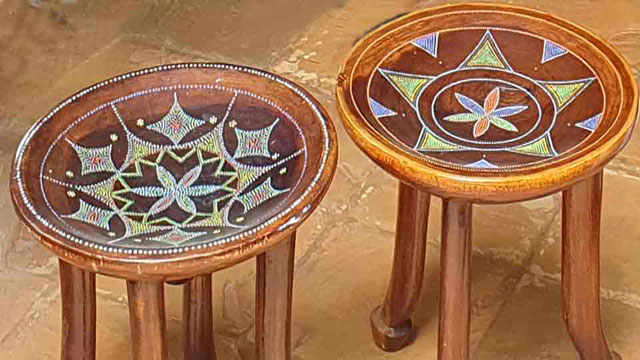
-
 Mary Claire Kidenda
Mary Claire KidendaKenya is extraordinarily rich in creativity, materials, and ideas sources of inspiration reflected in their artefacts which has evolved to its current prosperous state over the centuries. The Kenyan culture can be seen in the visual arts, applied arts, food, music, dance, sports, fashion, literature, and theatre. The artefacts are an extraordinary source of inspiration and nourishment for the artist. Their designs embody African design aesthetics that have retained traditional designs as they also reflect elements of innovation, hybridity, sustainability and modernity (Maina et al., 2017). The artefacts reflect religious beliefs and cultural values – two inseparable elements enmeshed in Kenyan craft. The Kenyan traditional art is fundamentally functional, meeting some specific utilitarian purposes, whereas its aesthetic consideration is typically regarded as having some secondary significance. Art was integrated into everyday aspects of life from formal ceremonies and religious rites to daily household tasks. The arfetacts were produced by skilled experienced crafts persons who were found in the societies. Art is an expression of a particular community or culture through the employment of local materials and craftsmanship.
The Jua Kali manufacturing subsector is the predominant creator of craft products in Kenya (Maina et al., 2017). Jua Kali is a self-organising community of practice producing goods. It is comprised of artisans running micro and small enterprises that are not fully integrated into the mainstream formal economy. The artisans learn skills through traditional apprenticeship (TA). Apprenticeship training is regarded as a critical contributor to skills supply, fostering economic development in Kenya. It involves the transmission of the tacit rather than the explicit knowledge and is the most tangible exhibition of the intangible cultural heritage. It facilitates the transmission of skills from a custodian of knowledge, the Master Craftsman. It combines ethnic design and aesthetics and contemporary styling in craft production in Kenya. Involves the transmission of the tacit rather than the explicit knowledge through observation, imitation and reputation. Besides, apprenticeship ensures that the knowledge and skills that relate to the craft are passed down to future generation so that they continue to be produced within their communities. The learning of the Kenyan design, aesthetics is therefore, an intergenerational phenomenon.
Kenya's ethnic groups can be divided into three broad linguistic groups Bantu, Nilotic and Cushite. The Nilotic tribes in Kenya include Luo, Kalenjin, Maasai and Turkana (Hino et al., 2019). The Nilotic speakers migrated from Sudan and Egypt. They are traditionally pastoralists and fishermen and reside in Kenya's vast Rift-Valley region and around Lake Victoria (Madut, 2020). Each of these communities has its traditions, customs, and practices, imbued with multiple layers of culture, colonial legacies, and migration that add to the rich Kenyan cultures (Deisser & Njuguna, 2016) . The distinctness and confluence of these cultures have served as artistic inspiration for many a cultural product creatively fashioned out of raw materials primarily sourced from the natural environment.
The Luo or Lwoo (also called Joluo, singular Jaluo) are an amalgamated agro-fishery and Nilotic Dholuo ethnolinguistic groups in Africa that inhabit an area ranging from South Sudan and Ethiopia, through northern Uganda and eastern Congo (DRC) (Ojwang, 2021; Prince & Geissler, 2008), into western Kenya, and the Mara Region of Tanzania west Kenya, eastern Uganda, and in Mara Region in northern Tanzania. The name Luo or Low means "God's life-bearing exhalation.' The past economic activities of the Luo included fishing and cattle farming (Ndeda, 2019). Agriculture, especially that which involves staple crops such as maize and beans (Ojwang, 2021). Nilotic communities such as Turkana and Pokot (ekicholong) and even Bantus such as Kamba (mumo ya muthamia) and Taita (kifumbi) in Kenya have traditional stools that have been used for various cultural and functional purposes (Somjee, 1993).
This paper discusses the Luo Traditional Three-Legged Stool called “Kom Nyaluo” in the Luo tribe (Hoehler-Fatton, 1996). My interest in this stool arose because I am a Luo lady married to a Luo man who owns the stool.

Kidenda, “Domestic Exhibition of Kom Nyaluo to EVC Expert Panel Discussing the Versions of the Traditional Stool”, Wood and Beads, 2022 Karen, Nairobi
The circular top of Kom Nyaluo symbolises the round universe and a miniature universe on which the husband reins in a home. It is a sign of prestige and leadership, reflecting the status or power of men or the husband within society and a reflection of the round traditional Luo huts. Its legs embody male masculinity and virility (Biko, 2010). Only the father was qualified to sit on the seat as he had requisite authority and was the owner of all the women he brought forth life with. He would sit on it when addressing issues; women and children would sit on the ground.
The traditional Kom Nyaluo was small, with a height of about 30cm from the ground and decorated with beads (Hoehler-Fatton, 1996). Each elder had their stool, and women and children were forbidden from sitting on it. Kom Nyaluo is associated with the authority the elders wielded and the respect that they were accorded in their homes and society. The stool design reflected the traditional activities of men and women. The men worked and socialised outside the home, and the women mostly worked inside and around the house and garden (shamba). A married young man with a few children applies for an eldership position in a ceremony where he hosts community elders. He would be dressed in traditional regalia, carry a spear and fly whisk. The elders would sit him on Kom Nyaluo and crown him as an elder.
Most traditional Luo homes were polygamous, and the stool played a significant role in controlling the wife, which enjoyed marital favours and childbearing. The husband or man of the house would send the stool to the woman's hut. He would want to spend the night in her hut. The stool would be sent secretly, and early the following day, the man would sneak back into his hut so that the other wives would not know whom he slept with. This brilliantly averted obvious petty jealousy will arise from a polygamous home. If one wife felt that she didn't have the stool in her house often enough, she would ask the first wife to intervene on her behalf. "If the first wife didn't like her, she would ensure her complaints did not reach their husband. The seat symbolised love and joy and sustained life in a traditional Luo homestead. Literally and figuratively, of course. Kom Nyaluo did not only represent the authority of the man but also love and joy and sustained life in the traditional Luo home (Biko, 2010).
Kom Nyaluo was used during the levirate ceremony or "tero", where a widow was remarried to a relative of their deceased husband. The levirate union is consummated by sexual intercourse on the first night. If the widow invited the elders for a drink the day after the night of "ter", it was a sign that the night had been successful. During the drinking session, there was the enthronement ceremony of the new head of the home onto the stool of the deceased, "Kom wuon dala" (seat of the homeowner). With the enthronement, it was as if the dead man was alive again (Lutta, 2015). After marrying and having a few children, a Luo man applies for elderhood by hosting the elders at a party where he will be crowned and dressed in traditional regalia. Signs and symbols of authority that include a spear fly whisk and a three-legged stool are given to the elder.
Production Process
In this case study, the Kom Nyaluo is produced by an artisan from Siaya County Jua Kali Association craftsman. He learned his father's craft skills through traditional apprenticeship and made his products on demand. The Luo traditional stools are carved with logs from ober (mvule tree), ngo'wo (fig tree), duwa (oak tree) and the member (mango tree). The logs are chopped by a power saw and dried for one week. These are hardwood types that are strong, durable and water-resistant. They also feature unique colours and grain patterns that create a stunning display. Oak is light yellowish-brown and generally straight-grained; it is also hard and durable. Mvule wood comes from the African teak, known in Nigeria as the iroko tree; it is challenging, dense, and durable. Fig tree wood sometimes contains latex, which can be toxic or an allergen. Since the fig trees seldom grow straight, their boards tend to be shorter. However, the wood is soft and not very strong. Mango wood is relatively easy to work with; it is easier to shape, plane and sand while still strong and durable. It is also friendly to waxing and staining, making it excellent for furniture or other household objects.
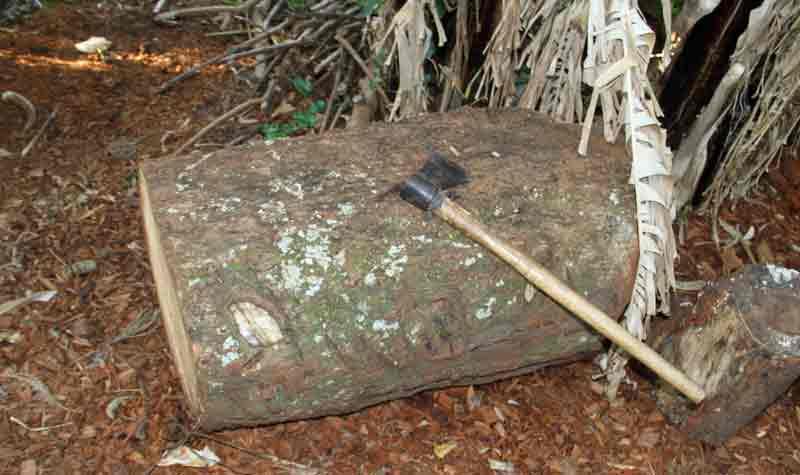
Kidenda, “Wood Logs used for curving out Kom Nyaluo”, 2013, Siaya, Kenya
Each log costs the artisan ten thousand Kenya shillings (Ksh. 10,000), equivalent to sixty-seven (67) euros. The stool is carved from a single block of wood, the wood between stem and roots, which has twisted grains that are more durable and cannot break or crack. The stool is made without using joints or nails. The seat takes the shape of a log. The carver uses Koyo (adze) to fashion Kom Nyaluo from the log, which does not require nails or joints.
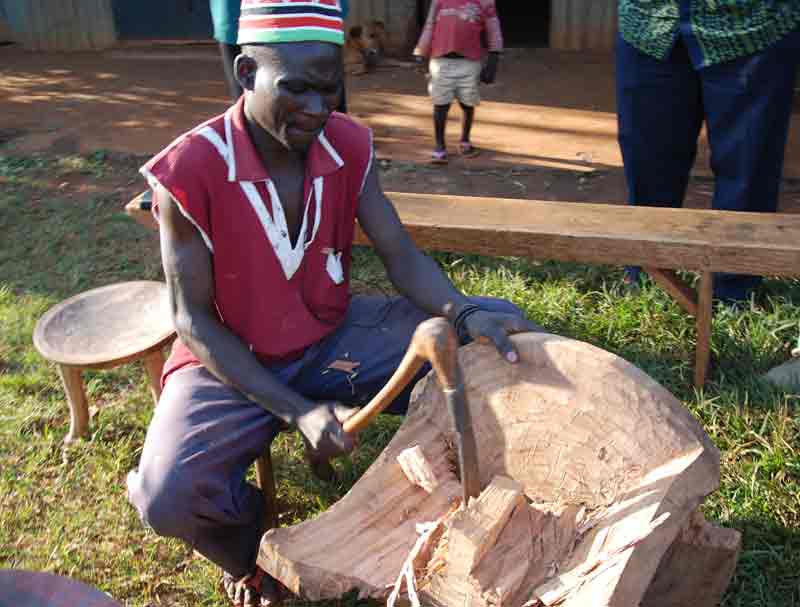
Kidenda, “Curving out the Kom Nyaluo from a log”, 2013, Siaya, Kenya (photo by Mary Clare Kidenda)
Its top takes the circular shape of the log, and after carving, it is smoothened with a furr (metal scrapper for smoothing wood).
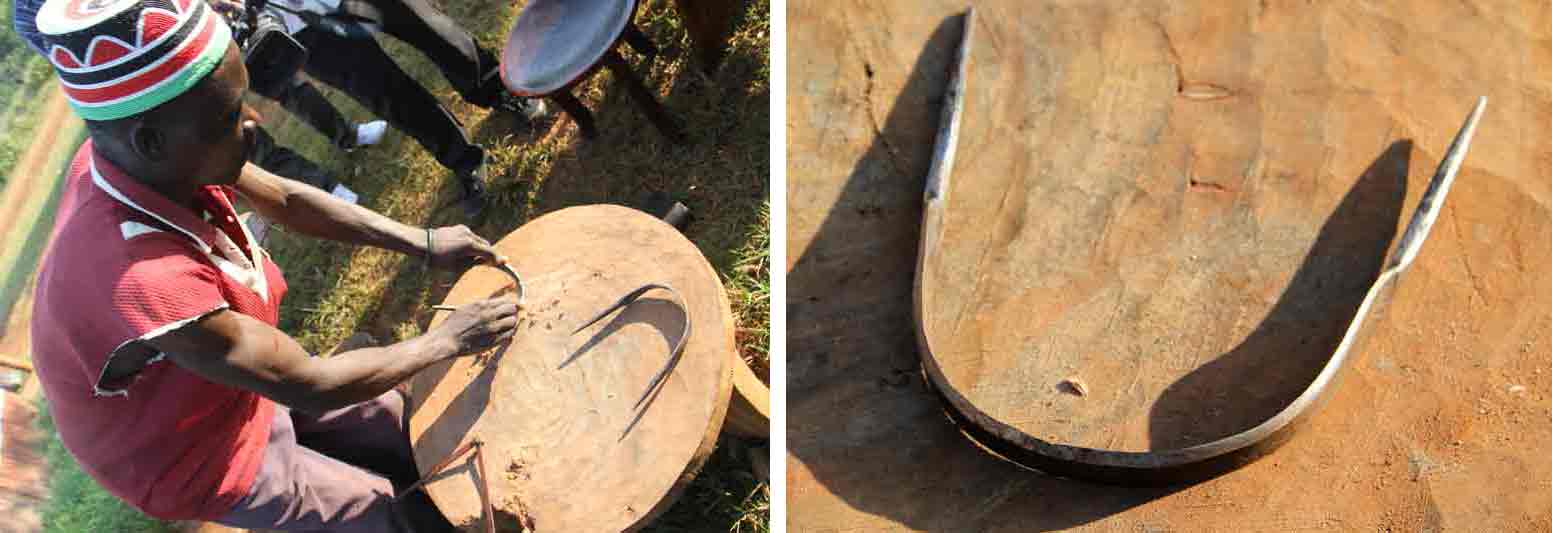
Smoothening the Circular Top Using Furr, 2013, Siaya, Kenya; Furr, the handmade metal tool used to smoothen the top of Kom Nyaluo, 2013, Siaya, Kenya (photos by Mary Clare Kidenda)
They are then sandpapered and vanished using paintbrushes.

Sandpapered and vanished sets of Kom Nyaluo, 2013, Siaya, Kenya (photo by Mary Clare Kidenda)
A compass is used for drawing geometrical patterns on the top of the stool.
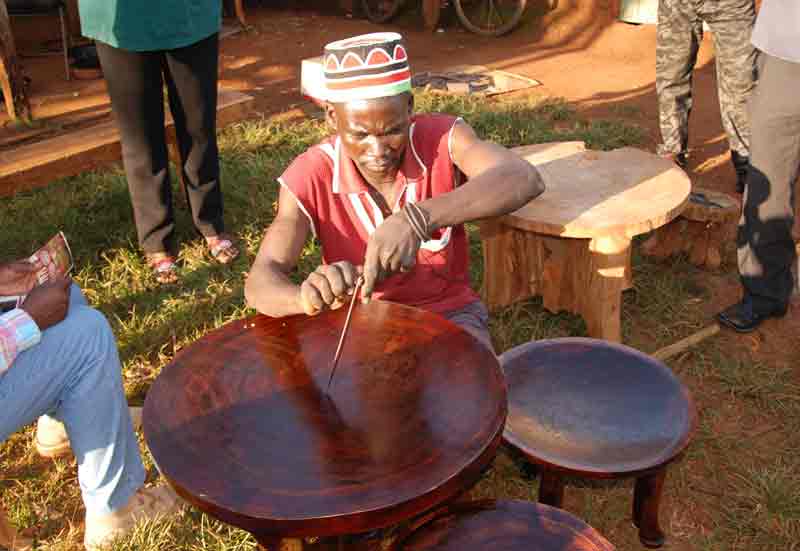
The drawing of geometrical patterns using a compass, 2013, Siaya, Kenya (photo by Mary Clare Kidenda)
Supposedly the design is inspired by a parquet floor in a European-style house owned by Tom Mboya. The wire inlay practised by the Kamba may also have been a model. Thereafter, wood, glass beads, metal, and colourful Maasai beads are banged onto the top, providing intricate decorative artwork.
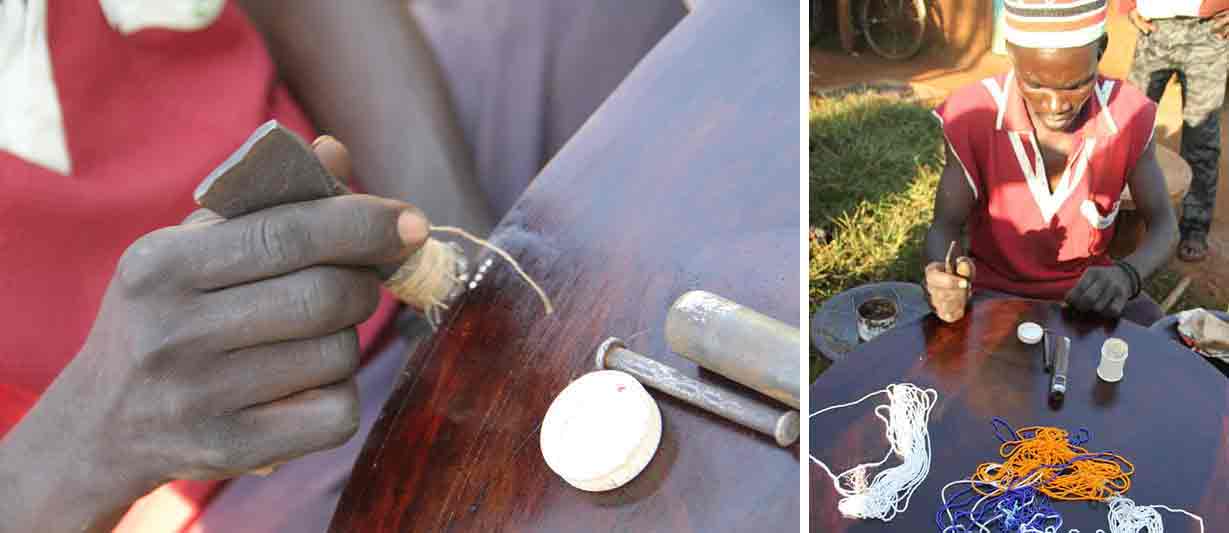
The inserting/banging of beads into the top of Kom Nyaluo, 2013, Siaya, Kenya (photo by Mary Clare Kidenda)
Finished: A Luo Dignitary Stool “Kom Nyaluo”
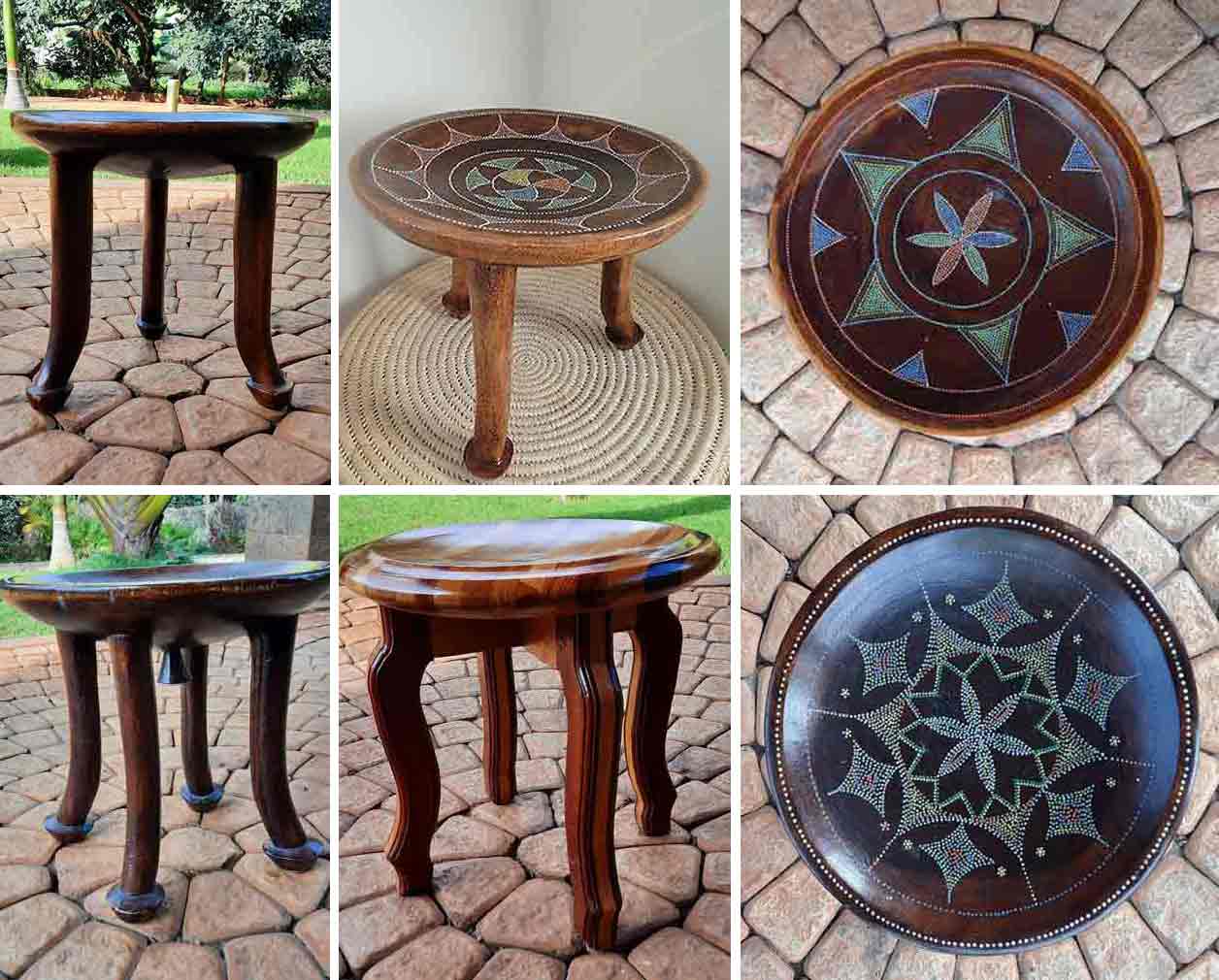
Variety Designs of Finished Kom Nyaluo, 2019, Karen, Kenya (photo by Mary Clare Kidenda)
When Sara went to the US for the inauguration of Mr Obama as president in January 2009 Mama Sarah carried a similar stool. In 2015 when President Obama visited Kenya, he was given a traditional Luo stool (Langat, 2015).
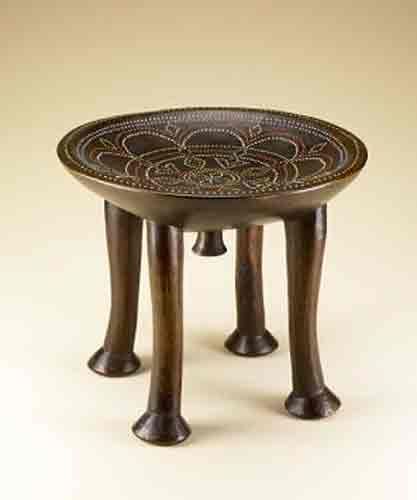
Kom Nyaluo Created by Luberastus Onyango, Wood, glass beads, metal, 2020 Smithsonian National Museum of African Art.
Luberastus Onyango was a renowned Kom Nyaluo craftsman (he died in 1988) whose stools have been given to at least 2 US presidents as gifts President, including John F. Kennedy and Barrack Obama.
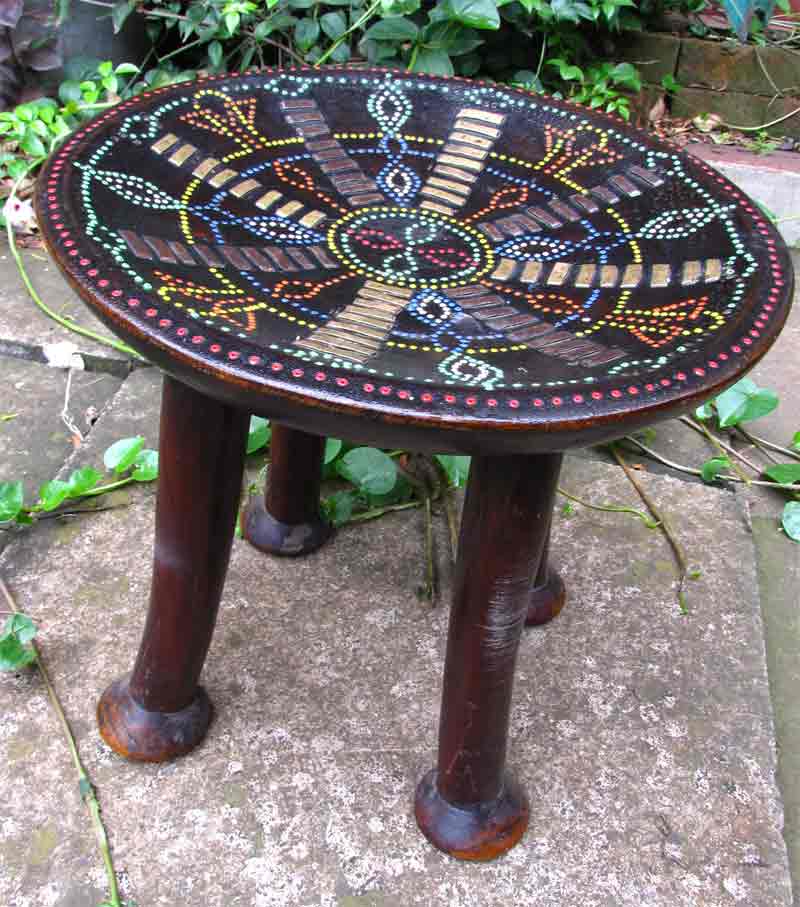
Variety Designs of Finished Kom Nyaluo, 2019, Karen, Kenya (photo by Mary Clare Kidenda)
A generation of Kenyan artists and designers are translating their view of Kenyan design into beautifully crafted products and creating an aesthetic diverse as the tribes and cultures that make up Kenya. This is evident in the JKS in the preservation and modification of the designs like Kom Nyaluo through a traditional apprenticeship that is the critical training methodology of apprenticeship used in Jua Kali Associations. This is evident with the continued production of Kom Nyaluo because of for its cultural utility and aesthetic functionality in the contemporary modern spaces. Artisans and designers are to re-direct and co-create new narratives that re-position philosophical discourse on aesthetics, among other contemporary debates. A generation of Kenyan artists and designers are translating their view of Kenyan design into beautifully crafted products and creating an aesthetic diverse as the tribes and cultures that make up Kenya.
References
- Biko, J. (2010). When in Kisumu, make sure you visit the museum. Eastern African Publication. https://www.theeastafrican.co.ke/tea/magazine/when-in-kisumu-make-sure-you-visit-the-museum--1297986
- Deisser, A.-M., & Njuguna, M. (2016). Conservation of natural and cultural heritage in Kenya: A cross-disciplinary approach. UCL Press.
- Hino, H., Langer, A., Lonsdale, J., & Stewart, F. (2019). From Divided Pasts to Cohesive Futures: Reflections on Africa. Cambridge University Press.
- Hoehler-Fatton, C. (1996). Women of fire and spirit: History, faith, and gender in Roho religion in western Kenya. Oxford University Press.
- Langat, P. (2015). Mama Sarah reveals her special gift to Obama during visit. Nation. https://nairobinews.nation.africa/mama-sarah-reveals-her-special-gift-to-obama-during-kenyan-visit/
- Lutta, C. (2015). The Traditional Levirate Custom as Practiced by Luo Of Kenya. University of Gavle.
- Madut, K. K. (2020). The Luo people in South Sudan: Ethnological heredities of East Africa. Cambridge Scholars Publishing.
- Maina, S. M., Rukwaro, R. W., & Onyango, W. H. (2017). Infusing Design In The Jua Kali (Informal Sector) Production Processes. Journal of Humanities and Social Science, 3(2), 1–12.
- Ndeda, M. A. J. (2019). Population movement, settlement and the construction of society to the east of Lake Victoria in precolonial times: The western Kenyan case. The East African Review [Online], 52.
- Ojwang, H. H. (2021). A study of Luo Ethnobotanical Terminology with implications for Lexicographic Practice. Lifelong Education Material Publishers.
- Prince, R., & Geissler, W. (2008). Becoming “One Who Treats”: A Case Study of a Luo Healer and Her Grandson in Western Kenya. Anthropology & Education Quarterly, 32(4), 447–4.
- Somjee, S. (1993). Material culture of Kenya. East African Educational Publishers.
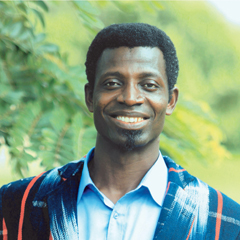 Osuanyi Quaicoo Essel
Osuanyi Quaicoo EsselPan-African collective memory: Sociocultural power and identity making on indigenous stools from Ghana and Kenya
Indigenous stools play significant roles in Ghanaian and Kenyan cultures and societies, especially, among the Akan and Masai ethnic groups in the two respective countries. Stools in the sociocultural context serve many functions. One of the primary functional roles is that, it serves as object for sedentary purposes. It is used as a utilitarian object for sitting, welcoming visitors, relaxation for people, for example, family and friends. In Ghana, it is customary to offer a visitor a chair (stool) by way of welcoming, serving him/her water, before asking the visitor of his/her motive for the visit. In the first instance, a visitor is given a sit to relax, followed by cup of water for drinking before asking the visitor to give purpose for the visit. Offering a visitor a chair shows an overt acceptance and respect for his/her presence. This traditional etiquette of serving visitors is ingrained the sociocultural life of both Ghana and Kenya.
Amongst the Akan of Ghana, a visitor is usually given a traditional stool as a seat that may befit his/her status in the traditional society or culture. A family may have different stools: those for showcasing power and authority of its user, honouring guests, and everyday usage by the household. The usage of stools in this context depicts its status-defining tendencies.
Apart from signifying status of individuals, stools, among the Akan of Ghana symbolises the authority of the ethnic or nation states. Stools in Ghana, generally serves as a symbolic soul of the society which links people to the traditional leadership (Antubam, 1963; Amenuke et al, 1991). The stool carries authoritative presence and signifies leadership concept. Warriors, clan heads, chiefs, kings used it to signify their status.
Stools serve as scared and authoritative object in the traditional chieftaincy institution of the southern part of Ghana. Kings/chiefs are enstooled in southern Ghana while those at northern part are enskinned. This implies that in the cultural rituals in the making of Kings/chiefs, stools are inevitable. Amongst the chiefdom, there are several ritualistic uses of stool. Some stools in the court of a chief may be used only once in his or her lifetime. Some are also used once a year during traditional festivities while some are used on daily bases.
As an object strongly connected with power and authority, the Ghanaian stool has three basic parts: the arc-shaped top, the middle portion and the flat base. Its arc-shaped top symbolises loving embrace of women or the concept of motherliness (Amenuke et al, 1991; Antubam, 1963). The middle portion usually gives the stool its name based on the symbol used in representing a concept or idea. The name of the of a stool could be based on a proverb, Adinkra symbol (Figure 1), traditional emblem or idea. For example, the stool in Figure 1 derived its name from the Adinkra symbol which has been stylised to occupy the middle portion, hence the name Nyansapow Stool.
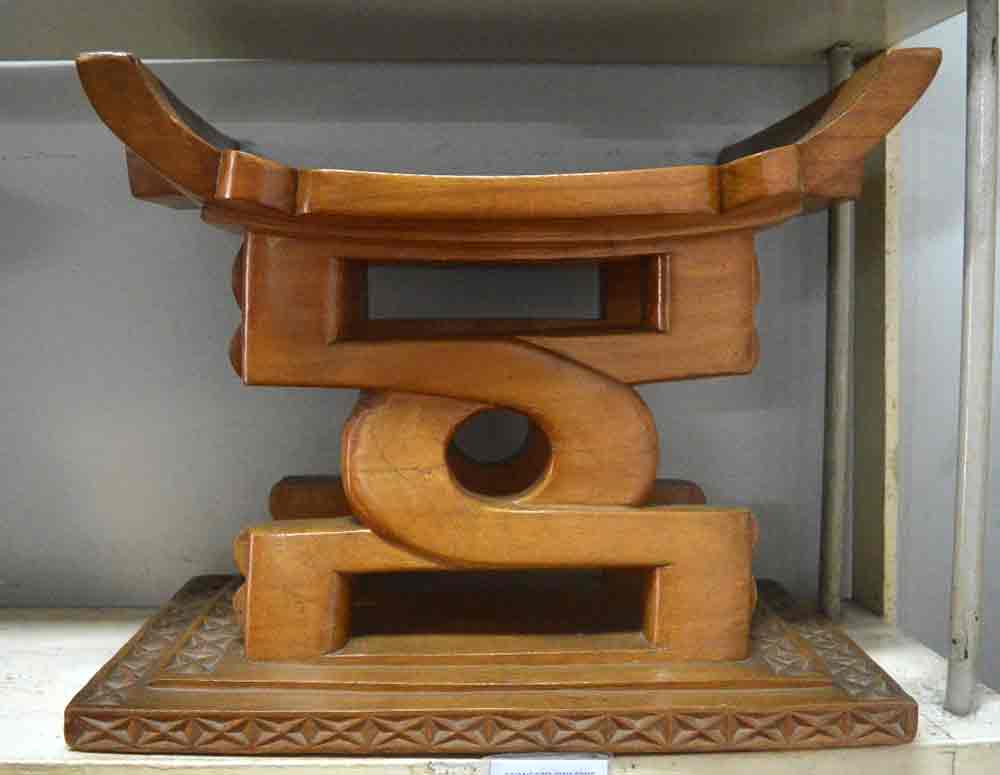
Figure 1: Nyansapow (Wisdom knot) stool, wood, Ghana National Museum, Photo: the author.
The recognition of the presence of God in the society, gender roles and the presence of children is also acknowledged by the middle part of the stool. Design of a stool may adopt basic beliefs and practices of symbolic significance to the society in general. The symbolic adaptation speaks to the visual presentation of Ghanaian societal values including concept of societal functions, cosmic beliefs, family and gender roles.
As a utilitarian object, the stool plays vital roles in the rites of passage (birth, puberty rites, marriage and death) in indigenous Ghanaian and Kenyan cultures in different context. In indigenous Masai culture, stools are used by husbands as object of announcing their eminent visit to their wives on rotational basis. In many African societies, marrying more than one woman is an accepted norm just as same sex marriage are acceptable in other continents of the world. African society holds polygamy as a culture and not in negative perspective as non-African wrongly perceives it. Masai men with more than one wife usually build their houses in circular orientation, allocating a room each to the wives. The house of the man is situated in the middle of the circular-arranged houses. With this traditional set up, the stool is used as a preserve for the husband to signal his presence and authority. To announce his official intention of visiting one of the wives in the same compound, he sends his messenger to send his stool to one of the wives he intended to visit. By seeing and receiving the stool, the wife interprets this symbolic gesture to mean official announcement of her husband’s visit.
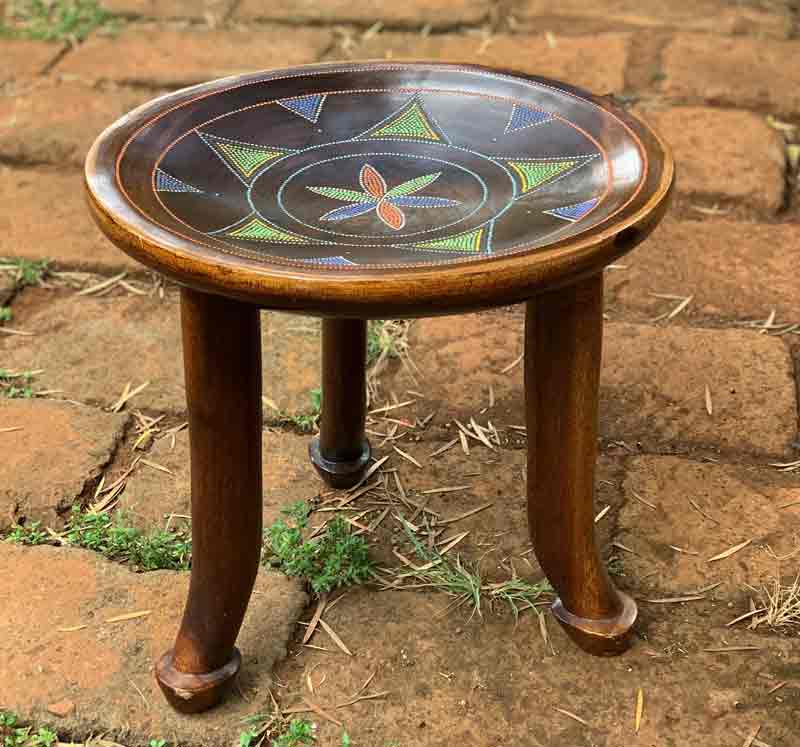
Figure 2: Traditional Kenyan stool used in negotiating visitation to wives, Found in the personal collection Mary Clare Kidenda. Kenya, Photo: the author.
The design of the Masai stool of Kenyan (Figure 2) varies from that of the Akan of Ghana. The Maasai stool features a circular-shaped top and prominent three-legged phallus-shaped upright stands. Usually decorated with traditional Masai beads, the top of the stool has bowl-shaped surface that serves as a comfortable receptor of the buttocks of the user. The tip of the phallus-shaped stands touches the ground and gently bends inward, and depicts crown-shaped cork memetic of the phallus. These observable characteristic features symbolise the presence and potency of the manhood in procreation. Despite its simplistic appearance, the stool creates a collective memory of marital relationships and the supervisory power of males and the loving embrace of women. Interestingly, this depiction to the African, is not a show of chauvinism but a reminder to males to protect and care for women within their power. Generally, having secret rendezvous or extra marital affairs is frond up by society. Performing official marital rights to marry a lady is the traditional expectation rather than having them as mistresses.
In Ghana, the head of a clan, warrior, chief/king and queen mothers uses the stool to symbolise authority. For that matter, the presidential seat was fashioned with inspiration from the shape of the stool. Despite the difference in design concept of the Kenyan and Ghanaian stools, both signify a collective memory of marital relationships, idea of procreation, leadership authority and the loving embrace of women in the society.
References
- Amenuke, S. K., Dogbe, B. K., Asare, S. K., Ayiku, F. D. & Bafoe, A. General knowledge in Art for senior secondary schools. Evans Brothers Limited.
- Antubam, K. (1963). Ghana’s heritage of culture. Koehler & Amelang.
- Asihene, E. V. (1978). Understanding the traditional art of Ghana. Associated University Presses
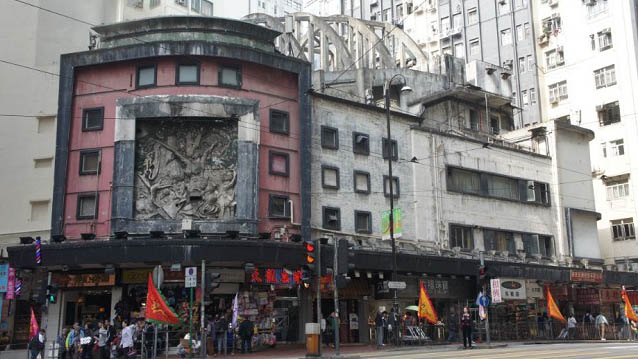
-
 Prudence Lau
Prudence LauState Theatre, originally named Empire Theatre, was opened in 1952. According to interviews with veterans from cultural circles, the Theatre was the “very origin of Hong Kong’s entry to the world of high arts” (South China Morning Post, Jan 11, 2017). It was Hong Kong’s cultural hub and only to be eclipsed by the City Hall that opened four years later in 1962. Located in North Point on Hong Kong Island, it was founded by a Russian-Jewish impresario Harry Odell, a legendary giant in the history of Hong Kong entertainment. Odell had started a film distribution company ‘Harry Oscar Odell’s Commonwealth Enterprises Corporation Ltd.’ in the post-war years and arranged for internationally acclaimed artists to perform in Hong Kong and in the theatre, including the late Taiwanese famous pop singer Teresa Teng, the late British tenor Peter Pears and Katherine Dunham’s Broadway dance company (South China Morning Post, March 2, 2016).
The Theatre was also a popular venue for live shows such as Chinese drama, opera and musical performances. The roof of the auditorium is suspended from external parabolic concrete roof trusses, which are exposed to the public and serves as a prominent feature and trademark of the building. This ingenious design also freed the auditorium from pillars and allowed for flexible internal arrangements. Designed by a Chinese architect S.F. Liu, the Theatre is moreover fronted by a large decorative relief panel with the artwork by renowned Lingnan artist Mui Yu-tin featuring the ancient Chinese tale of ‘The imperial warlord Dong Zhuo and the legendary beauty Diao Chan’. Together with the framed squared architraves and banded windows harmoniously fronting the elevation of the Theatre, there is a distinct Modernist and Art Deco quality to the whole building.In 1959, it was renamed State Theatre, and due to practical reasons the building has since then been converted into a theatre-cum-shopping complex, and a multi-storey block with shops, residential flats and a night club was opened in the adjacent site. The Theatre finally ceased to operate in 1997, and has today changed its use to a billiard centre with removable partitions sealing off the upper deck of the auditorium. The rest of the complex currently consists of a rundown shopping mall, still in function, and small residential flats.
In July 2015, a local property developer started to purchase various property rights within the State Theatre complex, and rumours of demolition and redevelopment of the site started to spread. Eventually, after substantial consolidated public efforts towards the Theatre, it was finally given a Grade 1 historic building status in March 2017. The State Theatre, narrowly escaping demolition, is only the third building after the Bank of China (built 1952) and the City Hall (built 1962) listed as a Grade 1 historic building in Hong Kong that is built after 1950, indicating a flaw in local heritage policy to value modern built heritage.
published January 2020
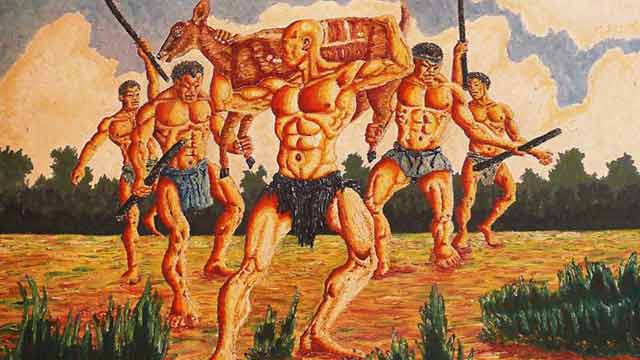
-
 Emmanuel Aklasu
Emmanuel AklasuOwusu-Ankomah’s painting at first glance reveals a foreshortening company of energetic warriors, muscular framed with broad shoulders, muscled chest, and a narrow waist in a chiselled physique. The hunters were portrayed with huge hands, clenched fist, knuckles, strong legs visibly revealing biceps brachiis and dabs of varicose veins on the arms, thighs and legs evident of powerful and efficacious men. Before modern society, the average male spent most of their time hunting, protecting, and engaging in physical activities that increased their muscle mass and maximize their muscular proportions. Owusu-Ankomah’s production exhibits masculine competitiveness and a sense of adventure – the brave team were a-fire with passion, armed with sticks in a leopard-like graceful movement as the captain leads carrying a captured antelope shoulder high.
The warriors are noticeably naked with only a string of grass costume wrapped around the private parts which is the formal and ceremonial attire for the ancient culture. Owusu-Ankomah’s choice of colour in rendering the human figures lends credence to the fact that colours have a strong position in identifying humans while hunting. Wearing hunter orange is the best way to ensure other hunters see you and don’t accidentally mistake you for game in complex backgrounds that are often green or brown. The artwork reveals harmonizing brown colours which tend to create a central focal point in the entire picture frame to evoke earthiness, emotions, security and safety related to the natural world. The tints and shades of hues enhanced the main features in the painting to vividly communicate the intended message as well as create an illusion of depth.
A thick flora forms the background of the painting evident that the hunting expedition was carried out in a thick forest. As the fearless, able-bodied men advance through shrubs in high spirit of mission accomplished, an earthly scent swirled around them coupled with a sense of eagerness to meet a welcoming, expectant and jubilant community. Hunting is an extremely important mode of human-nature interaction closely linked to culture patterns and value systems. This engagement with wild animals is thought of as part of a deeper unity with nature, which means being part of nature in physical sense (Lowassa et al., 2012). Sustainable hunting prescribes taking as much as needed and as much as the habitat and the population can regenerate. Suffice to say, when hunting for a game form the basis of a year-long survival of a people, it calls for a deeper reflection. Owusu-Ankomah’s painting comes on the back of an ancient heritage of a distinct tribe in Sub-Saharan Africa.
‘Aboakyir’ translated ‘deer hunt’ is a festival uniquely celebrated by the Effutu (Simpa) people of Winneba in the Central Region, southern coast of Ghana, West Africa. The festival which is celebrated annually on the first Saturday in May has the historical antecedent of the replacement of a human sacrifice to a tribal god with a leopard – an alternative which resulted in the loss of many more lives than the sacrifice of a single slave. Consultations with the deity for a more humane alternative resulted in the “Wansan” (the deer) as a practicable and most acceptable substitute. The capture of a live deer, like the leopard, required many more hands than the members of the royal family could find. The additional hands required were solicited from the local militia as a service to ‘the stool – a symbol of chieftaincy, royalty, custom and tradition’. It was this change in form; that is, the involvement of the local militia, that the annual consecration and appeasement of the deity became a public, state-wide affair. This marked the birth and hence the origin of the “Aboakyer” festival.
The design of the Effutu State emblem tells this story; the ‘stool’ on which the King is installed sits on the “Wansan” (the deer).

Emblem of the Effutu state (Source: Palace of Oma Odefe)
The festival is therefore important for the ‘stool’, its occupant and the entire royal stool family. It is a religious duty and an obligation for the general citizenry to ensure its celebration annually is sustained to honour the ancestors and protect their historic culture for posterity on the back of removing evil and predicting a good harvest for a prosperous life in the coming year. The week-long activity begins with two traditional warrior groups known as the ‘Asafo’ companies consult their shrines for clearance, protection and early catch. The warrior groups clad in distinct costumes with distinct musical instruments — the ‘Tuafo' and ‘Dentsefo’, move to their respective hunting grounds at dawn on Saturday, wielding sticks and clubs amid chanting of war songs. No weapons, other than clubs and sticks are used to catch the deer, as it must be brought back alive.
By far, the relevance of Owusu-Ankomah’s painting is not in doubt as it fosters a deeper understanding of the historical and societal roles of hunting within Ghanaian communities. The painting holds both cultural and educational significance which sparks discussions on conservation, sustainable practices, and the preservation of cultural heritage. Consequently, bridging the gap between present generations and the rich tapestry of cultural and environmental history. The sight of the painting in Ghana’s National Museum serves as a poignant reflection of the nation’s cultural heritage and connection to nature. In this visual narrative, the core of historical period of a distinct society is unearthed.
References
- Lowassa, A., Tadie, D. & Fischer, A. (2012). On the role of women in bushmeat hunting – Insights from Tanzania and Ethiopia. Journal of Rural Studies 28(4):622–630.
Further Reading
- Anane-Frimpong, D. (2022). Aboakyir: Deer hunt festival. Link Retrieved on April 10, 2023
- Rubiano, W. (2017). Planting trees for the aboakyer festival 2017. Link
Published March 2024
 Barbara Lutz-Sterzenbach
Barbara Lutz-SterzenbachAn energetic scene. Five men in a flat landscape approach the viewer. Their bodies are naked - except for their loincloths - their faces grim. Muscles in the bright light stand out under the skin, their chests bulge voluminously - they are timeless heroes. The men do not look at the viewer of the picture. With their long, dark sticks firmly in their strong hands, they gather symmetrically around the bald man in the foreground. He presents himself with an antelope in his raised arms. His bald skull points to the left, as does the antelope's head.
On closer inspection, some things are irritating. Are the men dancing or walking? Where is the animal spatially located? Somehow it is on the shoulder of the man, but the legs are captured by the men behind, who would be much too far away for that. Is an event, an episode (as in a photograph) depicted? Or does the symmetry of the composition speak more of a constructed symbol, a sign, as in an emblem? The latter would support the strict division into horizontal planes: with the islands of grass in the foreground, the flat, ochre-coloured plane in the middle ground and the forest with sky in the background. But then again many design principles undermine this order: the tense, energetic movements of the figures, the strong brushstrokes, the irregular shapes of the white clouds and the tufts of grass, the dynamic accents of the sticks.
We know from our Ghanaian colleagues that what is depicted here, the catching of the animal, is part of a ritual celebration and a festival (the Aboakyer Festival). Here the moment is shown when the men have stepped out of the dark, hermetically sealed forest in the background with their prey and now present themselves in the bright light with their success. A comparison with the results of an image search on the internet for “Aboakyer festival” (Fig. 2) shows that this is the iconic moment. Here the idea of the festival seems to be condensed. And this also explains the emphasis on muscles: the hunters must be well trained to match the animal's speed and strength.
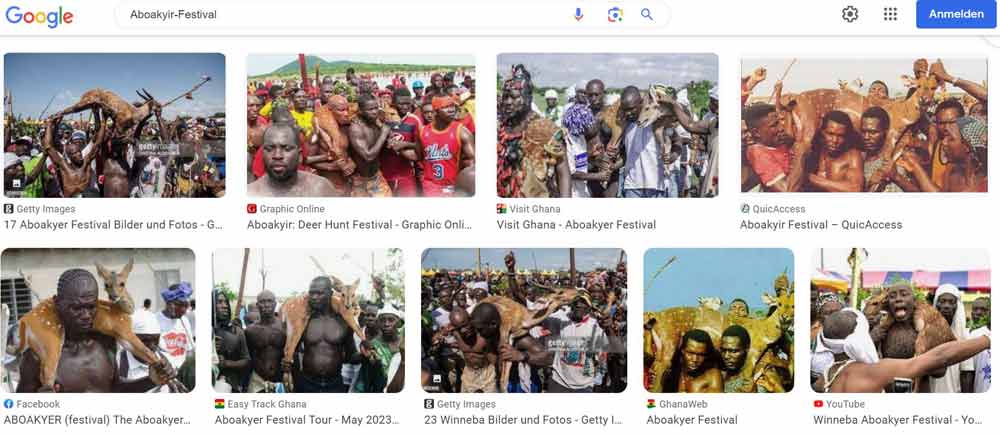
Fig. 2 (Google search for "Aboakyer Festival" on 9.9.2023 - the first page of results) Screenshot: Ernst Wagner
Owuso-Ankomah's painting focuses on the men with the animal. At first glance, the painting shows above all the strength of the men. The space thus becomes the backdrop for their performance. Their bodies are not only idealised but theatrically exaggerated, their muscles as if illuminated by a spotlight. The geometric centre of the picture, through which the horizon also passes, brings the loincloth of the leader into focus (see fig. 3) - perhaps an allusion to male potency?
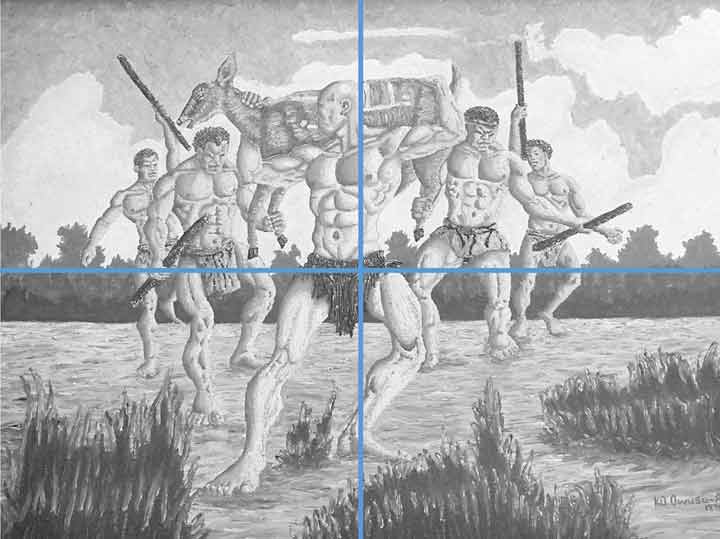
Fig. 3: Composition sketch (horizon and geometric centre) Photo: Ernst Wagner
A comparison with photos on the same theme from the Heritage Centre in Winneba (see Fig. 4-6) shows clear differences to the depiction in Owusu-Ankomah's painting. In the artwork, both animal and hunter have their mouths open, exhaustion is evident in both. In this way, too, man, animal and landscape are connected - despite hunting and death. The artist uses the warm ochre tones in such a way that the earth, the human body and the animal hardly differ in colour. Since the animal is still alive, its head does not have to be held. Thus, visually, it seems to elude a depiction of "being trapped", also due to the ambiguous spatiality described above. It could almost just as easily be understood as a triumphant appearance of the animal, to which the men are subordinate as bearers and assistant figures - comparable, for example, to Jan van Eyck's depiction of the lamb (see fig. 7), which also marks a mediating position between victim and victor, between human beings and God.

Fig. 4-6: Photos from the Heritage Centre Winneba Photos: Ernst Wagner
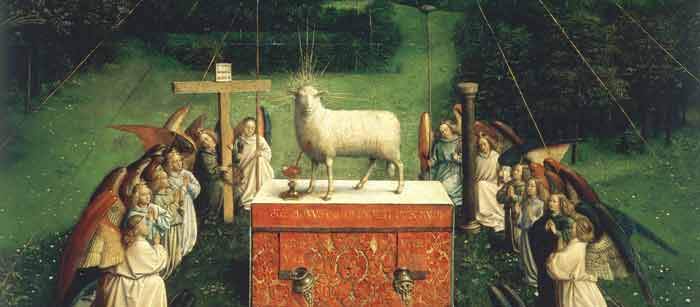
Fig. 7: Van Eyck, Lamb of God, Image Detail: Ghent Altar. Oil on wood, 350 x 461 cm
Cathedral of St Bavo, Ghenthttps://commons.wikimedia.org/w/index.php?curid=109213 [28.10.2024]
This image sets against each other contradictory concepts: static-symmetrical-ordered vs. dynamic; accidental situation vs. deliberate staging; documentation vs. sign; hyperrealism in body and space vs. symbolic charge. It sets these contradictions against each other in the unity of the painting.
Reference
Published March 2024
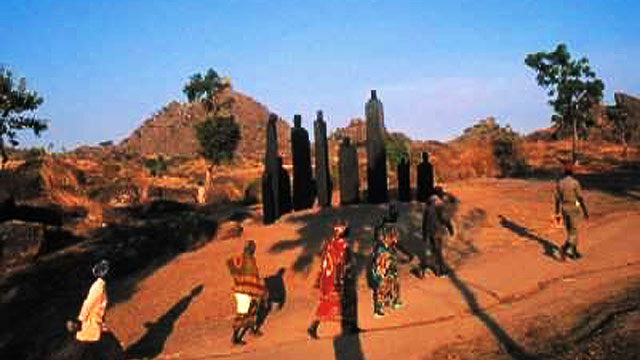
-
 Paul-Henri Souvenir ASSAKO ASSAKO
Paul-Henri Souvenir ASSAKO ASSAKOThe image is a photograph showing details of the French artist Christian Lapie’s public installations in 2001 in the city of Ngaoundéré, capital of the Adamawa Region in Cameroon. The work consists of five modules composed of nine figures, ranging between 150 and 450cm each and laid in a semi-circular radius of 1000 cm. The pieces are made of wood and placed vertically in an upright position. The upper end is shaped like a head, giving each piece the appearance of a human silhouette. Arranged like a gathering of people dressed in local traditional attire, called boubou (a long, loose-fitting garment worn by both sexes in parts of Africa), the works are aligned in a semi-circular arc.
The work’s detailed structure is closely linked to its title Djaoulérou, which means "traditional space, place of meeting and reception". The artist echoes customs in a context where the relationship between traditional practices and Islam remains ambiguous. Islam provides an opportunity for certain members of local society to acquire privileged positions under the auspices of religion. Religion’s role in the political game has proven to be so important that post-colonial politicians have laboured to maintain control of the religious sphere in every region. Religion presents challenges for politicians in terms of governance and control. Maud Lasseur (2005, 95), echoing this sentiment, maintains that: “During the colonial period and under the regime of President Ahidjo (1960–1982), Christian missions were thus contained to the south of Cameroon so as not to hinder the Muslim aristocracy of the Far North or thwart the unifying political project of the first Cameroonian president”.
The monumental character of the work, the rhythm and movement suggested by forms treated with little attention to detail, the variations in volume and the different dimensions of each silhouette make the installation look both impressive and expressive. Each individual group of statues, displayed at the same time in different places in the city, shows how the "mysterious objects" made by a foreign artist present unfamiliar traits regarding the city’s socio-cultural imagination. The work breaks taboos: an unusual appearance that creates artistic experience, tradition and beliefs, which have become subject to manipulation and political propaganda within the society.
The work’s destruction reflects the fragility of a slavish society instrumentalized by politically motivated religious arguments in the 2002 legislative elections in Cameroon. The fact that a French artist has carried out an unusual and iconoclastic installation project in this city is seen as a provocation, particularly by the Muslim cultural authority. This religious and political authority occupies a very influential social position as "guardian of the temple" (custodian of traditions) and is in a position to incite people to commit acts of such magnitude. In addition to setting fire to the works and proceeding to uninstall them, public authorities definitively closed down the Franco-Cameroonian alliance of Ngaoundéré because of the social unrest the works provoked. This cultural centre for Franco-Cameroonian cooperation had supported the artist's installation project.
The act of vandalism perpetrated on Christian Lapie’s work exposes Cameroon’s national society in search of landmarks. Art, and particularly sculpture, has played an important role in expressing belief systems. The cosmogonic universe and the world view of the populations that have succeeded one another in this territory have been revealed through artistic representation. The bold production and reproduction of anthropomorphic, zoomorphic, geometric and imaginary forms is typical of these societies. As in many countries in sub-Saharan Africa, art has helped what people see, think, imagine and believe (J.P. Notué, 2005). Because of the lack of critical understanding of their history and the changes they experienced, societies are confronted with major shocks that have an impact on their development. Among these shocks are an ambiguous relationship to religion. Its consequences are the religious and political manipulation that societies are sometimes subjected to. One historical reason for this is the attitude of missionaries who made no discernment in the positive values of the tradition and the absence of doctrine and deep convictions of these values (E. Mveng, 1985).
Cameroon’s colonial religious legacy is one of the most important sources of the ethical foundation of its society in the 21st century. The generalization of the religious profession of faith/conversion seems to have fostered a latent form of "alienation" among the urban society. There is a superficial knowledge of both the principles of modern culture and the traditional environment, two references whose slavish play of opposites have political stakes. In Cameroon, the policy of conviviality between Islam, other religions and local cultural practices implemented by Sultan Njoya in the Kingdom of Bamum presents elements of inspiration for a compelling form of social emancipation. The policy of inculturation and multi-confessionalism has favoured the cultural openness of society and preserved, for example, the sustainability of the region’s remarkable creative industry. Art, belief systems and politics are all values of cultural expression fundamental to society.
The work breaks taboos: the artistic experience created by its unusual appearance calls upon traditions and beliefs that have become subject to manipulation and political propaganda within the society.
References
- Mveng Engelbert. 1985, Histoire du Cameroun, tom 2, Yaoundé, Ed. CEPER.
- NOTUE Jean-Paul, TRIACA Bianca, 2005, Bandjoun, Trésors royaux du Cameroun, Milan, Ed. 5 continents.
- Maud Lasseur. 2005, in « www.cairn.info/revue-afrique-contemporaine-2005 ».
- Assako Assako PH.S. 2011, l’art au cameroun du XXe au début du XXIe siècle : étude des expressions sculpturales en milieu urbain, thèse de Doctorat/Ph.D. en histoire de l’art, Université de Yaoundé 1.
- www.christianlapie.net/oeuvres/16/djaoulerou
- www.christianlapie.net/mobile/news/326/.%20http:#news
- www.christianlapie.net
published February 2020

-
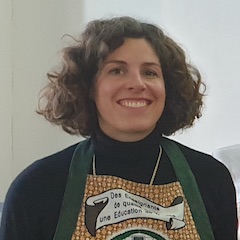 Annette Schemmel
Annette SchemmelThe photo at hand was shot in Paris in the 1920s. We are looking at a beautiful young woman with very fair skin who seems to have sunken her head on a table as if for a rest, while her left hand is carefully exposing a polished mask made from dark wood. The woman is Kiki de Montparnasse alias Alice Prin (1901 – 1953), Man Ray’s lover, a model for many painters and herself a successful artist. Supposedly, Kiki was central for the myth of the Montparnasse as an artistic enclave in Paris.3 The mask is simply “African” in the eyes of my pupils at first. I want them to learn that we are looking at a portrait mask4 of the Baule people in Ivory Coast. Pupils should also understand that such carved portraits served to honor an important member of a Baule society, a woman in this case. A dancer wearing a similar mask would incorporate the portrayed notable at the occasion of ritual dances, thus celebrating her achievements.5 This specific mask’s features are balanced and dignified, harmonious but not realistic, a point to which I will come back later.
Meanwhile I shall argue that Man Ray’s picture thrives on carefully staged contrasts. The title that has come to stick with this photograph hints not only at black-and-white photography itself, but also at the most obvious contrast, at the White and Black6 skin or surface of the picture’s protagonists. Yet there are further opposites linking the lady and the mask in the picture, namely the opposites of young, ultra-modern and lively versus ageless, “primitive” and inanimate, matt versus shiny, skin versus wood, a seemingly passive woman versus the upright face of the mask, holding versus being kept. The photo historian Wendy Grossman has described how these opposites relate: “Almost as if it were a direct cast, the vertical mask, with its shiny black patina, is a negative mirror image of the reclining model’s ovoid face, echoing her pursed lips, closed eyes, and tautly styled coiffure. Parallel symmetrical shadows extend beneath the two perpendicular forms, coupling face and mask in a shallow and austere space.”7
Clearly, Man Ray has smartly staged the Black and the White. By the time he shot this picture, Man Ray was making a living of object photography in Paris, then the world capital of fashion. It might therefore come as no surprise that this picture made its first appearance in an early print medium dedicated to beauty and fashion, the Vogue magazine. When the issue came out in 1926, everything “exotic” was fashionable in Paris, especially arts from (indirect) African origin, such as Jazz, Josephine Baker or, well, the mask in Man Ray’s photograph.8
Beyond its uncontested fashionable appeal “Noire et Blanche” unveils some deeper, more unsettling meanings, some of which I intend to unfold here. A simple reading is ready at hand if one places this artwork in the historical context of the colonial era. In 1926, the mask’s country of origin belonged to Afrique Occidentale Française. On this backdrop, the dreamy woman holding the mask in Man Ray’s picture appears to be a Freudian slip in the form of a photograph, an unconscious idealization of colonial domination. Are we looking at a personification of the imperial power of France carefully embracing its colony Ivory Coast?9
Next, we could follow a feminist lead towards interpretation. This photograph stages two females, whilst an important third actor of this mise-en-scène is invisible, the male photographer. Through his camera, the male artist is looking at the passive naked woman und at the artefact of a culture that is foreign to him. Obviously, the mask has become passive, too, once removed from its original context. In this reading, Man Ray’s photograph appears as a staging of the desire for submission – the submission of the idealized female and that of the cultural “other”. As viewers, we are lured into this voyeuristic pleasure, unless we take some critical distance.
Following a suggestion of some South African colleagues, we shall now look at this photograph through the lens of the Martinican author Franz Fanon. In his famous psychoanalytical text “Peau noire, masques blancs”, Fanon is pointing at the phenomenon of the essentializing construction of a Black soul (“l’âme noir”).10 Following Fanon, Man Ray’s photograph can be considered one of those efforts by European (and certain African) artists of the classic Modern era to catch hold of an imagined essence of Black culture. This effort needed to objectify Blackness in order to make this construct palpable and acceptable. Arguably, in “Noire et Blanche” the ’black soul’ lies in the hand of a white person and is reduced to an object, the sculpted mask. Furthermore, it could be argued with Fanon that Man Ray used the Blackness of the wooden object, the “noir” that is readily associated with the ‘continent of darkness’ in the collective imagination of Westerners,11 in order to highlight his girl-friend’s Whiteness. We know that contrasts help at intensifying and it is no secret that White is a color (of skin) that Europeans tend to associate with innocence and purity.12 Arguably, this racialized contrast of the “Noire” and the “Blanche” served to celebrate qualities that Man Ray projected onto Kiki de Montparnasse, his partner.
So far, I have tried to make clear that the artwork “Noire et Blanche” is not only a showcase of female attractivity, but that this photo also has a violent dimension to it because it relies on certain colonial mechanisms of distinction. As an art teacher, it is my ambition to make this picture’s ambivalence understandable for my pupils. I know that pupils are more likely to learn if they are allowed to make their own discoveries,13 for instance by exploring ‘real’ scientific data through the Internet. From our classroom, we can access the Metropolitan Museum’s online collections, which include a comparable portrait mask.
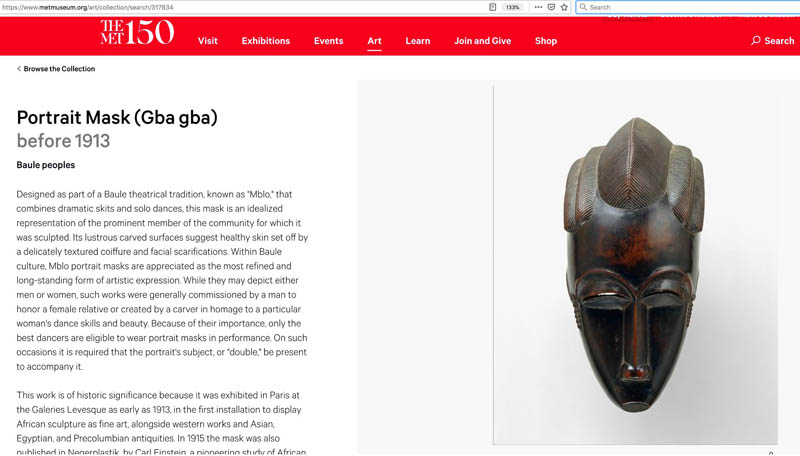
Website of the Metropolitan Museum, New York
Other than the black-and-white photograph by Man Ray, the museum’s more recent color picture unveils the fine shades of brown and red tones that are characteristic of the tropical wood used for Baule masks. Obviously, such masks are not Black in reality. Furthermore, pupils can learn from the provenance info that the Baule mask in the Met’s collection was famous amongst art lovers and artists in Paris and Berlin already before WW1.14 This insight helps to understand why Man Ray might have chosen a similar object for his photograph: artists tend to learn from each other.
As a continuation, I like to encourage my pupils to sum up the museum’s text about the characteristics of portrait masks by the Baule by means of notes in German language. In doing so, the learners realize that these masks are carved according to a complex canon of beauty, that the forehead is high for a reason, namely in order to represent intelligence, that the polished surface signifies good health and that a representation of a person can convey dignity even if the proportions of its face have been exacerbated. This is new to many youngsters, whose frustration with their own efforts at realistic drawing has shaped their preference for artists’ realistic skills. Pupils also learn from the online information that this mask can only be brought to live as part of a performance, thus discovering a problematic aspect of its preservation in a museum.
Coming back to “Noire et Blanche” with this new knowledge, my pupils realize that Man Ray’s photograph is concealing much of the knowledge that is available today. They understand that it is worthwhile to research background information for non-European art, even if this requires leaving their textbooks behind and going an extra mile with their foreign language skills. In the course of the classroom discussion that follows we are wondering why a Baule community would have let go of their precious mask, a question leading to recent restitution debates.15 Furthermore, the teenagers understand that the coquettish presentation of the mask in the hands of a naked European woman might be read as a sign of lacking respect by members of its culture of origin. At this point of the discussion some pupils have experienced a change of perspectives. This experience of assuming a position previously perceived as ‘other’ in the course of a lesson is the very purpose of our engagement with this artwork at school, arguably it is also the purpose of looking at art altogether.
Let me summarize this approach. Comparing Man Ray’s photograph “Noire et Blanche” with the mask from the Metropolitan museum’s collection is a way to scrutinize a canonical picture from a critical perspective without denying the aesthetic appeal of the historic photograph. By way of this lesson I hope to enable changes of perspective and to build sensibility for post-colonial readings of pictures amongst pupils. Taking a bold stance, I shall claim that such lessons are conducive to a more general type of visual competence because I like to think that my pupils’ experience with the implications of this attractive historic picture might encourage them to also critically scrutinize any other picture in the future.
References
[1] For a thorough photo-historical analysis read Wendy A. Grossmans insightful article “Unmasking Man Ray’s Noire et blanche”, American Art, Vol. 20, No. 2 (Summer 2006), pp. 134-47.
[2] For instance, Man Ray is mentioned in the widely used text-book Epochen der Kunst. Von der Moderne zu aktuellen Tendenzen (Hsg: Robert Hahne, Oldenburg Schulbuchverlag GmbH, 2013, S. 150/51). In this book, information about him and the photo “L’Enigne d’Isidore Ducasse” (1920) are featured under the header of „Fotografie und Film im Surrealismus“. It can be argued that „Noir et Blanche“ is surrealistic as well, since it seems to be illustrating Lautréamonts famous phrase “beautiful as the chance meeting on a dissecting table of a sewing machine and an umbrella” (Lautréamont alias Isidore Lucien Ducasse, „Die Gesänge des Maldoror“, 1874.), with Man Ray’s “chance meeting” bringing together a white woman and a wooden mask.
[3] en.wikipedia.org/wiki/Alice_Prin (last accessed on August 26, 2019).
[4] Wendy A. Grossman’s article “Unmasking Man Ray’s Noire et blanche leaves no doubt that the mask in the picture is actually an airport art version of a Baulé mask, by the way (p. 136).
[5] Collection Records of the Metropolitan Museums (Baulé Masken), www.metmuseum.org/art/collection/search/317834 ((last accessed on May 3rd, 2017), also https://www.metmuseum.org/art/collection/search/319512 (last accessed on August 26, 2019)
[6] In this text, I will spell Black and White with capitals in order to highlight the cultural construct of Race.
[7] For the complex history of the title see Wendy A. Grossman, “Unmasking Man Ray’s Noire et blanche”, pp.140.
[8] More about this fashion in en.wikipedia.org/wiki/Josephine_Baker (last accessed on August 26, 2019).
[9] Research on Man Ray does not support this easy hypothesis however. In Wendy A. Grossman’s article from 2006, the origin of the photograph is described as an open-ended artistic process partly sparked by commercial interest, partly by a collaborator, but not by political intention. However, I would like to argue that art works tend to transmit more or less unconscious convictions of their authors and their peers, which makes of artworks valuable witnesses of their times.
[10] Frantz Fanon, “Schwarze Haut, weiße Masken”, translated by Eva Moldenhauer, Wien: Turia + Kant, 2013, p. 14, 147.
[11] Fanon makes this point in “Schwarze Haut, weiße Masken” (2013), p. 158.
[12] “Symbolik der Farben, Formen, Zahlen” in Lexikon der Kunst, Bd. VII. S. 153-154, E.A. Szeemann Verlag, Leipzig 1994.
[13] I am here referring to pupils from eleventh grade of the Bavarian Gymnasium, whom the syllabus obliges to explore aspects of the body in art during half a year.
[14] Collection Records of the Metropolitan Museums (Baule masks), www.metmuseum.org/art/collection/search/317834 ((last accessed on May 3rd, 2017), also https://www.metmuseum.org/art/collection/search/319512 (last accessed on August 26, 2019)
[15] For a thorough introduction to this question read Felwine Sarr’s and Bénédicte Savoy’s “restitution report” commissioned by the French state. http://restitutionreport2018.com/ (last accessed on April 1, 2020).
published April 2020
Sound track / Hörimpuls Man Rays Noire et Blanche, 2018 (Schemmel): Link

-
 Mahmoud Malik Saako
Mahmoud Malik SaakoThe Koma figurines did not only enrich the stock of African artwork but evoke the minds of a great culture represented or embedded greatly in these art pieces. These figurines have been classified into anthropomorphic (the use of human features), and zoomorphic (the use of animal features), based on the stylistic representation while some are both anthropomorphic and zoomorphic (they possess both human and animal features). They are some of the anthropomorphic figurines that have one head and two faces or one body with multiple heads while some have a head with a conical shape. Those anthropomorphic coned figurines are the most common types and are consisting of a head with a long conical neck or body.
The Koma figurines could be equated to those of Nok and Ife (in Nigeria), Sao (around Lake Chad), the Akan funerary clay figures (in southern Ghana), and the Jenne and Bankoni clay figurines of the Inland Niger Delta (in Mali). Beyond their artistic significance and historical products, the Koma figurines have generated some interest among intellectuals in and outside Ghana including antique dealers.
Before the scientific investigations commenced in the 1980s and 2006 onwards, the communities within this geographical area known as "Komaland" were encountering or recovering these terracotta figurines when they were digging for soil to build their homes. The people then referred to them as kronkronballi which literary means "children from an old-time". These figurines are either found in house or burial mounds within the area. The culture of the current inhabitants of the area where these figurines are found do revere their ancestors, and any disturbance of the ancestral graves or the removal of any burial goods either intentionally or accidentally must be expiated by sacrifices, and all the grave goods are reburied at the same place. Since the people are far remote from the creators or ancestors of these figurines, many of the damaged ones were either thrown away while a significant number of them were taken home and given to children as toys.
Moreover, art dealers in Ghana and West Africa recognized the commercial value of these Koma figurines long before the scientific investigations by the first anthropologists, archaeologists, and historians. These Koma figurines were, therefore, sold at the various art markets in northern Ghana (in Bolgatanga at the craft village) and southern Ghana (in Kumasi and Accra art centers) to foreign tourists. It is through this medium that Koma figurines have found their way into many European and Western museums.
Furthermore, scientific excavations in the 1980s and the subsequent excavations in 2006 onward by a team of archaeologists in Ghana and abroad, have attracted the attention of the world through conferences and publications. The Koma figurines were initially appreciated based on their aesthetic values but the subsequent archaeological excavations subjected them to more rigorous scientific analysis and historical classification such as social, cultural, political, and environmental. The scientific excavations have also to some extent put a stop to the numerous lootings of the sites that were hitherto very rampant.
The archaeological investigations in recent times and based on radiocarbon analysis from pieces of charcoal dated the site between the 6th and 14th centuries AD. But further investigations are still ongoing to identify the authors or creators of this supposed complex civilization in northern Ghana though, parallel has been made to the Lobi in Ghana and Burkina Faso.
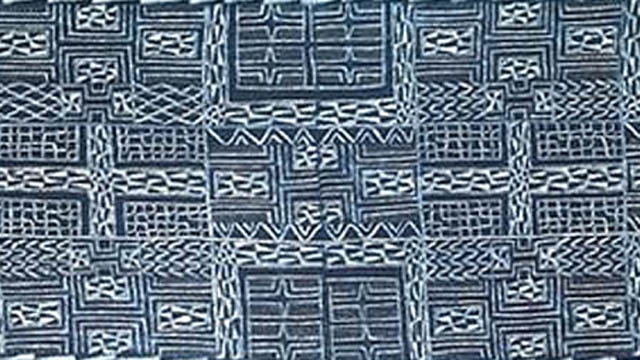
-
 Osuanyi Quaicoo Essel
Osuanyi Quaicoo EsselIn my encounter with the exhibits of the Permanent Exhibition of the African Collection in the Museum Fünf Kontinente, one of the African textile collections that striked me from a distance, and possess high tendency of inviting viewers attention is the ndop fabric. I moved closer to the exhibit to observe its uniqueness in terms of its structural and surface characteristics. From my curious observation, I realised that the ndop fabric has simple geometrical linearity and patterns, yet, spiced with complex dynamism of the arrangements of these patterns that evoke the artistic principles of variety, harmony and technical constrast. This treatment breaks monotony and creates multi-sectional visual interest in the fabric design despite its monochromatic colouration. These observable details, characteristic of authentic African fabric, pulled my visual curiosity to the exhibit. Indeed, it is an epitome of authentic African fabric.
Africans had long developed unique structural and surface decorative techniques for creating fabrics. Structural decorative techniques concern itself with the basic forming or construction of the fabric. Weaving, bonding, netting, lacing and felting include the structural decorative technique. Surface decorative techniques deal with the colourations and other embellishments to improve the surface quality or appearance of the fabric. Examples are dyeing, painting, printing, embroidery and applique. The ndop fabric was struturally woven with handspun cotton yarns in plain weave format in the form of stripes. The stripes were joined together with the aid of a needle to form a wide sheet of fabric after which the sheet of fabric was subjected to resist dyeing to create attractive patterns. In resist dyeing, portion of the fabric are prevented from dye absorption. Techniques used in resisting dye penetration include tying, tritiking (sewing), waxing, folding, twisting and coiling, and or a combination of these techniques. In the case of the ndop fabric, tritiking technique was used where raffia fibre cordage was used to stitch the desired patterns such that it could resist dye penetration after which the fabric was immersed into indigo dye solution locally extracted from plants. After the required time for dyeing, the fabric was removed from the dyebath, rinsed, dried and unstitched to reveal the patterns.
The skilful use of regular geometry in seemingly irregular and asymmetric arrangement style complemented by the handmade rendition, the technical finesse in stitching to create the intricate pattern and the entire arrangement of the geometrical shapes in simple repetitive format create high visual appeal of the surface quality of the fabric. Per its visuality, one may see it as a printed fabric, yet, it was created using resist dyeing effect. The slight unevenness in the dye absorption resulting in patchy shades of the indigo at certain portions of the fabric adds to its creative uniqueness. The varying border designs of the fabric bond well in creating a sense of unity in the entire composition.

Ndop fabric. Detail. (© Museum Fünf Kontinente / Photo Ernst Wagner)
Besides the observable trenchant characteristics of the fabric, it also has social and cultural contexts in the Bamum society. The ndop is more than just a fabric in terms of its usage and communicative significance. The fabric is symbolically linked to death, afterlife, and powerful spirits connected to life. Consequently, it is worn during funerals and traditional religious rites. Apart from this, it is worn for its aesthetical reasons.
The ndop fabric falls within the repertoire of indigenous and authentic African fabric creation and decoration culture, which include the Korhogo Cloth (Ivory Coast), Adire (Nigeria), Bogolanfini (‘mud cloth’ from Mali), Kente and Adinkra (Ghana), Smock or fugu (Ghana) and Dogon Cloth. Common to these fabric printing technology of Africa is that the fabrics used are usually cotton, with ocassional usage of silk or velvet. In the case of Ghana, Adinkra printing is made with cutout stamps which are dipped into dyes and transferred on the fabric to register the designs while in Kente and fugu, the hand spun cotton yarns are dyed in different colours and used for weaving. The ndop is dyed. Availble records indicate that indigenous dyeing of fabrics in Ghana, in many instances, were done by uniform application of dyes to the entire fabric. This means that fabrics were immersed without resisting some portions. Kobene (brick red) and Birisi (blue-black) fabrics of the Asante people of Ghana are examples.
As a textiles and fashion educator and artist, I guide learners to examine the hand-made indigenous fabric decorative characteristics of Africa including the ndop fabric in order for them to understand and apply them in their fabric design. In this sense it inspires my fabric designs and that of my students. I also empower them through my teaching with historical knowledge about the contributions of Africa to the global textiles design culture. This is because the unique patterns and characteristics found in the repertoire of indigenous and authentic African fabric technological culture have been imitated with computer effects and printed by some European and Asiatic fabric brands, mostly sold in Central and West Africa. These foreign brands have been deceptively labelled with an umbrella term, African prints, to lure and deceive buyers. The ndop fabric has valuable educational relevance in teaching and learning and historical understanding of African fabric making technology in this context.
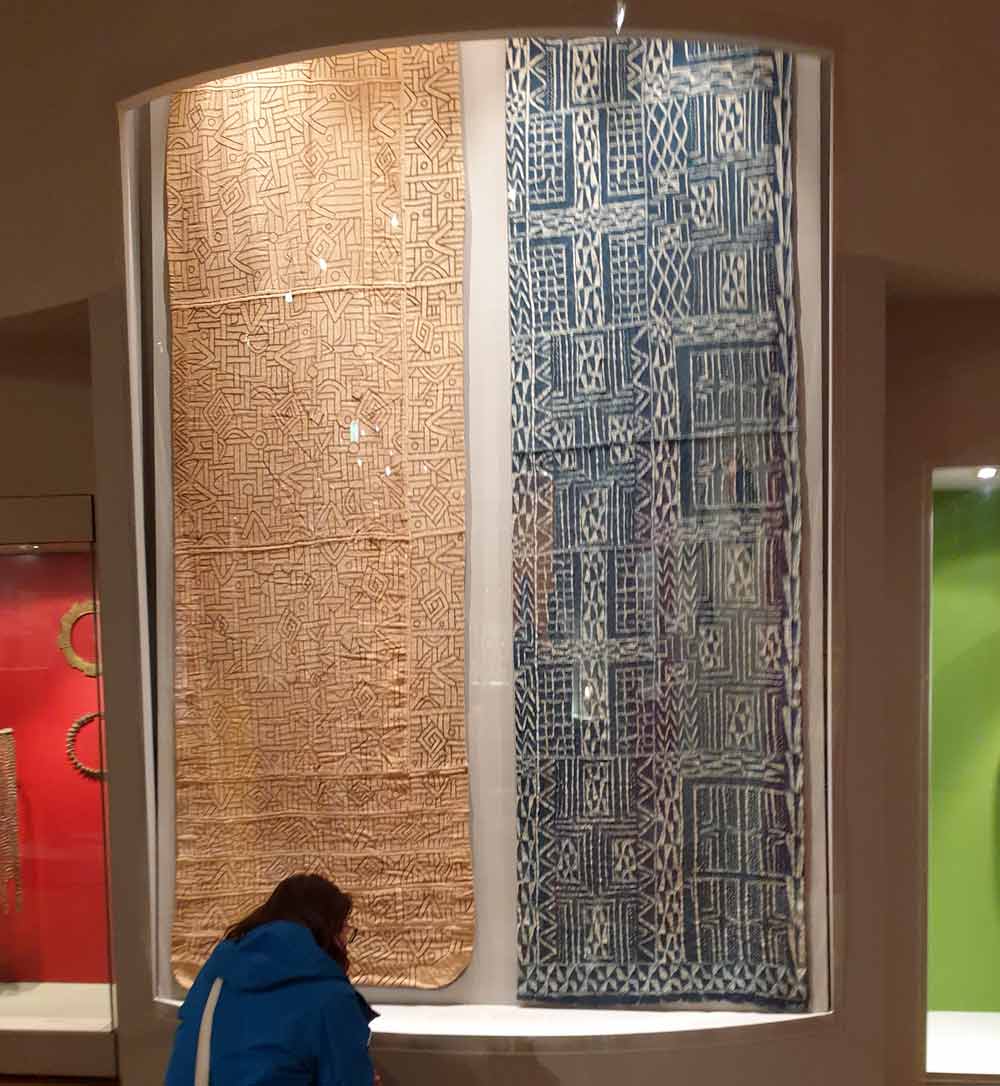
Presentation at the museum 2021 (Photo Ernst Wagner)
This article is part of a gallery: Perspectives from Ghana on Museum Objects in Germany. Published in January 2021
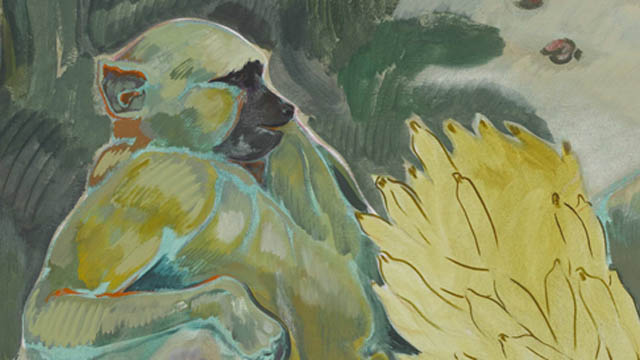
-
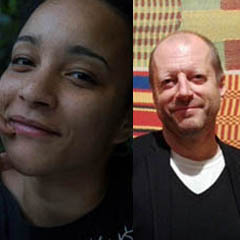 Leonie Chima Emeka & Stefan Eisenhofer
Leonie Chima Emeka & Stefan EisenhoferBorn 1984 in Nairobi (Kenya), Armitage received his artistic training in London (UK). Living and working in both places today, he praises each of these cities as substantial to his creative practice. His inspirations spring from many different sources – from political events, mass media affairs and pop culture to personal memories and experiences as well as from Eastern African and European folklore. He merges together the stories and experiences of two cities and weaves them into a narrative of interregional interest. Often starting with Kenyan local myth he is developing global tales of political critique and rebellion concerning global demands on democracy, data protection, ecological and human rights — always overlaid by the meaning of the break between the “West and the Rest”, between human and un-human, between the exploitation of life and its inviolable dignity. In his work, Armitage investigates the idea of Africa as a mirror for Western phantasies and success stories of the Global North: the wild and untamed nature on the one side and the violated racialized bodies and political and ecological catastrophes on the other.
The painting “Baboon” was on view in the exhibition "The Paradise Edict“ at Haus der Kunst in 2020 as part of a series of five oil paintings depicting tropical animals. On tropical background various monkeys in erotic posture invite the viewer to an examination of sexuality at the boundaries between animality and humanity, erotics and exotics. Also the “Baboon” strikes the eye with its suggestive sexuality. In the clearing of an overgrown rainforest, the monkey lies on the ground in a very human attitude. A bare stone supports its right arm as if the ape was resting on a natural chaiselongue. Within the apparently wild environment, the animal seems rather cultivated.
The baboon oscillates between human and animal; not only in its posture but also in its physique: Feet and face are animal, while the rest of its body looks almost human; it has no fur or hair but pronounced muscles on his bare chest. Despite its muscles the ape’s body looks youthful and slightly lanky. It reminds to Michelangelo’s David for which it is commonly known that the legs and arms are extra-long compared to his body in order to mark his youth. Like a juvenile not yet fully grown the baboon, too, has long arms and legs. Neither a child nor yet a man, both an ape and a human body, the baboon hovers between child and man, between man and animal, between innocence and animal sexuality.
Instead of the characteristic fig leaf of early modern European sculpture, there is a large bundle of bananas between the monkey's legs. The individual bananas, sketched on the yellow surface, are quite phallic in shape and the banana bundle tends to overemphasise the male sexual organ, while the ape’s physical penis is hidden behind it. The banana is probably the most common fruit in the Global North that still bears the tag ‚exotic‘. It is not the monkey’s body, that is sexual; but the bundle of bananas both hides and emphasises the phallic and states an allegory for the conceptual connection between exotic and phallic.
Its absence makes it ever more present, as its leaves the concretisation of sexuality to the viewer’s imagination. In fact the image could be both innocent or sexual, as not only the penis is hidden behind the bundle, but also the ape’s left hand that reaches out to his underbelly. We can not see, but only guess where it rests, and what it is doing there. In his suggestiveness Armitage opens a space of confusing erotic tension and a critique of the sexualisation of race. With the figure that hovers between youth, man and animal, Armitage challenges the relations between black masculinity and sexuality in the Global North. It was Franz Fanon in "Black Skin-White Masks“ (1952), who once posited, that in European Subconscious "the Negro“ is the genitals par exellence, reduced to a giant penis. In this painting Armitage investigates the complex relations between blackness and phallus in Western concepts of masculinity.
Like many of Armitage’s paintings also the “Baboon” presents an overlay of heaven and hell and is taking up the title of the exhibition “Paradise Edict”. They are referring to African and European as well as global paradise fantasies and hopes. They are aiming often at an ordered, decreed and prescribed paradise. They reveal the mandatory and obsessive aspects of these Garden of Eden-Imaginations, disillusioning global Out-of-Africa-fantasies, distorting eternal and natural laws to man made illusionistic laws.
Armitage uses lubugo, a fabric made from fig-tree bark, in lieu of canvas for his paintings. This cloth is Ugandan in origin and has a long history of social, religious and political meaning and use there. Armitage first came across lubugo in 2010 on a Nairobi tourist market. The use of this now somewhat Pan-East-African-material corresponds with his visual vocabulary. Armitage combines European with Eastern-African materials, forms and strategies and waves them into complex, yet alluring compositions that remember the entangled history of painting through the ages and continents and rewrites new relations in between.
published January 2021
About Michael Armitage's initiative in Nairobi "Nairobi Contemporary Art Institute (NCAI)" see Link.
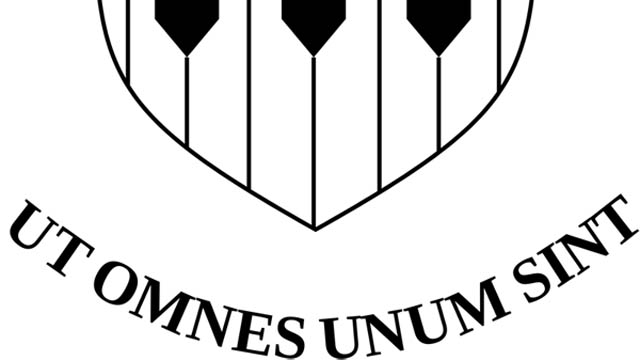
-
 Patrique deGraft-Yankson
Patrique deGraft-YanksonSchool crests, school logos or school emblems as they are variously referred to are a popular feature in the functions of all academic institutions in Ghana. They are normally designed to visually reflect the key ideologies and philosophies upon which educational institutions thrive. In determining a logo for academic institutions therefore, efforts are put in place to ensure that they serve an appreciable level of visual representativeness. By this, school logos in so many ways establish emotional connections with parents, students and other stakeholders, whose interpretations and perceptions determine their level of confidence and trust in the institutions.
This logo, by its very visual appeal, informed by the familiarity of the key compositional element and simplicity, generates a point for discussion. Moreover, the popularity and the history of Achimota College always makes it an important destination for various studies pertaining to senior high school education in Ghana. In my current interest in the study of icons and symbols therefore, the Achimota School crest comes handy, worthy and accessible.
The designer of the Achimota School crest is not really known as most of the literature on the school's history is silent on the subject. However, judging from the fact that the key concept behind the logo emanated from a popular quote from Dr Emmanuel Kwegyir Aggrey, the Old Achimota Association attributes both its origin and design to him (OAA, 1973). The creation of the Achimota School crest follows strictly the conventional crest design procedures which inform the design of several school crests in Ghana. It is composed of a classic narrow base shield, with the all-important motto of the school, ut omnes unum sint (Latin phrase meaning ‘that all may be one’), rendered in an arc form below the shield to provide a mantling and support of a sort to the design. In a rather minimalistic fashion, the key element of the design which also represents the main ideal of the school (the piano keyboard) has been rendered in amazing level of simplicity which makes it easy to perceive and reproduce by all graphic reproduction methods.
By this design process, the Achimota school logo offers a depth of meaning without being too literal in its composing elements. It has a pleasing contrast between dark and light, and connection to the existing school structures. Most importantly, the logo has sustained the semiotics and narratology which students, parent and stakeholders have always responded to since the establishment of the school.
It can be said that the logo of the Achimota college is more than a visual representation of the ideals of an educational institution. By mere consideration of the diversity in the caliber of people who masterminded its foundation, the school’s logo could indeed be described as the very foundation upon which the school was built. The logo seems to echo silently a belief that underscores the essence of peaceful coexistence of all manner of people, as exemplified in the collaboration of people of different colours from different parts of the world coming together to establish an institution of that caliber. It must be noted that the use of black and white keys of the piano to signify the harmony that comes along with peaceful co-existence of people of all races mean a lot more than anti-racial advocacy. It is obvious that Aggrey, drawing from his own experiences as a black young man who has been able to successfully attain the feats that could be equaled to what any white young man of his age could attain, was drawing the attention of the African youth to their own strength and capabilities. This is because Aggrey lived in a time when the “black man” looked up to the “white man” as an embodiment of all wisdom and custodian of all the goodies that mankind needed for their existence. The idea that he, as a black young man could attain a higher education just as the white man had not been very much considered. Aggrey making himself a case for the possibility of the black race mixing up perfectly with the white race to produce something good therefore seemed to be the underlining principle for the creation of the logo of the Achimota school.
The question of Aggrey creating this logo not for some cooperate body or a church is also an interesting factor to consider. As far back as 1924, Aggrey sought to established the efficacy of ‘education’ in the promulgation of ideals, principles and philosophies. This is deducible from the efforts he put in co-founding the Achimota College with Sir Frederick Gordon Guggisberg and Rev Alec Garden Fraser; opening up the college for both male and female; and ensuring that teachers were made up of blacks, whites, males, females. This indicates Dr Aggrey’s confidence in education as an important avenue for the promotion of peaceful co-existence and harmonious living. He believed strongly that quality education would contribute to balance and a peaceful society, and promote his conviction that ‘black keys of the piano give good sounds and the white keys give good sounds, but the combination of the two gives the best melody’. What a beautiful reason for all mankind to live as one!
Considering ongoing efforts towards the achievement of a coherent global community, as well as the premium laid on education as a single unit that can be used to achieve the sustainable development goals, it could be concluded that the relevance of the Achimota school logo is important today more than it has ever been. It therefore makes a whole world of sense to argue that the logo of the Achimota school could be considered as a strong icon for well-balanced education and a perfect advocate for education for sustainable development (ESD).
References
- Old Achimota Associstion (1973). Dr Aggrey. Retrieved August 3, 2020, from Retrieved 03 https://sites.google.com/site/oaa1973akoras/home/founders/dr-aggrey
- Wada, K. (2010). Achimota School. Retrieved August 3, 2020, from https://www.blackpast.org/global-african-history/achimota-college-achimota-school-1924/
published August 2020
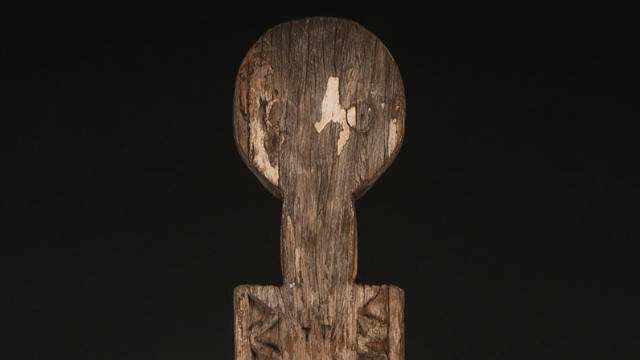
-
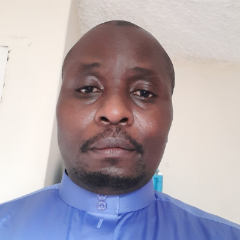 George Juma Ondeng
George Juma OndengGiven the ownership structures of museums in countries such as Germany, the local politicians will never support repatriation requests if they still solely understand objects as pieces of art/craft. It is high time we appreciate spirit, soul and body of these objects. To illustrate this point, I will use the three funerary posts, the vigango (singular kigango) from the Giriama Community in Kenya which are part of the museum collection in Munich. Museum audiences and art enthusiasts in the Global North admire the artistic side of these objects. The truth is, they are not objects according to the producing community. Vigango are souls of the departed elders and thus an integral part of the Mijikenda community. Vigango are also significant to the Giriama as a way of communicating with Mulungu (God). The vigango serve as media of communication with Mulungu since they are no longer trees (wood) but humans (spirits). The vigango are very tall and are made largely for those who have attained the highest status in the society. Vigango are anthropomorphic carvings. They are made using valued indigenous species of hard wood through a lengthy ritual process. There are also strict rules to handle a fallen kigango. Thus their presence in museums collections are highly contestable!
Perhaps Western museums ought to exhibit the processes involved in making of these objects more. To have a better understanding of these objects it is important to learn how they are used in their original community. To make a kigango, an appropriate hardwood tree is selected and prayers made to sanctify it and transform it from being a tree to a human spirit. Vigango are normally handled with great care usually wrapped with white cloth and erected when it is still dark (around 5am).
The vigango provide protection to the community and ensure the education and progress of the family and members of the community in general. The living Mijikenda believe that the dead members of their community not only have influence on them but also that their special needs must be met for which they would receive blessings of good health, abundant rainfall and bountiful harvest. Otherwise they would cause trouble to them when neglected as indicated by the presence of termites or snakes in the house. When a kigango falls down it is left to rot away, under no circumstance it can be picked up and given to a museum or treated as part of a museum collection. A new kigango would be made to replace it. They can be erected somewhere in the kaya or in homestead and as much of the kigango is under ground as above the ground.
Understanding vigango therefore should move beyond the motifs and patterns shown in them and look at the cultural significance and what they represent in Giriama community. As human spirits, Vigango are revered in Kenya and thus treated as human remains. Therefore no one dares to tamper with the fallen ones for fear of the repercusions. Besides, it is locally known in Giriama society that those community members who were complicit in removal of vigango for sale as works of art met early death. While such assertions may be hard to ascertain, it shows how valuable they are to the local Giriama community. It is worth noting that this community reveres the remains of their elders in exactly the same manner they treat vigango. Which brings the question, if they are considered as human spirits by the makers, should museums keep them in their storages? Should they not be treated as part of human remains because the process of working the trees into vigango transforms the trees into anthropomorphic characters with special influence over the living?
If that was to happen, first, the only vigango that should remain in Western museums could be those purposely commissioned by holding museums for purposes of advancing their artistic values. If such a kigango is to be exhibited, it should be accompanied with a community documentary which gives the community an avenue to explain to the world the role of the object in their community including changes through time and space.
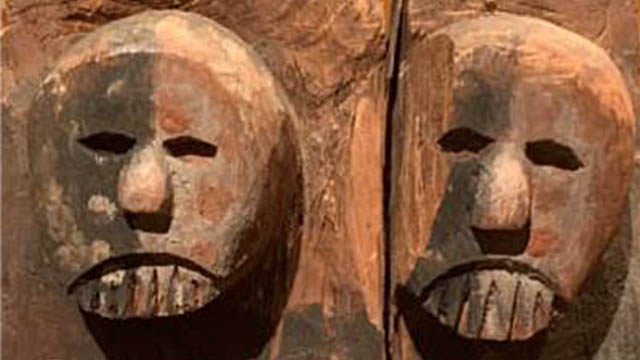
-
 Patrique deGraft-Yankson
Patrique deGraft-YanksonExploring an Enigmatic Piece of Traditional Cameroonian Sculptur
The Veranda Post found in Museum Fünf Kontinente is an exemplification of the extent to which indigenous Africans mutually reinforced socio-religio-cultural existence and expressiveness of form through sculpture. Various examples of these artefacts abound in the collections of African plastic artforms found in many museums across the globe. The beauty in experiencing, analysing and speaking about this artwork (as well as many of its kind), lies within the absence of authenticated historical and analytical literature on them. This makes it possible for the observer to exert complete authority of personal perception and interpretation devoid of any fixed attitude that dictates, interfere or curtails aesthetic enjoyments, interpretations and judgements, as attempted in this presentation.
With the dimensions of 199 x 60 x 50 cm, the Veranda Post found in Museum Fünf Kontinente is one of the numerous examples of the African artistic expressiveness, confirming the artistic prowess of the traditional African. Examples of these artefacts abound in the collections of African plastic artforms which record indigenous religious beliefs, practices and performances that date back from the beginning of African history.
As typical of most indigenous African sculptures, this work is not only uncaptioned, but the artist/creator is not known. What is known, however is that, its peculiar characteristics and style makes it easily identifiable and representative within the milieu of popular African sculptures. According to the Museum Fünf Kontinente records, this work was collected from 'Kamerun'. 'Kamerun' was an African colony of the German Empire between 1884 and 1916, which was located in the region of today's Republic of Cameroon (Wikipedia, 2020). Comparing the characteristic features of this sculpture with similar sculptures described by some art historians as Veranda Posts created as part of ancient African monumental architectures found in the Cameroons Grassland (Willett 1981) therefore, it is not difficult place it within that category. Hence its caption.
As can been seen from similar ‘posts’ and judging from the elaborateness of the images created on them, the major reason for the production of these posts was more to afford the sculptor or sculptors the opportunity to decorate the buildings with stories, rather than serving as supports (see figure 1).
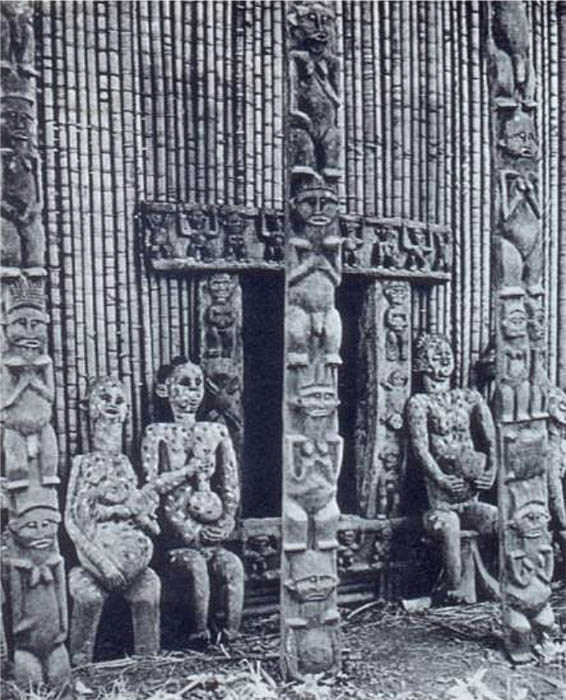
Figure 1: Ancestor statues, carved door-frame and verandah posts (Source: Willett 1981)
As said above, the beauty in analysing and speaking about this artwork (and many of its kind), lies within the absence of historical and analytical literature. The fact that this makes it possible for me (and for that matter any other observer) to exercise personal powers of perception and interpretation without any fixed attitude to direct or curtail their aesthetic interpretations and judgements made it my object of choice for this project at the Museum Fünf Kontinente.
Going by Margaret Trowell’s generalisations about African art, this Veranda Post can be classified under the ‘spirit-regarding’ art. Like many others of its kind, this work, which has front and back views, is flanked with human and other figures, ostensibly those of ancestors and is symmetrically disposed about a vertical axis, rendering it frontal at both sides.
Analyses of the images created on this pole reveal striking similarities between the age old traditional religious practices of the African and the Western religious beliefs and practices brought in by the earlier missionaries.
At the direct look of the object from the front (as it has been positioned at the museum, but actually one of its two sides), a prominent kneeling figure with hands clasped together unto the chest (much like the praying hand) can be seen in a pose that looks very much like the kneeling praying postures at Christian worships. To the African, this posture is not only assumed at prayer sessions as a visual image of submission to God’s authority, but is also exhibited as a sign of respect, humility and total surrender to a superior authority. For the sculptor to present the kneeling man as a central figure and subsequently rendering all other human figures in similar submissive postures therefore makes the theme of prayer, submissiveness and spirituality very strong in the composition.
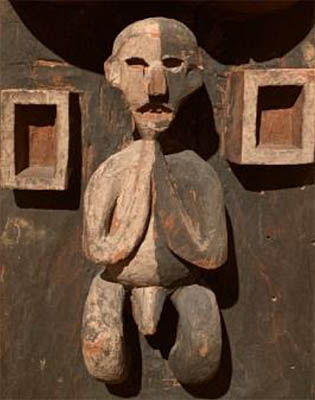
Figure 2: The kneeling or praying figure
The kneeling man is placed right below two human faces whose prominence and positioning easily pass them for elders, superiors, or better still, ancestors. Before the ancestors, all supplications are made, and through them, request are carried through to the supreme God.
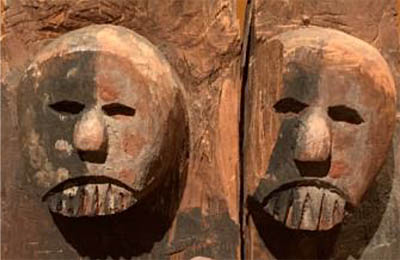
Figure 3: Ancestor figures
The importance of the two faces and emphasis on their superiority is further strengthened by a strong demarcation between them and the kneeling man through a thick rigid contoured line that forms a partition between the elements. This could be interpreted as a spiritual borderline that separate the spiritual world from the physical world. Generally, the African believes in the existence of the physical and the spiritual worlds as separate entities and this demarcation clearly depicts this belief. Also worthy of notice is the orientation of the demarcating border which rhymes with the praying hands of the kneeling figure, thereby visually connecting the figures. This carefully chosen placement of the two faces in the composition alludes to the supremacy of the ancestors and their exclusive existence in the after world as well as their connection with humans.
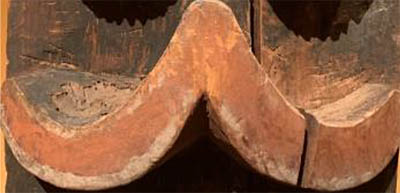
Figure 4: The spiritual borderline
Another striking imagery is created with the placement of a very visible image rendered in concentric circles. Among many African ethnic groups, the circle represents completeness, holiness, perfection and other such attributes ascribed to the supreme being (God). Among the Akan people of Ghana, for instance, the Adinkra symbol called Adinkrahene (king of Adinkra symbols) is presented as concentric circles. This symbol represents authority, leadership and charisma. The sculptor most likely created a bull’s eye of this symbol as an indication of exactly where this particular post belongs. The post could possibly be one of the furnishes for a palace or the abode of a traditional priest. This could also suggest the likelihood of the prominent kneeling figure being the King or the chief priest. Considering the atmosphere created by these symbols, the circle, with the kind of prominence it exudes could also represent the omnipresence of the supreme being, thereby heralding the people’s belief in the iniquitousness of God and His closeness to mankind.
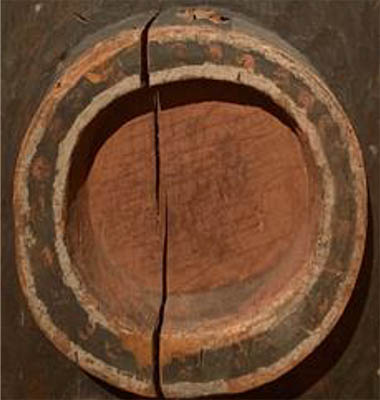
Figure 5: The concentric circles
Other recognizable images of animate and inanimate objects in the work include crocodiles, lizards and geometric shapes. Whilst it is likely that the geometric figures may have been deliberately presented to create balance, simulate a built living environment and arouse aesthetic sensibilities, the images of animals like those of the crocodiles have significant meanings as far as African culture and belief systems are concerned. Among some ethnic groups in Africa, crocodiles are believed to be the souls of ancestors who come back to live with men. Examples are the crocodiles in the Crocodile Pond at Paga in the northern part of Ghana who virtually live peacefully among the people. There are numerous African stories about crocodiles coming to the aid of men to either protect them or lead them to safety. Their inclusion in this particular work therefore is to establish the existence of spirits among men, especially as humans pray to seek their guidance and protection.
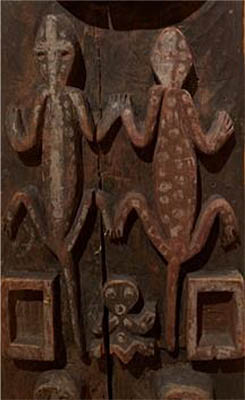
Figure 6: The crocodiles
Considering where it was created and where it is located now, as well as the current effort towards extracting a meaning out of its symbolism, this veranda post and many other such African artefacts in several museums around the globe have demonstrated how images and symbols resonate relationship between cultural practices around the world. The confluence of symbolic interpretations of the icons in the traditional African religions and the Euro-Christian religion, as depicted in this veranda post, gives justification to Africa’s unquestionable acceptance of Euro-Christianity and all the associated visual cultural practices.
For comparison, also read Karin Guggeis' analysis of this object here.
References
- Roy, C. (2019). Signs and Symbols in African Art: Graphic Patterns in Burkina Faso. Signs and Symbols in African Art: Graphic Patterns in Burkina Faso. https://africa.uima.uiowa.edu/topic-essays/show/38?start=13
- Wikipedia. (2020). Kamerun. Kamerun. https://en.wikipedia.org/wiki/Cameroon
- Willett, F. (1981). African Art. London: Thames and Hudson.
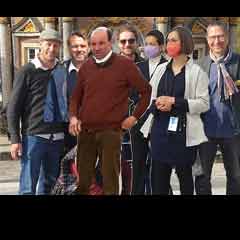 ISB_Team
ISB_TeamThis 'Veranda Post' is variously referred to (mostly in relation to its architectural-functional context) lintel or "te ken dy dye" (in the local Bandjoun language - PHSAA), porch post, house front pillar, post, cult house post (M5K, p. 17), Cameroon post / family crest (Macke at M5K, 13, 24). Post, however, in the sense of sign (post-it) is suggested by PdGY to address the communicative function. Other designations do not address the function, but limit themselves to the given, perhaps to avoid any pre-interpretation: 'sculpted wooden block' (Kecskési 1999 n. 108) or 'large carved square wooden block' (Kecskési 1976, p. 22).
Object biography: The object was taken before 1893 by Max von Stetten during expeditions on the Bamileke Plateau (south-western Cameroon), where it was presumably part of a meeting house of a confederation. Stetten (1860-1925) was German commander of the Kaiserliche Schutztruppe for Cameroon until 1896. Cameroon was a German colony at that time. The exact circumstances of how the object came into Stetten's possession are unknown, as is its original location and context.[2] In 1893, the Royal Ethnographic Collection acquired the pillar as a gift from Stetten.[3] In 1912, a photograph of the pillar was published in the Almanac of the Blaue Reiter. It is currently on display in the permanent exhibition in the Museum Fünf Kontinente Munich in a niche - a mirror allows a view of the second side (see Fig. 2). Along with other objects from the collection, it is currently the subject of a transnational project on their provenance (GI).
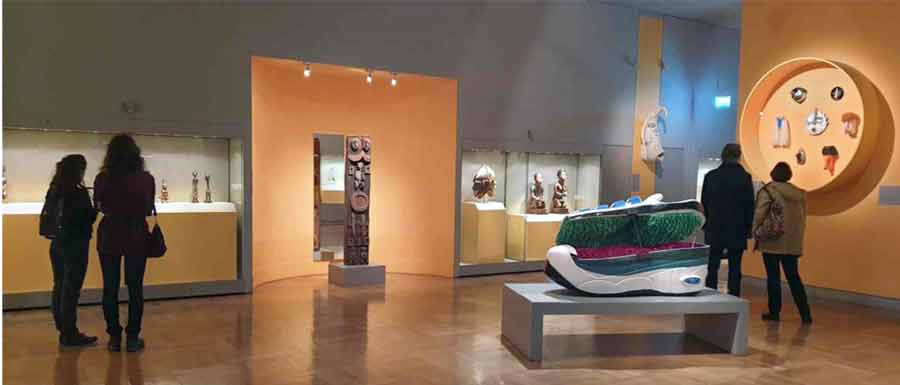
Fig. 2
Status: In comparison with carved mullions on façades of royal residences in the Cameroon grasslands (Fig. 3),[4] other mullions or door frames in the Museum Five Continents (M5K, p. 17, Kecskési 1999 No. 11, 70, 75) or in the Humboldt Forum Berlin, there is a partial similarity of motifs, but a strikingly 'archaic' formal language. Other examples are clearly more 'elaborate'. The multitude suggests that this type of pillar is quite typical of works from this period in this region of West Africa.
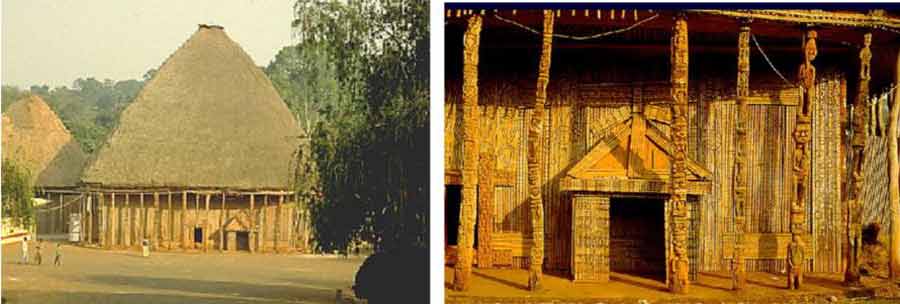
Fig. 3
Interpretation
The current view of the work
For the interpretation, the following questions lend themselves to art lessons: Form, iconography (meaning of the motifs), function, theme (or core idea) of the object, i.e. an interpretation.
With regard to the guiding idea of multi-perspectivity, two positions will be addressed: On the one hand, the view of today on the basis of ascertainable contexts, which seeks to understand the object from its time of origin and its context of origin. On the other hand, the view of the object by the artists of the Blaue Reiter. The comparison of these perspectives seems particularly relevant from an art didactic point of view, even though other perspectives would be conceivable, e.g. from the point of view of museology, provenance research, from the context of current restitution debates, etc. However, these are addressed in the teaching suggestions.
Shape
At first, the pillar develops an immediate physical presence for the visitor: through its sheer size (larger than life, almost square in plan), the materiality of the massive, cracked block of wood (the outline is irregular and probably corresponds to the tree) and the clear, concise, reduced language of form, whose meaning seems inaccessible. The surface treatment is archaic, the wood is more hewn than carved.[5] Thus it appears powerful and at the same time mysterious, which is supported by its presentation in the exhibition on a plinth and without glazing (see Fig. 4).
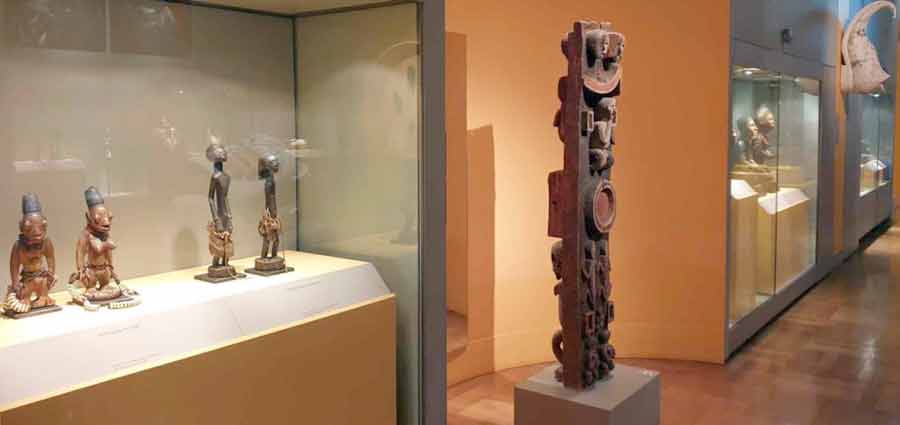
Fig. 4
A closer look reveals how the sculptor interweaves various modes of representation between complete abstraction (circle, rectangle) and representationalism (human figures, animals) in a compositional way[6] , monumentalising the individual motifs through internal symmetry, geometrisation, frontality and statics. This is supported by the painting (see Fig. 5). In this reduction, everything narrative is missing. The representation becomes emblematic, it becomes a symbol.
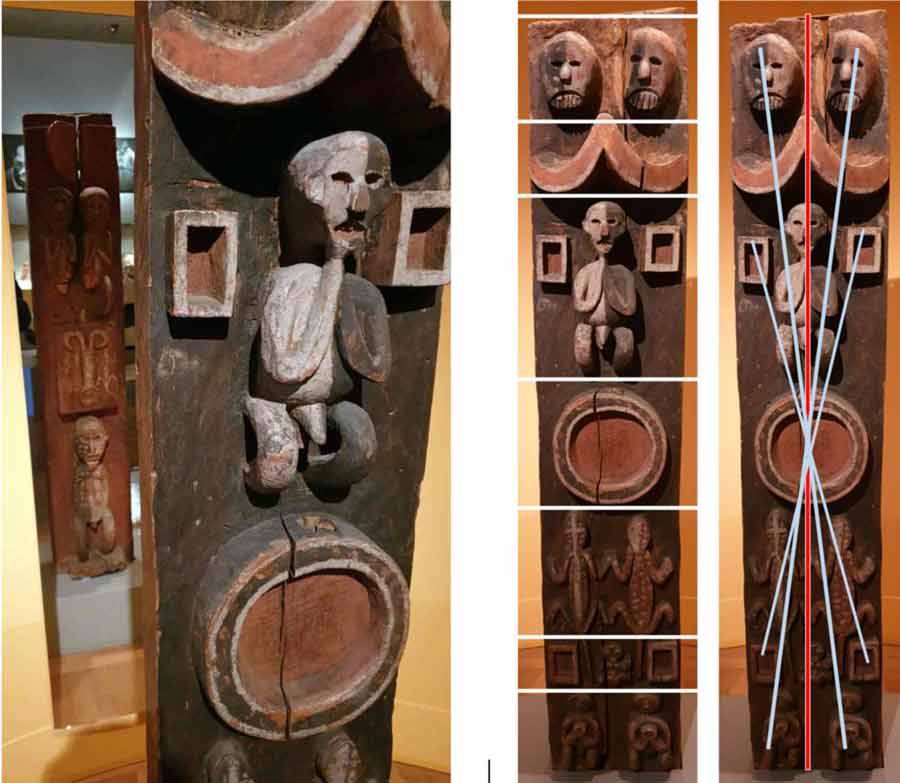
Fig. 5, 6 and 7
This is also supported by the overall composition, which obviously follows a calculated geometric order. It is strictly horizontally divided into individual zones, only once do lizard tails protrude into another zone. However, the separation into individual layers is ingeniously overcome compositionally by the strict axial symmetry in the vertical, but also by the point-symmetrical arrangement around the respective centres. The result is a tension between the contradictory compositional principles (see Figs. 6 and 7) that is decisive for the effect of the pillar.
The lack of any narrative on the one hand and the high creative effort on the other underline once again that it is about a symbolic level. This can perhaps be deciphered, even if its immediate complex order makes it seem above all direct, sensual.
The secure decoding of the iconography (what the individual motifs as well as the arrangement meant in the context of origin) is not possible with today's state of knowledge. Oral culture has left no written sources that could be consulted. Moreover, the oral tradition has been torn down - not least due to colonial destruction. However, since the work obviously has a symbolic language with clear iconography, this level cannot be left out in art lessons. German-language literature and oral experts from West Africa were consulted here. The results contradict each other, but nevertheless yield a court of meaning (see Fig. 8, in which the individual attributions of meaning are named)[7] , which provides a certain direction.
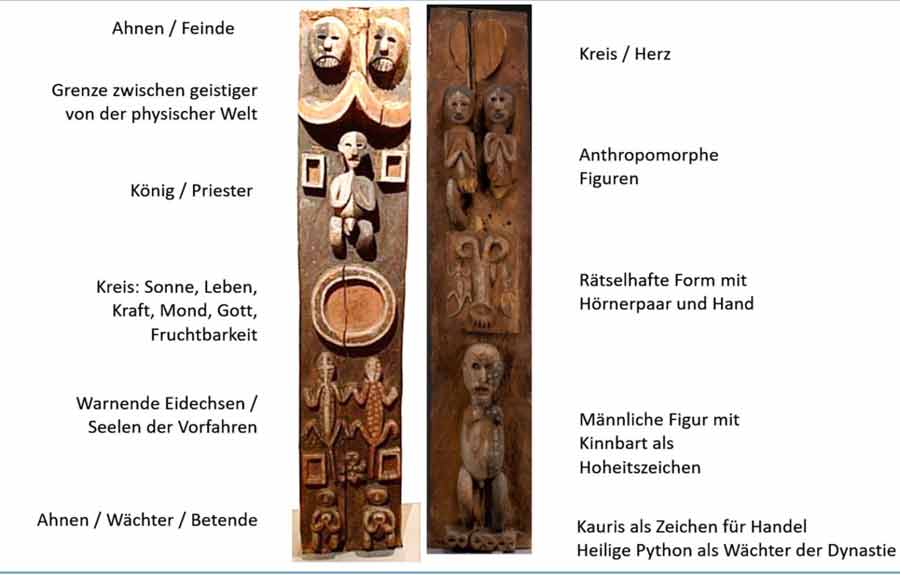
Fig. 8
In addition, the block is painted in three colours. These also carry meanings: Black could symbolise suffering, white could be the colour of the dead and symbolise mystery, red, the colour of blood, symbolises life (PHSAA). The light-dark contrasts themselves symbolise life and death (Kecskési 1999).
Function
PdGY suspects that the pillar - as part of the architecture of the house - stood at the spatial interface with the public (on a path) in order to communicate the significance of the house, presumably a cult house, to the outside. The object could therefore have been part of the façade of a particularly distinguished house[8] , also with a supporting function for the roof. It communicates what happens in the house or who lives or resides there.
Kecskési, on the other hand, considers a free positioning in space (Kecskési 1976, p. 22) and suspects an ancestral tablet. This in turn would fit the following determination by Gouaffo: "The 'Blue Rider Post' is a spiritual object. According to oral traditions, the object was placed in the sacred house like a statue. Caps, chains, bags or skeletons could hang from the object. Secret societies like the 'Losango' used the statue to perform certain rites, for example to cleanse the village of evil spirits." (Albert Gouaffo in GI) KG also suspects the context of a meeting house of such a secret society. Common to all assumptions is that the pillar stood in the context of a house with a sacred or cultic function.
'Theme' of the object: Basically, three different levels can be delimited, some complementary, some contradictory. First, the communication function on the façade or at the entrance to the outside. Then the pictorial formulation of a certain understanding of human being-in-the-world is asserted; man is ultimately embedded cosmologically.[9] At the Humboldtforum Berlin, in turn, such pillars from West Cameroon are also seen as the "architecture of power", power exercised by the rulers or the secret societies through impressing and deterring.[10]
Second perspective
The interpretation provided above can be countered by a second perception of the pillar, as it appears in the almanac "Der Blaue Reiter". This almanac, an artist's book, was published in 1912 by Franz Marc and Wassily Kandinsky. The reception of this book is over a hundred years old, but it is significant for the development of European art, as it is a good example of how artists of this time created a new frame of reference by referring to non-European art. In this respect, the Blaue Reiter clearly differs from Cubism, Expressionism or Dadaism, which were all being developed at the same time.
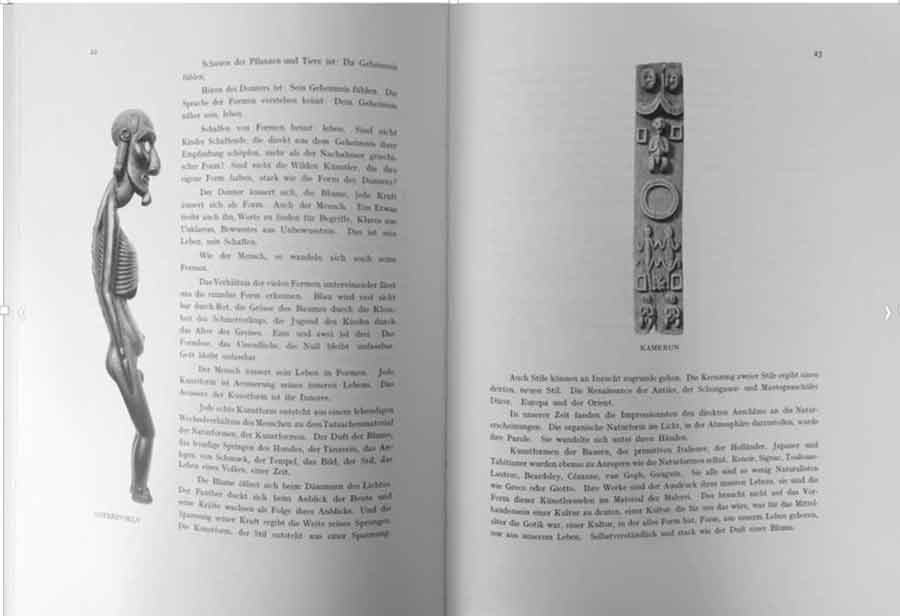
Fig. 9
In the Almanac, on pages 21 to 27, there is an essay by the painter August Macke entitled "Die Masken" (The Masks), in which a relatively small illustration of the pillar in question is embedded (see Fig. 9). Macke's contribution, like all the other texts in the Almanac, was probably written at a joint meeting of Macke, Marc, Münter and Kandinsky in Murnau.[11]
Visits to ethnographic museums are documented above all for Wassily Kandinsky, who was a trained ethnologist, and Franz Marc. Marc had also admired sculptures from Cameroon in particular during his visit to the Berlin Ethnographic Museum in 1911. And it was he who was ultimately responsible for the insertion of the photograph of the post in Macke's article.[12] In his letters to Macke, Marc writes about this. On 14.1.1911 about the objects from Cameroon in the Berlin Ethnological Museum: "I remained amazed and shaken by the carvings of the Cameroonians"; and later that he would furnish Macke's article in the Almanac with "ethnographic wonders" (MW).[13] In the text itself there is a single, very brief reference to "carved and painted pillars in a Negro hut", by which presumably the post was meant.
The text itself represents Macke's conception of art. In it, "intangible ideas", "mysterious forces", an "invisible God" express themselves in the world of appearances and "cultic expressions". The invisible materialises in the visible. This realm of the visible includes not only art, such as that of Giotto or van Gogh, who are classified as 'primitive', but also nature. Children's drawings, the folk art of the 'primitives' and 'savages' or non-European cultural forms are also expressions of the mysteriously invisible. These themselves are - and this is decisive - equal to each other. There is no hierarchy, no distinction between high and low, between high art and popular culture. All forms speak - as Macke characterises it - in "strong language". For Macke, the pillar in the museum is then an example of "the tangible form for an intangible idea, the personification of an abstract concept" (Macke 24). He also calls this the figure of an "idol".
The approach underlying this thinking sounds familiar; we have known it since the Platonic theory of ideas. However, this approach does not justify the selection of this particular post, as other posts from the museum's collection would also have been available.[14] Here one can only assume. I suspect that there are various factors that led to the selection: the archaic power of the forms; the initially wild and carefree-looking, additive combination (or montage) of the various principles of representation in the individual motifs (concrete - abstracted, geometric - organic, symbolising - depicting), which on closer inspection, however, then reveals itself to be consciously composed; or the coarse, physically perceptible materiality of the cracked, thick block of wood in impressive dimensions. PdGY also speaks of "wonderfully composed".
In the work, everything is represented with great sensual power that is the opposite of an "empty" image in European "cultures that have already passed through a thousand-year course, like [...] Italian Renaissance" (Macke 24) and from which Macke renounces: "We must bravely renounce almost everything that has hitherto been dear and indispensable to us as good Central Europeans [...] in order to get out of the fatigue of our European lack of taste". (Macke ibid.)
In art lessons, the question arises to what extent the image that Marc or Macke create of the pillar (as representative of the idea of an idol) goes together with what the object presumably was and is in its original context. Or to put it another way: are they designing a certain, exotic image that does not correspond to the object itself? [15]
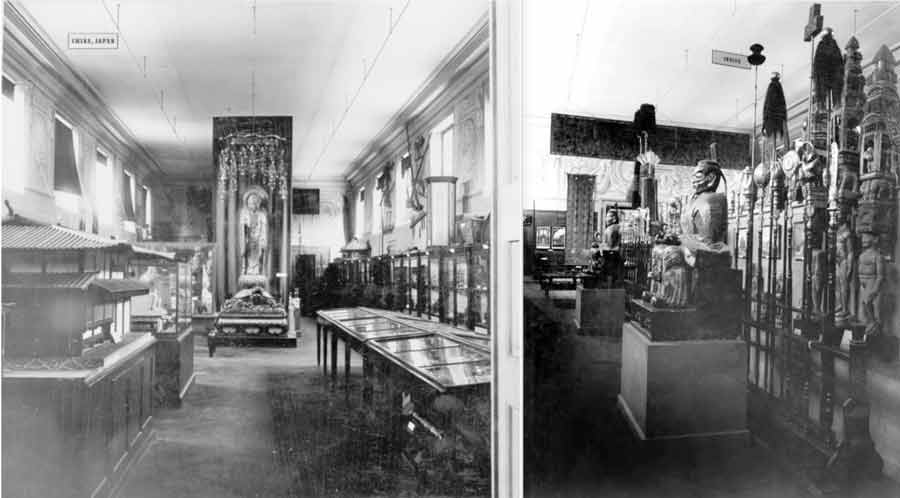
Fig. 10 Historical photos of the exhibition of the India Department in the Munich Museum around 1910 (source M5K)
References
- GI: Juliane Glahn and Marta Krus: CAMERUNS RIGHT TO CULTURAL OBJECTS. https://www.de/prj/zei/de/pos/22656808.html
- Kecskési 1999: Maria Kecskési. Art from Africa - Museum of Ethnology Munich. Munich (Prestel) 1999
- Kecskési 1976: Catalogue for the exhibition African Art. Andreas Lommel (ed.). Munich (Bruckmann) 1976
- M5K: Staatliches Museum für Völkerkunde München (ed.). The Blaue Reiter and the Munich Museum of Ethnology. Munich (Hirmer) 2009
- KG: Karin Guggeis. The Blue Rider Post. (2021): https://www.explore-vc.org/en/objects/expanding-the-canon-of-art-at-the-global-north.html
- PdGY: Patrique deGraft-Yankson. The Veranda Post. (2019) https://www.explore-vc.org/en/objects/the-veranda-post.html and oral interview on 23.4.2022 in Bayreuth, Iwalewahaus.
- PHSAA: Paul-Henri Souvenir Assako Assako. Information by email 20.5.2022
- Wikipedia: Cameroon & Max von Stetten
- MW: Macke Wolfgang (ed.). August Macke - Franz Marc: Briefwechsel, Texte und Perspektiven. 1964. Cologne (DuMont).
- Macke: Macke August. The Masks. In: Almanac "Der Blaue Reiter", 1912, edited by Franz Marc and Wassily Kandinsky, pp. 21-27
Appendix on iconography
- Anthropomorphic figures: ancestral couples / guardians and protectors of the royal residence. These anthropomorphic figures are treated with respect as extraordinary personalities. They are considered ensouled beings, spirits with supernatural powers. (PHSAA) Depiction of all human figures in similar postures: theme of prayer and submission to spirituality. (PdGY)
'Front' side from bottom to top:
- Two people: Ancestral couples / guardians and protectors of the royal residence (PHSAA). People pray for the guidance and protection of the ancestors (PdGY).
- Lizards: The symbol of the lizard warns everyone; it symbolises death. (PHSAA) PdGY sees here two crocodiles (ancestral souls returning to live with humans) instead of lizards.
- Circle: motif of the sun, symbol of life and power; the moon, image of woman and symbol of fertility. (PHSAA) The circle represents completeness, holiness, perfection and other attributes attributed to the supreme being (God). (PdGY)
- Kneeling figure: King or priest (PdGY)
- Line of demarcation between the spiritual and the physical world
- Two heads above: Ancestors (PdGY)
'Back' side from bottom to top:
- Python (geometric frieze at the bottom of the 'back' side): royal totem/sacred python, guardian of the dynasty (PHSAA).
- Male figure with chin beard as emblem of sovereignty (Kecskési 1999)
- Enigmatic form with a pair of horns ending in a hand (?) at the bottom (Kecskési) on a rectangle with two flanking lizards.
- Anthropomorphic figures
- Circular area
Footnotes
[1] The object is variously referred to, mostly in relation to its architectural-functional context: lintel or "te ken dy dye" (in the local Bandjoun language - PHSAA), porch post, house front pillar, post, cult house post (M5K, p. 17), Cameroon post / family crest (Macke at M5K, 13, 24). Post, however, in the sense of sign (post-it) is suggested by PdGY to address the communicative function. Other designations do not address the function, but limit themselves to the given, perhaps to avoid any pre-interpretation: 'sculpted wooden block' (Kecskési 1999 n. 108) or 'large carved square wooden block' (Kecskési 1976, p. 22).
[2] The first German trading posts were established in Cameroon as early as 1868, and in 1891 German military "expeditions" were launched in Cameroon. In 1884, the German Consul General concluded protection treaties with regional rulers and thus proclaimed the protectorate of Cameroon as a German colony. The seizure of the hinterland, which included the grasslands, took place over the course of the following 30 years. (Wikipedia) Even if the provenance is still not clear today, one can certainly share the Humboldt Forum's assessment of such objects that - even if they were not looted through acts of war - they are nevertheless "an expression of unequal power relations and structural, colonial violence". (https://www.smb.museum/nachrichten/detail/ethnologisches-museum-weg-frei-fuer-die-rueckkehr-der-ngonnso-nach-kamerun/)
[3] In the entry book it is noted: "Gr. square block, 1.80 cm high made of heavy wood, carved on both sides with humans and lizards, heavily damaged by termites". (https://onlinedatenbank-museum-fuenf-kontinente.de/) In 1895 Stetten published detailed "Travelogues" in the Deutsches Kolonialblatt.
[4] http://www1.biologie.uni-hamburg.de/b-online/afrika/kamerun/palast.htm; http://www1.biologie.uni-hamburg.de/b-online/afrika/
[5] The block is almost certainly worked with a chisel.
[6] "decorated with geometric, anthropomorphic and zoomorphic forms" (PHSAA)
[7] All performers avoid a complete decoding. They only make suggestions for individual motifs.
[8] It could have been the house of a 'priest' whom one could consult there and through whom or ancestors one could pray to God (PdGY).
[9] "Expression of the cosmogony of the universe of the peoples of the Bamileke plateau; expression of the belief system" (PHSAA).
[10] The assertion of power is also included by PHSAA.
[11] Catalogue: August Macke, Lenbachhaus Munich, 1987, Bruckmann. Munich. S.164
[12] He simply titled the painting "Cameroon", the name of the country of origin (the country whose sculptures he admired).
[13] There are other illustrations in the text: a bird's head from Brazil, a figure from Easter Island (see Fig. 9), one from Mexico, a bird mask from New Caledonia, a cloak from Alaska[13] and a child's drawing entitled "Arabs". Except for the child's drawing, all objects are from the then Royal Ethnographic Collection in Munich (M5K, p.11). They are only titled with the respective country of origin, e.g. Cameroon. Macke was obviously involved in the selection as well as the layout, as his layout sketch shows (M5K 24).
[14] It is not certain what was shown in the presentation at the Royal Ethnographic Collection in Munich at the time, which covered 400 square metres in six rooms in the north wing of the Hofgarten arcades in Munich. The only thing that is certain is that photos of the ten objects depicted, which came from various parts of the world, were lent to the artists for the publication of the Almanac. Photos of the presentation do not exist. "Whether Marc and Macke [actually also] saw the work in the exhibition at that time can be assumed with a high degree of probability, since it is after all very large and thus impressive." (Information Karin Guggeis 26.7.2022)
[15] In this context, it seems of interest that neither Marc nor Macke take up in their own pictorial language the aesthetics of the non-European works they "celebrate" here.
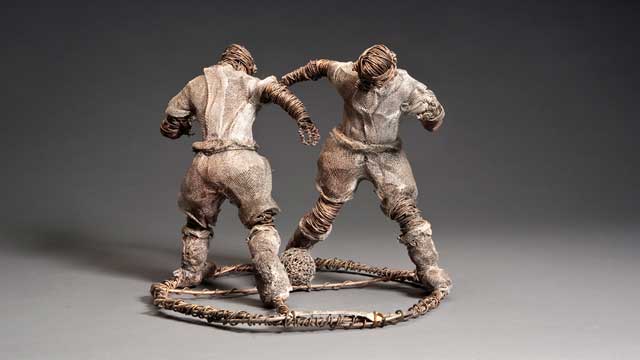
-
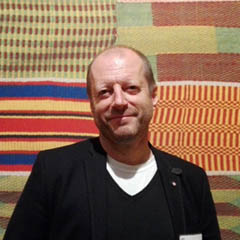 Stefan Eisenhofer
Stefan EisenhoferHis artistic production is informed by the basic concepts of "love", "peace" and "liberty", and he expressly hopes that his works will help to create a better future.
Since 1996, after twenty-five years of working with clay, plaster, stone, cement and wood, Joe Big-Big has mainly used wire, iron nets and barbed wire to produce works with a very characteristic signature. Through the use of metal nets, he produces an effect of lightness and dynamism, even in sculptures several metres high. It was his fondness for big and high sculptures that earned him the nickname Big-Big.
Through his choice of materials he reveals the preoccupations that inform his work: he believes that people are free to decide whether they want to produce or destroy something, to encourage or suppress. In Joe Big-Big's work, wire and barbed wire, commonly symbols of oppression, captivity and division, represent the overcoming of bondage: they stand for prevention and protection. Joe Big-Big plays here with the notion of wire as an everyday material that normally goes unheeded, but which can become an instrument of human creativeness and global understanding through artistic activity. However, in Joe Big-Big's work this metal material seldom loses its ambivalence – for it is also a symbol of human labour and human toil. The artist makes use of these associations in works showing toiling people.
Joe Big-Big is intensely interested in the iconology of his metal materials and the objects he integrates into his works. Padlocks, for instance, symbolize the difficulties we get ourselves into, while keys stand for solving problems, freedom, peace and happiness. Coins represent the money we need to live, and clocks or watches are references to the time we need for solving our problems on the way to a carefree future. The metal materials thus symbolize wealth, strength and power. The artist also deliberately combines old with new metals, as a reminder that one needs to remember the old in order to be able to cope with the present and the future.
The themes taken up by Joe Big-Big come from nearly all areas of human life. His works are concerned with very personal issues as well as with political topics, such as war, poverty, flight, displacement, or the equality of women. He believes that his images speak louder than words, and he intends them to arouse emotions in the viewer, for "art without emotion, feeling or meaning is like a voice or a noise without meaning".
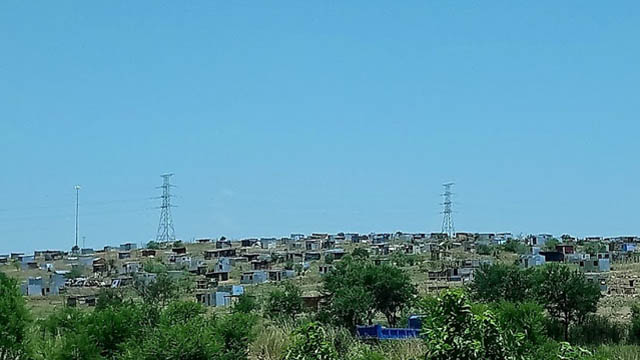
-
 Esther Kibuka-Sebitosi
Esther Kibuka-SebitosiIt is 25 years since South Africa achieved a democratically elected government in 1994. Nelson Mandela, who was imprisoned for 27 years, became the first black president after years of apartheid system governing the Republic. What is apartheid and what were some of the effects on housing? The Sustainable Development Goal 11 aims to make cities safe and sustainable; ensuring access to safe and affordable housing and building slum settlements into decent houses. It also calls for investment in roads, transport, creating green spaces and improving urban planning. This would envisage participatory planning and inclusive development. The image demonstrates the complexities of participatory planning and urban development in previously divided societies.
Historical perspectives
South African history can be divided into distinct phases: pre-colonial era, colonial era, post-colonial era, apartheid era and the post-apartheid era. During these periods, many different historic events characterised by violent clashes between the indigenous people and european settlers forcefully displacing them from their land occurred. The cultural differences were used to oppress and marginalise the people while racial tensions underlying the political oppressions were extensive. The shack is an object that symbolyses not only the oppression in living conditions, but also inequalities in economics and infrastructure.
Apartheid systems created shacks
Between 1948 and 1991, the system of administration in South Africa was apartheid. It was a National party system of racial discrimination and human rights violation. Fundamental to it was the Homeland Citizens Act of 1970, which augmented the Native Land Act of 1931 through the establishment of the so-called Homelands or reservations. The Act authorised the forceful removal of black people from urban centres to “Bantustans”. Surprisingly the apartheid perpetrators and sympathizers quoted a similar act in India where the British had done similar things without backlash from international community.
The typical Township in South Africa refers to underdeveloped segregated areas established from the 19th century until the end of the apartheid era to cater for non-whites namely Indians, “Africans” (meaning black) and people of colour. The Townships were located on the periphery of towns and cities. The Diepsloot Township in the image above therefore fits its purpose to serve the affluent towns because of its location along the highway.
The images show the shacks in Diepsloot Township. Close to 1.4 million people live in Diepsloot Township. Characteristically, such areas abound with crime, violent protests due to lack of basic services and overcrowding. The township is also full of diversity of culture, tribes, tradition and many nationalities, due to rural to urban migration. The major problems include unemployment, poverty and lack of basic services which result from lack of education and skills. Coupled with deprivation of water, sanitation and basic infrastructure, shack living environments are unsustainable and challenging sustainable cities.
In South Africa, the term “township” and “location” refers to segregated urban areas that arose from the late 19th century that were reserved for non-whites (Indians, blacks and people of colour). Built on the periphery of towns and cities, townships integrated the roots and systems of apartheid so deeply that they are almost difficult to eradicate. Despite strides made over the past twenty five years to provide decent housing for the majority of the population, Townships and shacks in particular still exist. As part of the mining industry, the black population comprising men lived in hostels and servants' accommodations. With increasing urbanization, the rapid urban expansion could not keep up with the influx of people which led to overcrowding. In the 1950s, townships in the Witwatersrand areas grew exponentially as the gold rush expanded. The shack township settlements were of poor quality but provided advantage over the hostels in more established areas as they were cheaper and not regulated by the apartheid government. With increasing eviction of black people from “white” areas, the forced removals resulted into a broad movement into segregated townships creating the designated race groups - black, coloured and Indians per the Population Registration Act of 1950 and the Group Areas Act.
With the fall of apartheid in 1994, the townships still persisted because it was a systemic problem that can only be solved in a multi-sectoral way. Typically, most towns in South Africa have a township associated with them. The New Democracy has created modern developments in townships since 1994 for example building wealthy homes and middle class income homes. In Soweto for instance there are many new developments. Hence "township" is changing its meaning and ways as it no longer means the original apartheid low income location but a home for the growing middle class. This has resulted in properties and real estate development in the townships. Although many houses were built inofficially, the government has improved the access to water, electricity and roads that impact on the quality of life. The biggest challenge is to make the progress sustainable. With plans to build the sewage system, water and electricity, townships are increasingly attract young people. As they belong to the generation of millennials, who want to stay connected globally, it is not surprising that the shacks in townships have connected to digital devices and satellite television, after all, the people have to live their life. A study in Diepsloot showed that 24% of the residents lived in brick structures, 43% in shacks and 27% in backyard shacks (additional units build on a plot of land by the landlord to get extra income (Harber, 2011).
Summary
The shacks are small constructions built on the periphery of towns and cities to provide cheap accommodation to the growing number of people working in towns or cities. The discovery of diamonds and gold in the 19th century in South Africa had a profound impact on the wealth of the region, propelling it into world stage competition for industrialisation. This was a fundamental shift from an agrarian-based economy with effects on the people and society. Not only were conflicts between the “Boer” farmers and the British Empire created, but also conflicts among the black natives as the groups fought for control over resources of the mining industry. These fights continued to define the mining industry for years and years. One sphere impacted was the human settlements. Between 1948 to 1994, the country was dominated by Afrikaner nationalism led by systems of racial segregation and a white minority rule called the apartheid, an Afrikaans word meaning “separateness”. The blacks, Indians and people of colour were forcibly removed from their land into Homelands or townships. With increasing demand for housing, shacks provided a cheaper option close to towns and cities. With no basic services, the areas continue to challenge governments as they are in need of building sustainable cities and sustainable solutions.
Shacks remind us of the lived experiences of people wanting to create sustainable livelihood in the economy. Given the opportunity of a job in a town or city, the viable option would be to live in a shack that is cheaper than brick construction. The downside is the lack of basic infrastructure and basic services for the population who want to participate in the economy. The dual economy in South Africa comprises the affluent businesses listed on the Johannesburg stock exchange and the basic township economy. People who want to participate have to choose between living in a shack or to be excluded from economy. The contradictions of the creation of jobs without viable sustainable housing options leads to the perpetuation to the segregation. An extension of two cities - two economies. Shacks on one side of the highways and the affluent middle class on the other side. The images show the contradictions and frustrations of moving towards sustainable cities in a country divided by inequalities.
This phenomenon is not only a South African one, but known worldwide: In Brazil and Mexico there are also areas divided by inequalities of social, economical and recently technological divide.
References:
- Harber, A. (2011) Diepsloot, Jeppestown: Jonathan Ball Publishers LTD, 2011. 2011. 1-226. Print.
- Tinashe, P. (2014). We have a story to tell — Diepsloot youth: A quest for safe space and opportunities to earn a living. (PDF).
- Rosa Luxemburg Stating. p. 2. Retrieved 9 November 2018.
- Foster, D. (2012): After Mandela: The Struggle for Freedom in Post-Apartheid South Africa
- https://unequalscenes.com/alexandra-sandton Retrieved 22 Jan 2019
- https://www.google.com/search?rlz=1C1EODB_enZA550ZA550&tbm=isch&q=shacks+in+Townships+near+Lanseria+Airport&chips=q:shacks+in+townships+near+lanseria+airport,online_chips:apartheid,online_chips:gauteng,online_chips:apartheid+museum&usg=AI4_-kTUvSb-CcNIqEavZu8utwO5g7HbUg&sa=X&ved=0ahUKEwislenZooLgAhXUQxUIHeIRDOYQ4lYILSgC&biw=1025&bih=587&dpr=1, Retrieved 25 January, 2019.
published April 2020
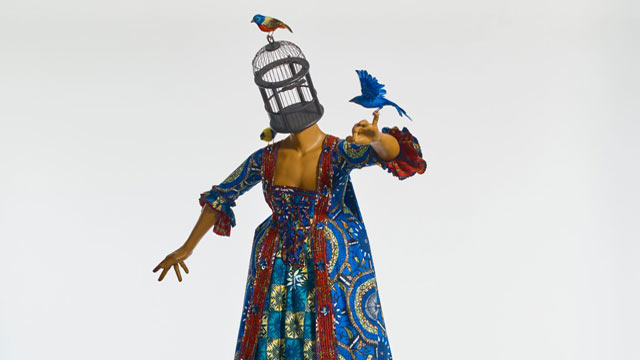
-
 Bernadette Van Haute
Bernadette Van HauteMrs Pinckney and the Emancipated Birds of South Carolina (2017) is a sculpture in the round composed of a headless, female, ‘white’ mannequin swathed in historical dress and balancing on a globe. In place of her head is an empty birdcage from which three birds have escaped. The work was created by the internationally renowned artist Yinka Shonibare (born 1962) who is a black man of Nigerian descent living in the United Kingdom. He can thus be identified as a member of the African diaspora. In his artworks he usually engages with concepts that are related to the politics of colonialism and the slave trade and explores cultural identity in the context of globalisation. [1] While his creations are deeply critical of western imperialism, he always makes sure to render them visually alluring and engaging to elicit a visceral response. [2]
This particular artwork was co-commissioned by the Yale Center for British Art and Historic Royal Palaces, Kensington Palace, and created especially for the exhibition "Enlightened Princesses: Caroline, Augusta, Charlotte, and the Shaping of the Modern World".[3] This adds an aura of seriousness of intellectual and aesthetic intent to the sculpture. In the title of the work, the artist has identified the woman as Mrs Pinckney, or Elizabeth (Eliza) Lucas Pinckney, who at the age of 16 was put in charge of her father’s plantations in South Carolina. [4] She had a major influence on the colonial economy by developing indigo as an important cash crop to be processed as dye. [5] The sculpture is said to be the artist’s response to Eliza’s encounter with the German Princess Augusta in 1753 which further identifies her as a member of the social elite. [6] All of the above components help to retrieve the identity of the subject, the ideology being addressed as well as the message in the image.
The artist has encoded his artwork with visual tropes that clarify and enforce his message. While the style of Eliza’s dress is based on 18th-century fashion, the fabric used is Dutch wax cloth which Amah Edo describes as a “marker of Africanness”. [7] Manufactured in Europe but using the Javanese batik printing technique, the cloth “came to be produced specifically for West African markets in the 1890s … [and] its aesthetic was adapted by manufacturers to suit these new consumers’ tastes”. [8] Now widely perceived as symbolic of tradition, the Dutch wax cloth is regarded “as a high-end commodity desirable to elite customers”.[9] The material of the woman’s dress thus not only identifies her as a member of the elite but also refers to Africa as the source of her wealth: it is through the labour of the African slaves that Eliza was able to run her family’s plantations in America. Likewise, the blue of the material – and the bird on her finger – is a direct reference to her successful cultivation and processing of indigo. It can thus be seen that the artist explores concepts of race and class through a careful choice of materials and colours in his imagery. By dressing the white woman in African cloth, he complicates history and racial identity in an effort to startle the viewer’s conscience.
As the plantation’s manager, Eliza occupied a position of power which is visually manifested by her being placed literally on top of the world. The latter is represented by an eighteenth-century globe that shows the colonial territories of the British empire. [10] Eliza is thus turned into a symbol of white superiority and privilege granted by the politics of imperialism. Her balancing act, however, proves to be precarious and elicits tension as the ball can roll at any moment and topple her from her position of power. It is also interesting to note that the globe is an attribute of Fortune, the fickle goddess of antiquity. Fortune is blind and even eyeless, and the globe “on which she stands or sits, originally indicated instability, but to the Renaissance it was rather the world over which her sway extended”. [11] The headless Mrs Pinckney thus shows a cunning resemblance with the antique goddess Fortune “who bestows her favours at random”. [12]
The favours bestowed by Eliza relate to her release of the birds from the birdcage. However, instead of flying away to freedom, they come back to her. She playfully lifts her left arm for an indigo-blue bird to perch on her little finger, while another bright-coloured bird sits on her left shoulder and a third one on top of the cage. According to Shonibare, the birds are a metaphor for slaves and her gesture of setting them free symbolises her wish to emancipate the slaves – hence the title Mrs Pinckney and the Emancipated Birds of South Carolina. [13] The narrative thus presents a paradox between the white woman’s privileged yet unstable position as powerful, wealthy mistress and her fickle wish to liberate the black slaves whose destiny is entirely in her hands.
In this work, Shonibare has given his own interpretation of the story of Mrs Pinckney, choosing to focus on the effects of the slave trade and colonisation in the eighteenth century in the United States, then still British territory. While the playfulness of his rendition and its aesthetic appeal conceal the harsh realities of enslavement, the dehumanisation of black people as a result of colonial politics still filters through in the form of brightly coloured birds which, although set free, are so tamed – read oppressed and subjugated - that they are not able to fly.
[1] https://en.wikipedia.org/wiki/Yinka_Shonibare (26 July 2021).
[2] Yale News, 2017. Yinka Shonibare MBE (RA): ‘Mrs. Pinckney and the Emancipated Birds of South Carolina’. Video. Yale News, Yale British Art, 25 July 2017. https://news.yale.edu/videos/yinka-shonibare-mbe-ra-mrs-pinckney-and-emancipated-birds-south-carolina (26 July 2021)
[3] Yale News 2017.
[4] Yale News 2017.
[5] https://en.wikipedia.org/wiki/Eliza_Lucas (26 July 2021).
[6] Yale News 2017.
[7] Edo, Amah M. (2019). From African print to global luxury: Dutch wax cloth rebranding and the politics of high-value. In Mehita Iqani and Simidele Dosekun (Hrsg.). African luxury: Aesthetics and politics (pp. 77-92). Bristol, UK / Chicago, USA: Intellect, p. 82.
[8] Edo 2019, p. 80.
[9] Edo 2019, p. 85.
[10] Yale News 2017.
[11] Hall, James. 1974. Dictionary of subjects and symbols in art. London: John Murray, p. 127.
[12] Hall, James. 1974. Dictionary of subjects and symbols in art. London: John Murray, p. 127.
[13] Yale News 2017.
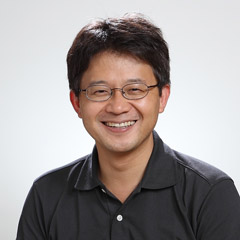 Nobumasa Kiyonaga
Nobumasa KiyonagaThe oeuvre of Yinka Shonibare CBE is often characterised by a colourful and at the same time amusing appearance. This facilitates the viewer's immediate access. This is also the case with his 2017 work Mrs Pinckney and the Emancipated Birds of South Carolina. What one perceives here at first glance is the figure of a lady wearing historical European clothing, a "Robe à la Française" from the 18th century. However, the clothing is unusually colourful. Moreover, the woman is standing on a sphere, albeit shakily and leaning forward somewhat. This image quickly connects with the traditional European iconography of "Fortuna", i.e. the admonishing, allegorical symbol of "fate". It turns out that the sphere is the globe.
The graceful lady also has a strange head in the form of a birdcage. But its door is open and the three birds have long since escaped. This could be an allusion to Maurice Maeterlinck's The Blue Bird, the central message of which is the obvious true happiness. In any case, the caged head shows us that it is actually our thoughts that tie us down and hinder our actions, as is often the case. Seen in this light, at least this lady has succeeded in unmasking the internalised gender ideology and liberating herself mentally. But is it really a lasting liberation?
Who actually is this lady, this "Mrs Pinckney"? What fate is at stake? She is not known here in Japan, for example. A look at Wikipedia, for example, will help: she is considered one of the first emancipated women in the USA, who achieved prosperity with her pioneering attempt to grow indigo on slave plantations in South Carolina. This dye was in particular demand for military uniforms in Great Britain at the time.[1] That is why the lady is wearing this indigo dress. But where does the artist's reference to Mrs. Pinckney come from? A direct connection is hard to find at first. However, knowing that Shonibare describes himself as a "post-colonial hybrid"[2] - he was born in London as the child of Nigerian parents, grew up in Nigeria and studied in London - and that he very often uses "African wax prints" for his works,[3] one gains more clues about the work.
At present, those wax prints seem to represent "authentic" African life, but they have an Indonesian origin and were made by Europeans, especially Dutch, and sold and distributed in West Africa.[4] In this sense, they are in fact a transcultural product. Through their use, the artist points to the "cultural imagination as a power structure and means of domination"[5] in the spirit of the critique of representation. In this specific work, too, the wax prints, which have something in common with the fate of indigo, find their use in clothing.
Thus, it turns out that the lady functions as the encouraging and, at the same time, admonishing symbol of the emancipation of women, which never proceeds in a linear fashion and is still threatened and endangered everywhere today. Moreover, this emancipation movement must always be seen in an even more complex context, which was and still is connected with the fate of countless people - in Mrs. Pinckney's case, for example, that of the slaves, according to the message of the work.
[1] https://de.wikipedia.org/wiki/Eliza_Lucas_Pinckney (27 July 2021)
[2] Shoji, Sachiko. 2019. “History is Happening Now: What Connects Us All to the Art of Yinka Shonibare CBE.” In Exhibition catalogue Yinka Shonibare CBE: Flower Power. Fukuoka: Fukuoka Art Museum, p. 105. Incidentally, this is the artist's first solo exhibition in Japan.
[3] Shonibare CBE, Yinka. 2019. “Artist Statement. Woman Shooting Cherry Blossoms.” In Exhibition catalogue Yinka Shonibare CBE: Flower Power, Fukuoka: Fukuoka Art Museum, p. 13.
[4] Ibid. According to Shoji, Japan also became involved in the production of those wax prints and their export to Africa from the late 1920s to the mid-1990s. See Shoji 2019, 106-107.
[5] Shonibare 2019.
 Ernst Wagner
Ernst WagnerA life-size, headless, female mannequin balances on a globe showing the African continent from the front. Her Biedermeier-style clothing in bright colours shows a deep décolleté. The fabric pattern is Dutch Wax, which can be inferred from the given information on the work. In combination with the birdcage and the three colourful birds outside the cage, the sculpture is reminiscent of surrealist montages like in René Magritte's artworks.
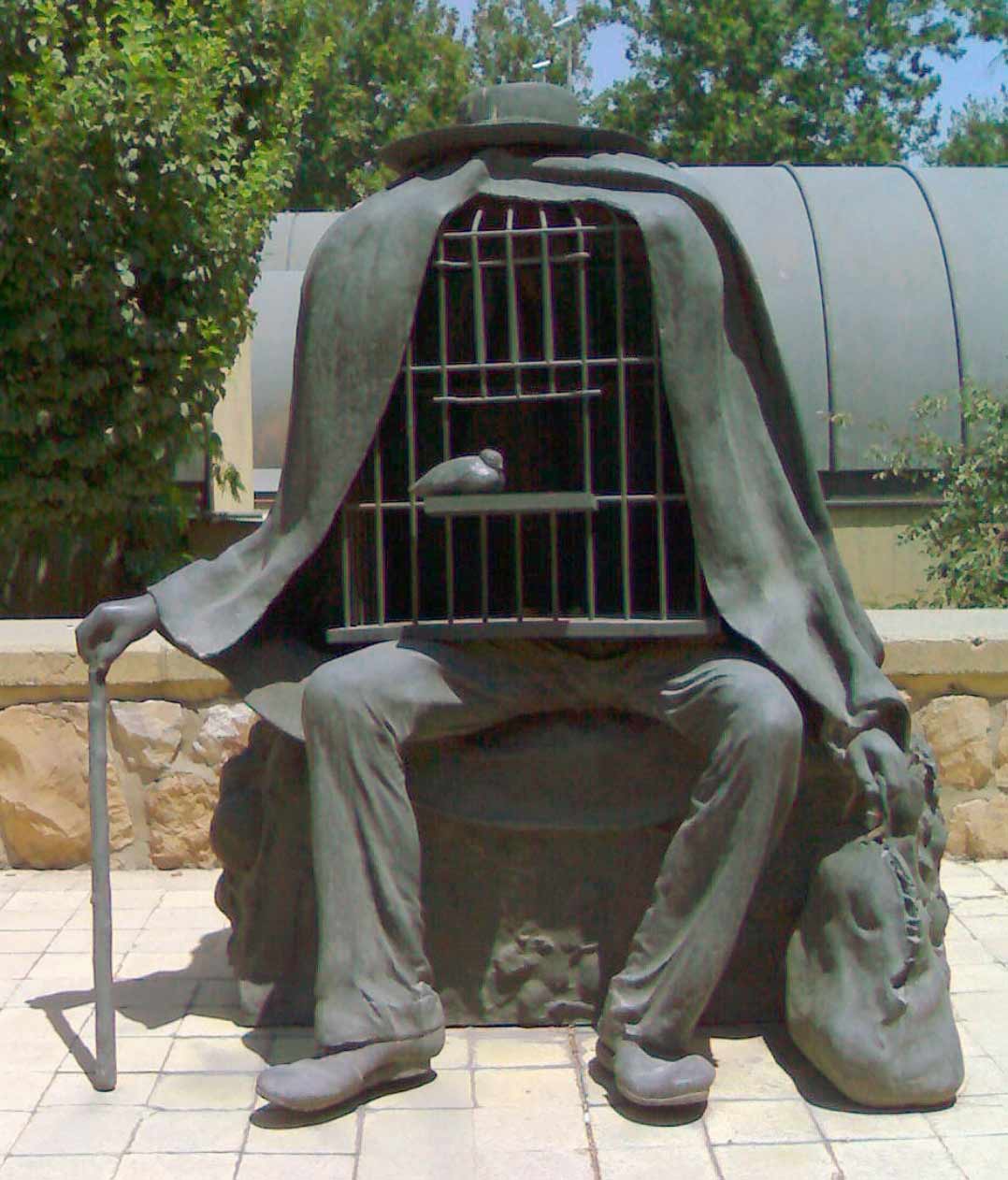 René Magritte, Le Thérapeute (1976), Tehran (Copyright: WikiCommons)
René Magritte, Le Thérapeute (1976), Tehran (Copyright: WikiCommons)The title refers to a concrete iconography that makes research necessary which - as a reward - helps to decipher the birds and the blue dress: Mrs Pinckney refers to a prominent historical woman (Eliza Pinckney, 1722 - 93) whose biography - as one can read on Wikipedia - was deeply entangled with English colonialism and the American War of Independence. Shuttling between North America and England, she was remarkably innovative and entrepreneurial. The birds in the sculpture allude to a specific anecdote when Eliza Pinckney gave such birds as a gift to the mother of the British King George III. The blue of the dress can be seen as an allusion to Pinckney's production of indigo in South Carolina.
The globe and the pattern of the dress - like the title - also allude to the theme of colonialism. Even the material specification of "Dutch Wax" tells a tangled story in colonialism. But the female role model embodied by Eliza Pinckney in her time, obviously denies the usual connotations associated with colonialism, slavery and looting. The birds outside the cage perhaps also make references to the immanent contradiction between freedom and captivity.
Alluding seems to be the most adequate term to grasp the specificity of the visual language of this work. Nothing is clearly asserted, no thesis is put fprward. Rather, a dazzling, assembled, ambiguous figurine stands in the context of 18th-century colonialism, hinting at many themes that are significant also today: women's roles, capitalism, domination and exploitation of nature, colonialism, freedom and oppression. This fits in well with the immediate perception of the object. Looking at the artwork, one gets the impression of a strange balance of lability and stability, of theatricality and ridiculousness, of immediate sensuality and learned knowledge.
Now, the question remains as to how this work is located in the transcultural contact zones. Today, it is exhibited in a US collection of British art, the "Yale Center for British Art". The artist himself is called a British-Nigerian artist. He himself uses his English title of nobility CBE (Commander of the British Empire) in his name. Since documenta 13, he is well known in the context of Global Art. In terms of iconography, the work is also located at these interfaces. Through montage, it merges different associations into an inherently contradictory complexity that cannot be resolved. This creates a fundamental openness that is reflectes when we ask about its meaning: can we read the work as ironic alienation? Or as a commentary on history? Or as homage or, on the contrary, as criticism of the historical Mrs Pinckney? As a reflection of current and very serious issues or as a harmlessly playful object?
A video produced by the museum where the work is now located shows an analogous reception history (Link 1 / Link 2). How does the work constitute the “ideal” viewer? He or she is a decoding, deciphering viewer who allows the iconographic fixation to fail with relish because of the sensuality of the playful object, just as the narrative of Mrs Pinckney fails because of the mannequin's instability. The ideal, contemporary viewer simultaneously enjoys the openness and yet sees him-/herself confirmed in his/her anti-colonial habitus.
 Discussion
DiscussionDiscussion
EW: When I compared all three contributions, I was initially surprised by the large number of common intersections. This certainly points to the global power of interpretation of media representations in English (website of the collection at Yale, Wikipedia), which we could not escape either. We all researched Mrs. Pinckney on Wikipedia, we all trusted the video on the website as a source. But what is interesting now is how differently we deal with it and what different conclusions we come to. I have the impression that in your approach, Bernadette, the story of Mrs. Pinckney plays the biggest role, while in my text this story is rather only a possible reference point. I don't know if you can agree with me.
NK: Yes, I also see these differences. With Ernst, I see more of a fundamental, principled attitude in the analysis of the work. In Bernadette's interpretation, I found the interpretation of the birds as "slaves" interesting. I myself saw in it the - temporarily - liberated soul of an emancipated woman. Moreover, in this context, I also find your reference to the paradox of the actually already liberated "slaves" particularly illuminating, as it seems to have been derived from your discussion of colonial history in Africa.
BVH: When comparing our contributions, I was also reminded of the fact that art is always about other art, hence we looked for precedents that may have inspired the artist. But what I find most exciting about our interpretations are the differences in emphasis on the various meanings that are embedded in the work. For Ernst, the transcultural nature of the work stands out, as well as its openness in meaning. For Nobu, it is the reference to gender ideology and women’s emancipation that forms the core of the work, especially in light of ongoing gender discrimination. For me, it is the historical narrative that led me to interrogate the issue of racial discrimination which also continues today in movements such as #BlackLivesMatter.
EW: I share this, and I would like to follow up with a question. Is it possible that our respective contexts in which we work have influenced this? Not in terms of content – we agree on that – but in terms of patterns of argumentation. If you, Bernadette, place so much emphasis on the story of Mrs. Pinckney, does this perhaps reflect the great oral, meaningful storytelling traditions in Africa? And when you, Nobumasa, on the other hand, elaborate Mrs. Pinckney as an encouraging and at the same time cautionary symbol, does this perhaps reflect the great ethical traditions in Asia? My refusal of direct meaning-making and ethical service, on the other hand, would then be a European-style reflexive evasive manoeuvre to a (preferably unassailable) meta-level?
BVH: Good question indeed. In my opinion, this exercise shows how we are all conditioned by the sociocultural environment in which we live and work. Hence my response, from a South African point of view, focused on the story/history in order to highlight the importance of the work in decolonising the subject. While playfully complicating racial issues in a historical context, the artist mainly celebrates Africanness by means of materials, patterns and colours. This allowed me to infuse my interpretation with African epistemologies. Your response, Ernst, could be regarded as a refusal, perhaps, to acknowledge and engage with the deeper implications of the work and indeed rather shift the focus onto more theoretical concerns as inspired by German art historians? I am keen to hear Nobumasa’s view on this matter.
NK: Ernst's question about whether a Japanese ethical tradition might secretly be reflected in my interpretation is very difficult for me to answer. But as Bernadette has just pointed out, the social context in which we work definitely plays a certain role. While globalisation has erased spatial distances, perhaps not necessarily mental ones. For Japanese today, Africa is still very distant, in the double sense mentioned above. Although Africa is the second largest continent with 55 countries and countless information is available, detailed and nuanced ideas about it are often missing from our consciousness. My leap into the general, or ethical, implication of the work could possibly be explained in this way. Seen in this way, I have probably unconsciously "traced" my own situation. But this also underlines the fact that the critique of representation – in the sense of a critical questioning of pictorial representations – is still as relevant today as it ever was.
EW: I was very grateful to you, Nobumasa, for the emphasis on the ethical, because we always have to include the ethical dimension in the context of education. My argument from a German point of view would be that the interpretation of a work like Mrs. Pinckney must not be arbitrary. That would be the ethical responsibility of the interpreters. We will have to come back to this in a moment when we discuss conclusions for a toolbox for decoding images.
But first I would like to learn more about the differences between our approaches – even though there is a large area of consensus. In the theoretical discussions we had some time ago, we clearly distinguished the Japanese concept of 'kansho kyoiku', the South African concept of 'art criticism' and the European concept of 'work immanence'. Could you elaborate on the question of how these positions are reflected in your texts?
NK: The introduction of dialogue-based art viewing from the USA in the late 1990s revived the field of art education in schools or museums in Japan. Since then, this didactic method, which seems to seek to maximise the viewer's part in interpretation through its strict rejection of knowledge transfer and ultimately prioritises the discussion of interpretation, is still in vogue today. But a crucial question still arises as to how the meaning of interpretation, or meaningful interpretation, is secured without degenerating into mere arbitrariness. In this respect, too, our experiment seems to be very inspiring.
BVH: At the University of South Africa we believe that the basic skills required to interpret objects of visual culture are best taught by beginning to practise art criticism. The proper domain of a critic is the description, interpretation and evaluation of concrete works of art. As a first step in this process, students must learn how to describe and interpret artworks. Essentially art criticism is a practice embedded in western epistemology that has been appropriated to study the art of contemporary Africa in a global context. When investigating the historical arts of Africa, the method remains the same although the local context of traditional culture and customs must be taken in consideration. My interpretation of Shonibare’s work was guided by these very same principles.
EW: Finally, I would like to ask you something with regard to the 'methodological kit' proposed by the editors of this volume: Which methodological approaches for the interpretation of images do you consider absolutely necessary – independent of our respective Japanese, South African or European context? And I'll add a second question in a moment: Does that leave one area that plays a role exclusively in your respective local context?
BVH: From an art historical point of view, the methods best suited for the interpretation of political images stem from a contextual approach which demands critical consideration of the cultural context of the work, its artist and of the social practices and power relations in which it is embedded. As the interpreter, you can apply the iconological method: first describe what you see – formal elements and details – and then identify the iconography, the specific subject and symbolism of the work. Do some research on facts and historical context, as well as the reasons why the work was made or commissioned. Then you can explain how all this information was put together to express the meaning or content of the work and decide what message or ideas the artist was trying to communicate. Because every interpreter comes to the artwork with his/her own worldview, the interpretation will differ depending on that worldview and not on the local context. For example, because I attach more importance to the idea of decolonisation, my contextual approach is combined with and influenced by decolonial theory.
NK: Basically, Bernadette, I gladly agree with you, especially with regard to your gradual approach. I also think it is reasonable and sensible from a pedagogical point of view. But this raises the question of what actually constitutes a "political image" or "when" an image becomes political. Of course, there are pictures or works of art that are obviously and unmistakably recognisable as such, but there are also those that are much more subtle, that are not so noticeable to foreign eyes, or that were not originally created with political intentions, but that in retrospect seem to be quite political. What one considers to be political depends, after all, very much on the view of the observer, possibly even completely apart from the original intention of the creator. In this respect, it seems to me that a fundamental attitude is indispensable for the viewer to be able to keep a mental distance from a picture and its context as well as from himself and his own horizon in order to perceive a picture (also) politically.
EW: Thank you both, because from my point of view I cannot and do not need to add anything more. I completely agree that an iconological basis, as Bernadette has formulated it, is needed. And I am deeply convinced that the reception-historical and reception-theoretical extension that Nobumasa has added is absolutely necessary, indeed indispensable, for the toolbox. I can add nothing to this bundle of methods.
What perhaps came up short in our conversation were the different cultural conditions and the resulting consequences for interpretation. But we'll make up for that on another occasion.
NK: Finally, let me add something to my previous statement. For responsible interpretation, we need above all a willingness to engage in dialogue. I experienced this again in our conversation and our experiment also shows this in an exemplary way.
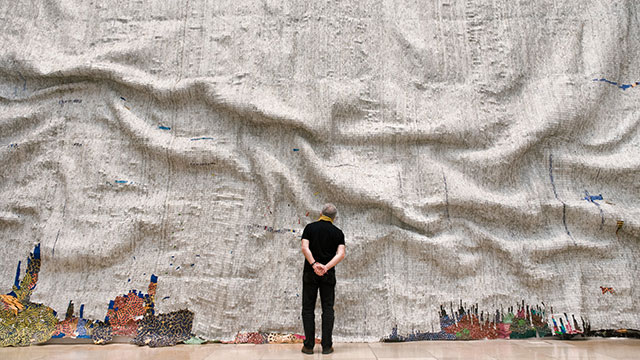
-
 Patrique deGraft-Yankson
Patrique deGraft-YanksonThe Rising Sea by El Anatsui is a naturalistic presentation of an ocean in turbulence, which elicit attention through both grotesquery and finesse. The work, which covers an area of about 14,38 by 6,90 meters, is made up of several pieces of flattened aluminum bottle tops stitched together with copper wires into a massive sheet of grey wall overlay.
To achieve the intended illusion, the artist manipulated portions of the metal fabric into large series of ridges of different sizes that combine into an irregular rhythm randomly positioned across the surface of the sheet to simulate sea waves. Beyond supporting the movements of the sea waves, the rhythm created by the raised portions of the work also provides narrow range of values that effectively bring out the three-dimensionality of the work and transforms the otherwise flat sheet into an illusionistic volume.
Like the texture of oil paints in Van Gogh’s Starry Night, the texture of the stitched pieces of metals sheets introduce energy into the work, bringing out the fluidity of the sea and the potency of the mesmeric sea waves. Indeed, improper disposal of those materials used (and many others) is causing a lot of nuisance in his home country and other parts around the globe, with the sea being the most affected. Therefore, right from the materials used to its marvelous finishing, it is not difficult to discern a blend of severe censuring and admonition in the voice of the artist. The sea is, in the way presented, depicted as rising against improper treatment; and El, by the pains taken to stitch every piece of material together, seems to emphasize the need to make it our business to salvage the sea from improper handling.
The sea, which has served as an important source of livelihood for Ghanaians over the centuries invokes multidimensional viewpoints and draws out divergent responses and reactions depending on its relationship with the people. Among the coastal dwellers (and indeed a very great population of Ghanaians), the sea is considered an important resource for commercial activities, an arena for entertainment and recreation and grounds for spiritual exploits and worship.
He himself being born in the coastal town of Anyako in the Volta Region of Ghana, El seems to know so much about the sea. Growing up, he most likely experienced the sea being perceived, treated and utilized in many different ways. Besides its major use for commercial activities and other useful ventures, he might have listened to many stories about the sea as a god (with other inhabitants), as a provider and as a friend. He might have learnt about how the sea and her inhabitants contribute to the fortunes of the people. He might have witnessed how people got healed as they bathed in the sea, or had their fortunes turned around as they threw some coins in the ocean and made their requests known to the sea.
Beyond this, he might have also been warned about the consequences of flouting the taboos and other prohibitions that regulate the “use” of the sea, including forbiddance from desecrating the sea with unhealthy practices such as defecating in the sea, throwing filth into the sea or wearing sandals or shoes in the sea and the need to observe the tabooed fishing days, and so on. Besides, another important thing which Ghanaian coastal dwellers take very seriously is the need to adhere to physical signs and conditions of the sea, which have various local interpretations and implications. For instance, there are periods when the sea is considered as “full”, during which times the sea waves “rise” and become more intense and turbulent. Fisher folks are supposed to take a rest from “climbing the sea” (as they say in the local parlance) as the sea is likely to be unfriendly, and therefore unconducive for fishing.
Factors that cause the “rising” of the sea may not be ordinarily known. However, according to coastal dwellers, there is always something sinister about a rising sea – either somebody got drowned, or someone or a group of persons might have violated the rules of the sea god – and what motivated El in his presentation of the Rising sea might not be any different from what are traditionally believed. Probably the sea is fed up with deliberate dumping of wastes and toxic materials into her bowels. Therefore, she must rise!
But the “full” or “rising” sea is not as unfriendly as it sounds. Though it prevents fishing activities, which might be one way of punishing the people for disrespecting her, it also affords the people the opportunity to dry up their canoes, mend their nets and relax in the beautiful view of the sea along the coast. The occasions of the rising sea also witness other people who just move along the shores to observe the large waves that gather in the deep ocean, roll angrily towards the shoreline and dissolve tumultuously at the shore in a creamy white lather. The views at the seashore during these periods are nothing short of aesthetical experience that is shared by different kinds of observers with different perceptions, questioning, discussing, enjoying.
In so many ways therefore, the spectacle of observers in front of El Anatsui’s gigantic reconstruction of the Rising Sea gives so much semblance to the natural phenomenon, and this is a fundamental underpinning to the success of El’s work.
Culturally, the Rising Sea could be perceived as an allusion to the dynamisms in life, which sometimes rise against human tendencies and restrict mundane behavior, at the same time ensuring regularization of natural behaviors. What is important is to identify what is causing what, and how to seek for the right solutions.
For it to be presented as an aesthetic piece of work, El is probably saying that, the Rising is Sea is frightening; it is confusing; it is chaotic. But she is still beautiful, because in the right time, when given the right treatment, she will calm down so we have nothing to fear. She is still our god, our friend, our provider and our protector.
published February 2020
 Ernst Wagner
Ernst WagnerEl Anatsui (* 1944) created 'Rising Sea' 2019 specifically for a particular wall in a comprehensive solo exhibition of his oeuvre entitled “Triumphant Scale” at the ‘Haus der Kunst’ in Munich. Like many of his other works, “Rising Sea” is a large-scale piece comprised of thousands of flattened liquor bottle caps (extrapolated approx. 190.000) that have been tied together with copper wire. It hangs like a large tapestry from ceiling to floor and though it looks solid, it is flexible and has a seemingly textile structure. The effect is monumental and magnificent; it impresses by the sheer size as well as by the sensual materiality of the almost infinite number of small, shimmering pieces of tinplate.
To see the composition we need to view the work from a distance. The sculpture is divided into three starkly contrasting horizontal zones. A vibrantly colored strip runs along the bottom. It appears fragile and becomes thinner and interrupted as it runs toward the lower right corner. The broad, massive, monochrome grey zone in the middle falls with heavy folds. The third zone at the top is a narrow, shiny, silver and smoother appearing plane that rises from its lower edge on the left in a sharp line upwards to the right, like a ‘Silberstreif’ (i.e. glimmer of hope).
Nearing the work, we discover bright flecks of color that emerge out of the shimmering mother-of-pearl gray middle zone. While some of the flecks appear to build concrete figurations others seem to be randomly dispersed. In the lower right corner small speckles of color gravitate toward and buzz around a concentrated cluster of speckles. We are enticed to move closer and to discover more details. Individual bottle tops become recognizable out of a speckled ‘field of pixels' or 'threads in the fabric’. One recognizes and reads the labels "Turn to open" and the names of African high-proof alcoholic beverages that are popular in Ghana or Nigeria where El Anatsui lives and works (KP Beverages, Bacco , etc.)
As with an impressionist painting, this work enables and requires two different viewing positions: close up and from a distance. Both perspectives tell different stories. In contrast to impressionism, El Anatsui’s stories address political and social issues of highest relevance. From a distance, the rising water level caused by global warming is addressed, to which the title of the work 'Rising Sea' refers. “Reading” from left to right, sculptural folds in the large gray middle area remind us of mighty waves that are in the process of destroying the narrow, speckled strip on the floor that we may associate with human dwellings and their fragile situation. The ‘Silberstreif’ is dwindling and so is hope. Obviously, this meaning is addressed directly and in all clarity.
The inscriptions on the bottle tops tell another story, the story of alcohol and slave trade during European colonialism in West Africa. Thousands of Africans were sold and taken across the Atlantic in ships to cut sugar cane in the Caribbean plantations to make rum. The rum was shipped to England and then later sold to Africa. Rum with its high alcohol content became another means of dominating an already exploited people. In the course of time, West Africans commonly used rum and other forms of alcohol for libations. However, El Anatsui only uses discarded bottle caps from liquor made in Africa today.
In turn, the process of 'sewing' the individual metal pieces together is an important, additional cultural-historical referral to El Anatsui’s roots in West Africa where there is a long tradition of weaving colorful textiles.
The close-up view of “Rising Sea” thus speaks of the past in West-Africa. Whereby the view from the distance, speaks of the future, a future that directly and indirectly affects the world globally. The narrative strands are connected by the idea of upcycling: discarded bottle caps become art, the cheapest material becomes sumptuous beauty, the past becomes present and future, regional colonialism becomes the narrative of a global threat.
It is important to remember that it is a black artist from Ghana exhibiting this threatening beauty in a space that was built in Munich to serve National Socialist racism. The title of the exhibition 'Triumphant Scale' alludes directly to this context, which Okwui Enwezor, the initiator of the exhibition, was certainly aware of. The Nazi regime, a regime without scale, built the Haus der Kunst, a building that broke all scales. El Anatsiu’s magnificent, grand scale triumphs over the excessive Nazi scale.
Challenging the Western concept of art
As an artist, El Anatsui is a representative of the Global South as well as of global art. He displays past and present catastrophes in decorative splendor. We can understand this message through classical analysis and interpretation on the base of the iconography of material and motifs. This system of decoding is familiar to us and confirms our Western expectations of a work of art. However, the simple explicitness of the content of El Anatsui’s work, poses a challenge to Western expectations of open, complex, self-contradicting art.
According to the latent notion of the community of art experts, if there is a clear content in art it should be as ironic, witty or distanced as possible. Hence, the intrinsic value of art (l'art pour l'art) eludes ideological appropriation and art gives no instructions for action. None of these tenets of Western art is is evident in Anatsui’s work. "Turn to open” with an arrow pointing up or down is the instruction repeated thousands of times in the middle section of “Rising Sea”. The sentence can be read as a directive for us to act on the challenges of our time.
El Anatsui thus negates the ‘prohibition' of unequivocal, direct symbolism and narration in the Western concept of art and its associated prohibition of politics and agitation. As a global artist, he challenges this concept. In addition, it is interesting to note that El Anatsui, unlike most Western artists, often leaves the responsibility of installing his work in exhibitions to the respective curators. In every exhibition, the same works look a little different, or quite different: folds will fall differently, pieces will be grouped differently and work that has been previously exhibited hanging on the wall may even be presented lying on the floor. With this artistic strategy, he formulates an unmistakable position from the Global South. Thus Western dominance loses its normative power in art and culture in general. The world becomes more diverse and polycentric.
Learn more about El Anatsui.
published February 2020
 ISB_Team
ISB_TeamTwo perspectives on one work of art
In 2019, a large solo exhibition of the Ghanaian artist El Anatsui, initiated by Okwui Enwezor, took place at Munich's Haus der Kunst. It was the occasion for Patrique deGraft-Yankson and Ernst Wagner to write together about one of the works there. deGraft-Yankson and Ernst Wagner agreed on a parallel writing process in order to minimise any mutual influence of their respective approaches. Thus, they knew nothing of each other's point of view. The resulting texts can be read above.
The result of this exercise is surprising and fascinating. In some aspects, of course, the interpretations of the work coincided, but in others they differed considerably. What they had in common, for example, was the appreciation of the production process and the impressive effect of material, size and surfaces. Also that the issue of environmental pollution plays a central role in the interpretation of Rising Sea. But it was precisely here that the first differences, even mutually exclusive approaches, emerged: for example, when deGraft-Yankson referred to the sea as a deity, a deity that can sometimes be friendly, but also unfriendly. Understood in this way, the sea in its immediate effect is simultaneously frightening and beautiful, it threatens and at the same time invites aesthetic enjoyment.
Ernst Wagner could easily relate this aspect to the Western aesthetic of the sublime, however, the difference becomes quite clear when we look at the underlying concept of what an art work is. deGraft-Yankson's text takes the work of art as its point of departure, but it always speaks of the sea itself, while Ernst Wagner always speaks of the work - and not of the sea. This different focus marks a fascinating difference: deGraft-Yankson is concerned with the sea, which he brings to us through his discussion, while Ernst Wagner is concerned with a work of art that simply has the sea as its subject. For deGraft-Yankson, the sea is "in" the work, it is really present. For Ernst Wagner, the sea is a represented motif, it lies "behind" the work, so to speak. It serves as a theme or a point of reference.
This has consequences for the methodology: while Ernst Wagner delivers an analysis of form, deGraft-Yankson focuses on contextualising the art work; he describes the significance of the sea for the people on the Ghanaian coast today. This difference is probably also due to the different perceptions of what the sea itself is: in his text, deGraft-Yankson speaks of the sea as an independent, souled entity, an acting being or a god that enters into a relationship with people. For Ernst Wagner, the sea - as part of the ecosystem - is also in relationship with humans, but he does not ascribe an independent will to it.
These different understandings of the relationship between human beings and the world are then echoed in an obviously equally different concept of what art or an art work is. In deGraft-Yankson's text, the work of art, like the sea itself, is charged with energy. The sea appears, as it were in the work, indeed it is present there. In the work, then, the sea materialises as something we perceive directly. In this sense, the work and the sea appeal to us to "preserve it from improper treatment [...] or it will be desecrated."
This approach of deGraft-Yankson, in which everything interpenetrates, is contrasted with Ernst Wagner's approach, which analytically separates everything: proximity and distance, splendour to be enjoyed and admonition to be taken seriously, discourse on colonialism and ecology, work and motif, art system and ecology, art system and colonialism, and so on. In the end, Ernst Wagner achieves a synthesis, but it only works on a meta-level by addressing the irritation of the Western concept of art through Anatsui's work. An irritation that dissolves or at least relativises the fundamental separation in Western understanding of viewer and object, of sign (the concrete work) and signified (the rising sea), of spirituality and reality, of art and ethics.
Annette Schemmel, then member of the ISB group, wrote to the the authors in 2020:
"Dear Patrique, dear Ernst,
Your texts are a great read and so complementary! For me, writing from Munich, the aspects raised by Patrique have opened up an entirely new reading of this marvellous piece of art, which I was lucky to contemplate at the exhibition of Haus der Kunst. What you're telling about Ghanaians' relation to the sea is unveiling and beautiful, thank you for unfolding these narratives here! Thank you all the more for sharing a piece of local wisdom (how the sea can react angrily) and linking these narratives to the global challenge of saving the sea, a challenge with impacts on localities all over. On another note, the evocation of "Starry Night" caught my eye at once and does make a lot of sense to me. I will be using it in my art classes, if you don't mind.
Ernst's reading of the piece is much more familiar to me, obviously. He is telling about the context of the exhibition on site in Munich, a context that is so highly charged! When exhibited at this specific museum, Anatsui's work can't but comment on our German history, laughing at its racism by means of its "immoderate" dimensions and calling for a long-due revision of our role in colonialism and in exploitative global circuits of goods like alcohol. It is for this potential of speaking to a place that artworks should always be seen in different locations!
I would also like to point out that Ernst is exemplifying a familiar method of accessing artworks here, a method that I am happily teaching to my pupils. This method from academic art history wants you to start from close observation and description of formal aspects of the work before risking an interpretation. By means of this strategy arguments about a work of art are meant to become more solid, even if this visible gesture of searching for the right interpretation makes a text less smooth. Thus, Patrique's and Ernst's approaches are totally complementary.
This said, I am not agreeing with Ernst in the way that "Rising Sea" is explicit in a way that certain Western art lovers might want to criticize. They might, but they would be very wrong. Let me explain: to me, the reproach of explicity rhymes with simplicity and a lack of layerdness. As you both have shown, "Rising Sea" does have multiple layers of possible interpretation and certainly some more, which have not been addressed here. These layers are visible, not only but most clearly, if the work is read against the backdrop of different locales. Artworks from our global age command us to look at them with changing perspectives. If certain Western art lovers can't be bothered to do this, they will forever be missing the point. Their fault. Let me add that you might even spot a good deal of irony in the way that El Anatsui has made this piece outstandingly beautiful, caressing the eye to the degree that every exhibition visitor wanted to take a selfie in front of it, while at the same time pointing to some very painful and threatening truths about today's humankind. Therefore, I would like to uphold that this artwork's relation to the viewers and to its places of exhibition is complex and challenging rather than simple or explicit.Annette"
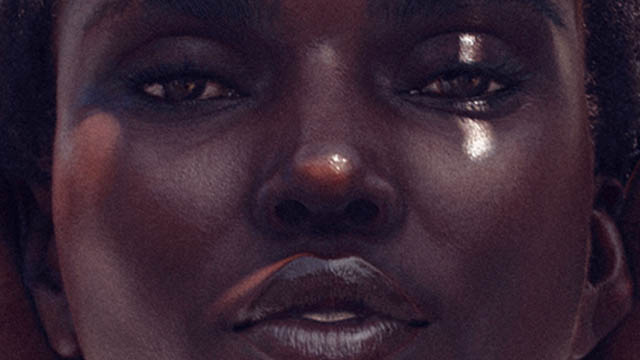
-
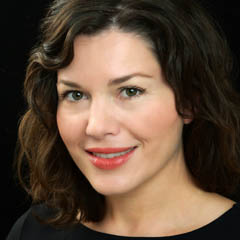 Hanni Geiger
Hanni GeigerShudu (2020), a dark-skinned mannequin based on Instagram and other social networks, is a CGI – a 3D computer graphic that, according to its creator Cameron-James Wilson (founder and CEO of the digital modelling agency THE DIIGITALS, https://www.thediigitals.com/), is considered the world's first digital supermodel. With currently more than 218,000 followers (@shudu.gram), she is one of the most booked models and has collaborations with major fashion companies such as Oscar de la Renta or the superstars Tyra Banks and Rihanna (Square, 2018). Yet the genesis of the mannequin and virtual influencer is anything but glamorous: after years as a photographer in the London fashion industry, Wilson retreats to his mother's garden shed in Weymouth, Dorset, and experiments with various design programs on a very cheap gaming computer (Jackson, 2018). In designing Shudu, he was primarily driven by a desire to work freely and “[…] focus on the art rather than the money” (Jackson, 2018). Shudu was intended to be a product of pure creativity, regardless of her later successful integration into the fashion industry (Jackson, 2018).
It takes a closer look to detect the artificiality from the model. Thanks to various digital image editing programs such as Marvelous Designer, CLO and Daz 3D, Wilson deliberately adds small flawed constructions to his very naturalistic-looking mannequin (Jackson, 2018; Square, 2018): scars, hairs, wrinkles and pores provide more liveliness, and thus also more “truthfulness”, if one were to argue in the Benjaminian sense with the aura of the unique or authentic. Basically, this is a completely contrary approach to high-end fashion photography, which classically aims to remove any physical imperfections from the human models until they mutate into doll-like, enraptured beings. This already shows through the external observation of the virtual model that „authenticity“ in the context of digital media and the outdated understanding of reality as distinct from virtuality must be rethought and oppositions in the technical, but also especially in the philosophical-social sense must be questioned.
In order to get closer to this „reality“ or the societal significance of the digital model, it is imperative to look at the controversial debates surrounding the black mannequin. As a white man, Wilson has more often had to face accusations of commercializing black culture, which is legal but equally questionable (Square, 2018). Under the rubric of “cultural appropriation”, “racial expropriation”, “racial capitalism” (Cedric J. Robinson) or “racist plagiarism” (Minh Ha T. Pham), the economic and social exploitation of inferior, marginalized cultures by the dominant white culture is understood as a neo-colonial approach, especially in the broad sector of industry. In this process, social as well as economic value is drawn from an ethnic identity, even generating a “commodity” from it, without thinking about the painful or unpleasant part or even giving minorities a share of the profits. Wilson's implementation of diversity and responsibility in the design process could, according to critics, be read as a clever marketing strategy – after all, “exoticized” phenotypes with very dark skin, high cheekbones and slender, tall stature are currently in vogue (Square, 2018). Particularly problematic in Shudu's design process appears Wilson's inspiration in the “Princess of South Africa Barbie doll”, a special edition Barbie launched in 2002 as one of the “Dolls of the World” collection (Khoabane, 2018). The digital avatar is said to have a similar origin and motivation: born out of the imagination of white companies and creatives to generate commercial success without knowing, considering or including the reality of people of color in the creation and sales process (Square, 2018).
For a holistic understanding of the figure, however, it is also important to analyze it beyond stereotypical argumentation and against the backdrop of its time, its creators and its consumers. As Generation Z and digital natives, the creators and users of virtual influencers are inevitably shaped by the technological changes of everyday life. Their thoughts and actions are primarily derived from the fascination with digital design, which increasingly merges the real and the virtual and makes physically, socially and culturally significant differentiations recede into the background. Wilson seems to use the technical qualities of the digital image, such as its mutability and ubiquity, to draw a picture of a decidedly plural, heterogeneous society in a sustainable way that is independent of time and place. Unlike the dys- and utopian visions of the future of human beings in classical fashion photography or in numerous digital drafts of human beings in art, the figure that exists only virtually seems to be the digital embodiment of a thoroughly real and, above all, present world of life characterized by diversity. With her obvious distancing from the white, male and Western-dominated political and economic mainstream, Shudu offers a template for breaking with the universalism of imperially knitted modernism via strategies of so-called inclusive marketing, which consciously considers diversity in the design process1.
The fact that the digital visualization of a virtual body that stands for diversity, such as Shudu’s, is particularly suitable for creating meanings around the human body, goes back to the postmodern discourse on the epistemology of the body and the knowledge attached to it. As Jay David Bolter recognized in the early 1990s, we as human beings know something by virtue of our bodily and social situations and not through a process of abstract and disinterested thought (Bolter, 1996, 85). Time, place and context thus determine the so-called specific “situated knowledge”, which can never be universal (Haraway, 1988). While in the 1990s transhumanist, biotechnological processes such as genetic engineering and cloning changed the body, in the (post-)digital age a new attention to the physical is evident, which is shifted to the realm of digital image production (Kröner, 2019, 72–73). What becomes evident is that despite the temporary disappearance of the human body through its dissolution into data and bits, it returns on screen in an altered and far more flexible form than the carnal. Posthumanism, following on from the tendencies of postmodernism, then makes use of digital image genesis and manipulation to base the epistemology of the body and its situatedness on the complete rejection of humanism as a Western-determined anthropocentric unity and superiority. These aspects could be relevant precisely to the reading of Shudu. The hierarchical scaling of people according to gender, ethnicity, class, sexual orientation, ability or age, which is characteristic of humanism, is to be fundamentally abandoned with the rejection of the onto-epistemological superiority of the human species (Ferrando, 2008, 438–439). Human interconnection, the symbiotic relationship with the non-human (Haraway, 2008; Wolfe, 2010) and the recognition of so-called “more-than-human geographies”2 are at the forefront of these conceptions of the body (Ferrando, 2008, 438–439). Beyond bias, dualisms and hierarchies, a (re)figuration of the human beyond the human that recognizes nature as well as technology in unity with the human (Haraway, 1985/2016) manifests itself in Shudu as a visual representation of Donna Haraway's cyborg figure. Thus, it seems that it is precisely thanks to the digital-technological “liquidity“ of bodies, techniques and media that Haraway's vision has been fulfilled: with the help of their transnational, hybrid nature, (digital) cyborgs develop subversive strategies of “writing” as a powerful form of political struggle against oppression (Haraway, 1988; Schmitz, 2016). Such “writing” (and thus also speaking) negates the dream of a common language and seemingly homogeneous identity (Haraway, 1988; Schmitz, 2016). In this respect, Shudu, as just such a (digital) cyborg, offers the template for multiple localization –against organic holism, unambiguous classification, and antagonistic dualisms (Schmitz, 2016).3
This then also includes the fact that virtual figures such as Shudu can be designed, consumed, exploited, criticized and thus also shaped on a global level in a socially, gender and culturally largely independent way4 – unlike the real, expensive Barbie dolls. With more images of underrepresented people in global circulation, habitual ways of seeing and thinking can be permanently changed, which could open up opportunities for marginalized groups, also from an economic perspective (Slay, 2018). With his collaborations with numerous representatives of the Black community as well as the Black staff team of hair stylists, make-up artists as well as also real Black models he stages for certain brands alongside Shudu (Square, 2018; Wilson 2021), Wilson intervenes in the working world and the economics of fashion. By consciously involving people of color in the design, styling, marketing, sales and profits of his company, his digital embodiments of elastic otherness impact the direction of a society that seeks to transcend Western-determined barriers – from a variety of perspectives and fields of action.
In this way, the initially small companies that originated in a decidedly plural society seem to be using both simple and advanced digital technologies to draw artificial images of a reality that has always been characterized by diversity and particularisms. The fact that the artificial figure (certainly also for marketing reasons and due to the entertainment industry) enters into a targeted interweaving with the analogue world through the staging with real people in real settings, increases its credibility and thus the social, economic and political influence of digital (human) images. Thus, these creators, who have long since outgrown their infancy and cooperate with big brands, seem to initiate a new “decentralization” of society as well as of the internet because of their politically underpinned messages about inclusion, heterogeneity and equal opportunities – and regardless of their possibly commercially colored motivation. If the dissolution of boundaries between the real and the virtual, nature and the artificial, the human and the non-human (Barron, 2003), and consequently also between art and commerce, responsibility and economy, truth and lies, majority and minority, genres, techniques and media no longer seem socially or scientifically relevant, the question of categorizing people according to skin color or ethnicity will no longer have to arise.
At this point, however, AI should also be taken into account as another possibility of digital “humanization”, which, in contrast to the purely external formation already described, concerns an “inner”, algorithmically controlled shaping of the “human-machine”. The juxtaposition of both types of artificial human creation becomes relevant in the question of the generation of “truth”, which algorithmically controlled AI – unlike the digital images and animations of social diversity mentioned above – in no way answers with the claim to represent the social cross-section. As a neural network, AI processes data such as words and images statically, it calculates the probabilities and says what the majority says and thinks (Simanowski, 2021). However, if the production of AI-generated “human images” is mainly based on large, Western-managed companies and the knowledge infiltrated into the machine is fed from data sets of a white, male majority belonging to the global North – without being externally curated or supervised – every minority and individuality is silenced (Simanowski, 2021): data inclusion on the one hand thus means the exclusion of diverse social structures on the other. This would, as it were, preprogram the return of the “gatekeepers” whose disempowerment through the internet was previously welcomed so enthusiastically (Simanowski, 2021). In this case, it becomes clear that technological progress does not necessarily go hand in hand with social progress (Simanowski, 2021).
Finally, it should be noted that the technologically induced change in the production and perception of the digital (human) image challenges us to critically rethink traditional systems of order. The interweaving with digital technologies seems to make the physical body and its interior comprehensible as an open system intertwined with its environment, whereby entrenched biases and dualisms could be invalidated and a multi-perspective view of society, politics and the economy could unfold. Whether this change in perspective can lead to a more open, even tolerant society in the long term will become clear in connection with further steps in the development and the future horizon of impact of the digital image in art, society, politics and science.
Footnotes
1) Inclusive marketing aims to create a sense of community through “authentic” cultural values inherent in the customer base. In doing so, the personal perspective of the designers, including their prejudices, should be excluded and a design for the whole of society that is as broadly conceived as possible should be created (Saputo, 2019; Maier 2021).
2) The term goes back to the findings of new cultural geography, which is based on theories of human geography. The aim of its research is to question the contemporary relationship of people to the living beings and things in their environment. Among other things, this involves the correlation between the human and the non-human, nature and culture, people and technologies. See most recently the events at the University of Bern on “More-than-human geographies”: https://www.geography.unibe.ch/forschung/sozial__und_kulturgeographie/lehre/seminar_mehr_als_menschliche_geographien/index_ger.html.
3) Against the backdrop of Haraway's theories, this multiplicity of localizations could then be conceived with the complete abandonment of the concept of identity, if relations were created based on choice in conscious coalitions and political kinship via so-called “affinities”. See Haraway 1988; Schmitz, 2016.
4) It is important to remember that although digital images circulate worldwide, they are not equally accessible to everyone in the context of divergent cultures, political, religious and sexual restrictions. Participation in a digital “global culture” is therefore always accompanied by exclusions, interruptions and detours.
References
- Barron, Collin (2003). A strong distinction between humans and non-humans is no longer required for research purposes: A debate between Bruno Latour and Steve Fuller. History of the Human Sciences, 16(2), 77–99.
- Bolter, Jay David (1996). Virtuelle Realität und die Epistemologie des Körpers. Kunstforum International. Die Zukunft des Körpers I, 132(November–January), 85–89.
- Ferrando, Francesca (2018). Transhumanism/Posthumanism. Posthuman Glossary, edited by Rosi Braidotti & Maria Hlavajova, Bloomsbury Academic, 438–439.
- Haraway, Donna J. & Wolfe, Cary (2016). A Cyborg Manifesto. Science, Technology, and Socialist-Feminism in The Late Twentieth Century (1985). Manifestly Haraway (3–90). University of Minnesota Press, http://www.jstor.org/stable/10.5749/j.ctt1b7x5f6.
- Haraway, Donna J. (1988). Situated Knowledges: The Science Question in Feminism and the Privilege of Partial Perspective. Feminist Studies, 14(3), 575–599.
- Harraway, Donna J. (2008). When Species Meet. Posthumanities, Volume 3, edited by Cary Wolfe, University of Minnesota Press.
- Jackson, Lauren Michelle (2018, May 4). Shudu Gram Is a White Man’s Digital Projection of Real-Life Black Womanhood. The New Yorker. https://www.newyorker.com/culture/culture-desk/shudu-gram-is-a-white-mans-digital-projection-of-real-life-black-womanhood.
- Khoabane, Rea (2018, May 20). Meet Shudu: the world’s first digital black supermodel. Sunday Times. https://www.timeslive.co.za/sunday-times/lifestyle/2018-05-19-mock-princess-meet-shudu-the-digital-supermodel-turning-heads/.
- Kröner, Magdalena (2019). Liquid Bodies. Ein subjektiver Überblick. Kunstforum International. Digital. Virtuell. Posthuman? Neue Körper in der Kunst 265(January–February), 72–115.
- Maier, Birgit (2021, February 5). Du bist nicht alle – warum inklusives Design uns all angeht und wie es gelingen kann. OnlineMarketing.de. https://onlinemarketing.de/marketing-tools/inklusives-design-geht-alle-an-wie-es-gelingt.
- Saputo, Sandy (2019, June). How Rihanna’s Fenty Beauty delivered „Beauty for All” – and a wake-up call to the industry. Think with Google. https://www.thinkwithgoogle.com/future-of-marketing/management-and-culture/diversity-and-inclusion/-fenty-beauty-inclusive-advertising/.
- Schmitz, Sigrid (2016, July 12). Cyborgs, situiertes Wissen und das Chthulucene. Donna Haraway und dreißig Jahre politischer (Natur-)wissenschaft. Soziopolis. https://www.soziopolis.de/cyborgs-situiertes-wissen-und-das-chthulucene.html.
- Simanowski, Roberto (2021, April 28). Identitätspolitik und künstliche Intelligenz. Es droht eine Tyrannei der Mehrheit (audio article). Deutschlandfunk Kultur. Politisches Feuilleton, ARD-Audiothek. https://podcast-mp3.dradio.de/podcast/2021/04/28/kuenstliche_intelligenz_identitaetspolitik_und_die_drk_20210428_0720_58851d76.mp3.
- Slay, Nick (2018, April 9). Twitter Reacts to Virtual Influencers: Is Shudu Art or Appropriation? The Source. https://thesource.com/2018/04/09/twitter-reacts-to-virtual-influencers-is-shudu-art-or-appropriation/.
- Square, Jonathan (2018, March 27). Is Instagram’s Newest Sensation Just Another Example of Cultural Appropriation? Fashionista. https://fashionista.com/2018/03/computer-generated-models-cultural-appropriation.
- THE DIIGITALS. Shudu.Gram. Instagram. https://www.instagram.com/shudu.gram/?hl=de.
- Wilson, Cameron-James (2021, April 30). How Digital Models are Changing the Face of Fashion. Lecture at the Online Conference „The Digital Image – Social Dimensions, Political Perspectives and Economic Constraints“, Ludwig Maximilian University of Munich, April 28–30, 2021.
- Wolfe, Carry (2010). What Is Posthumanism? University of Minnesota Press.
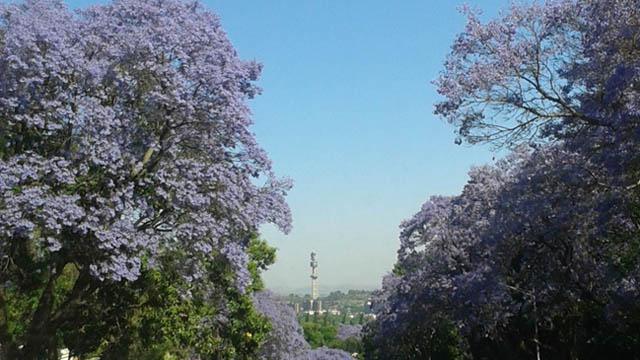
-
 Esther Kibuka-Sebitosi
Esther Kibuka-SebitosiThe image shows the deciduous large Jacaranda tree that grows up to 20-30 m high. The leaves are bipinnate produced in conspicuous large panicles, each flower with a five-lobed purple corolla. The fruit is oval flattened capsule containing numerous seeds. The Jacaranda in Pretoria flowers between September to November with purple flowers that paint the whole City purple. For this reason, Pretoria is called the Jacaranda city.
Known for its alluring lilac blossoms, the Jacaranda tree (Jacaranda mimosifolia) is native to South America and was introduced for decorative purposes way back in the 1800s to South Africa. In Pretoria, the Jacaranda was first introduced in Arcadia in 1888. Its beautiful flowers are characteristic of the springtime in Pretoria, City of Tshwane, Gauteng Province, where it fascinates the residents by putting a light purple carpet all over the roads.
Although the purple flowers remind the University students of the exams that take place around that time of the year, the elegant beauty of the Jacaranda flowers calms down the souls of many residents. Legend has it that when a flower from the Jacaranda tree drops on top of your head, you would pass all of your exams. Therefore, students wish for on eof the soft blossoms to drop one of its tubular flowers on their heads as they pass under this magical tree. The seeds, on the other hand, are enclosed in a brown, oval and flat capsule, which bursts open when dry, releasing flat winged seeds. They disseminate via wind dispersal to the savannah, woodlands, rocky ridges, riverbanks and all sorts of habitats.
To the conservationists, this deciduous beauty is an invasive species. Its origin is reported to be South America, particularly Argentina and /or Brazil because of the name’s Guarani origin in Argentina. The tree is regarded as an invasive species in South Africa and Australia. In South Africa, it is labelled as preventing growth of native species. However, in other parts of Africa such as Zambia, Zimbabwe and Kenya, the species is also present without being considered invasive yet.
In Pretoria, City of Tshwane, Gauteng province, the Jacaranda trees are enormous and line the pavement of the streets and inhabit roadsides, as evident in the images above. When they flower, they paint the whole City purple and it is spectacular to witness. The images portray the beauty and elegance of the tree that perhaps is draining the native ecosystem, which not to many are aware of.
Jacaranda blossoms are stunningly beautiful, but hidden underneath is the contradiction of the tree being an alien species that prevents indigenous trees from growing. Indeed, not “all that glitters is gold”. For this reason, the Jacaranda tree is no longer allowed to be planted in Pretoria.
Water scarcity is the most alarming problem of the twentieth century next to climate change in conservation. The sustainable Development Goal (SDG) 15 aims to protect, restore and promote sustainable use of terrestrial ecosystems, sustainably manage forests, combat desertification, and halt and reverse land degradation and halt biodiversity loss. In the meantime, SDG goal 11 promotes sustainable cities and communities. The dilemma of keeping the City green with trees and balancing the water ecosystems with the proper tree planting is a challenge that must be tackled through a multi-inter and trans-disciplinary approach to sustainable development. The Jacaranda tree is an example of this contradiction.
Apart from being beautiful ornamental trees, the Jacarandas' wood is used for furniture and other crafts. Meanwhile, programmes to address the social economic problems in communities were linked to alien species like the Jacaranda. These programmes aim at the sustainable management of natural resources through the control and management of alien invasive plants, by removing the species and thereby bringing employment to the youth, as part of the expanded Public Works Programme. The objective is to reduce the impact of invasive alien trees on water resources.
All over the world, trees and plants are introduced for various purposes. These trees contribute to multiple services for instance fodder, timber, medicines, fruits, shade and ornaments. Now as resources become scarce - especially water -, conflicts are beginning to emerge. Benefits and costs of these species are weighed against the endurance of the people and impact on the environment. Many strategies involve physical removal of alien vegetation. The benefit-cost analyses conducted so far have shown that the investment in clearing invasive species cost for example R116 in riparian areas, which equals about 6,40 US-Dollars (Marais and Wannenburgh (20008). However, it is important to remember that clearance seldomly results in total elimination.
References
- Jacaranda Jacaranda mimosifolia, retrieved from http://www.invasives.org.za/legislation/item/265-jacarandajacaranda-mimosifolia
- Marais, C and Wannenburgh, A.M. (20008) Restoration of water resources (natural capital) through the clearing of invasive alien plants from riparian areas in South Africa — Costs and water benefits.
- South African Journal of Botany 74 (2008) 526–537
- https://www.news24.com/Archives/Witness/Theyre-beautiful-but-jacarandas-can-do-harm-warns-expert-20150430
- Bolsmann, E. (1997). Jacaranda – Pride of Pretoria. Pub Be My Guest Publishers, Pretoria pp. 40.
- Potgieter, M.J and A.Samie (2019). Ethnobotanical survey of invasive alien plant species used in the treatment of sexually transmitted infections in Waterberg District, South Africa, retrieved from: https://doi.org/10.1016/j.sajb.2019.01.012
published May 2020
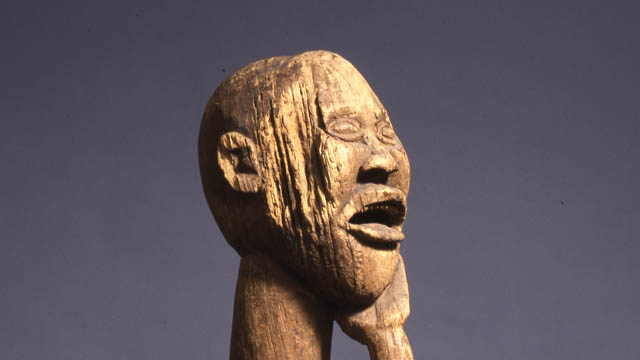
-
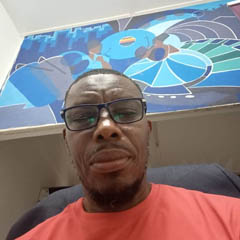 Joseph Essuman
Joseph EssumanChoosing this object stemmed from my experience I had when my mother passed away in my arms. It was a painful reminder of mum's death when I saw the facial expression of the object. The question was; ‘So after all the painful moments she went through, she could not stay a little longer for me to pamper her before she died’? I therefore want this to be part of the project so that the world would appreciate responsible mothers and motherhood no matter the circumstance.
To be a mother marks female social completion in Africa especially among Ghanaians where motherhood is a pride. Without it, one is not quite an adult, or certainly not an adult who receives full respect. Images of this nature, especially in most communities of Ghana are very significant because of the belief systems of the indigenous people before conversion to Christianity or Islam. Though not so common today as a result of modernization and or Christian and Muslim religion as compared to a decade or two ago, it is still believed that, regardless of the changes in time and technology, these beliefs are still as revered as it used to be.
This work is a wood carving in the round portraying a standing, heavily-pregnant woman with her left hand on the chin; but laid on the left breast with the right-hand providing support beneath her belly. The legs are bent at the knees and she has a painful facial expression.
It is a semi-abstract form of work that is 161cm high which stands firmly on a pedestal. The pose of the figure gives an idea of life and death. The opened wide mouth indicates the pain she must be going through and the hand beneath the belly indicates a support for the weighing pregnancy and support for the unborn child.
The concept behind this piece of work depicts strain and stress most women go through before giving birth and it symbolizes fertility and good health. The elongated breasts suggest the vulnerable state of the woman though it has lots of breast milk to feed the unborn child.
This carved image is a representation of a pregnant woman which signifies life. This figure could be interpreted to represent several ideas in different cultures. However, Costa (2019) opined that, a wooden figure of a nude pregnant woman, which has been present at events, is not the Virgin Mary, but a female figure representing life.
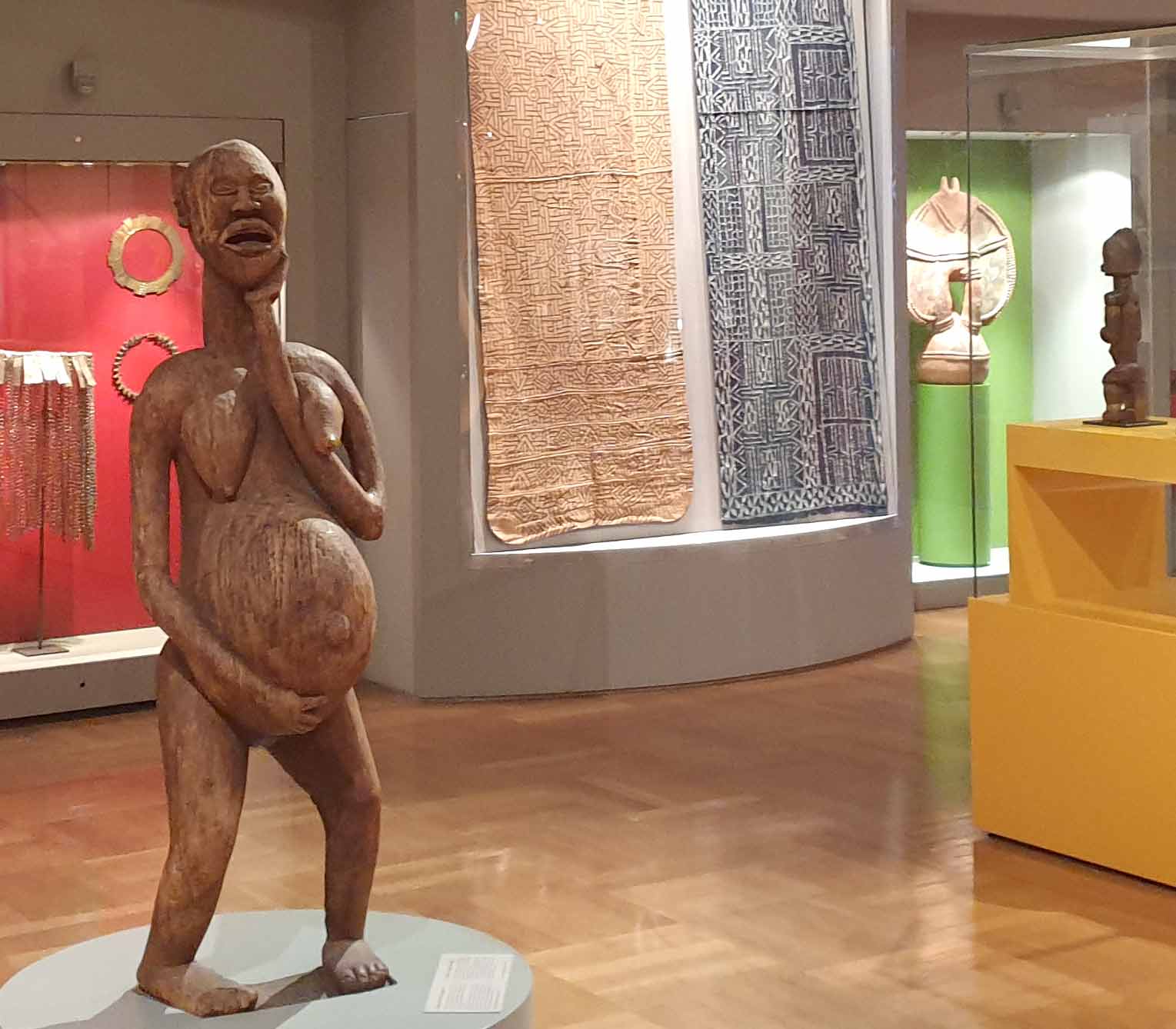
Anonymous artist, first half of the 20th century, wood, 161 cm, Bamileke, Cameroon (Photo Ernst Wagner)
In a similar narration, Costa (2019) said that, a wooden figure of a pregnant woman has been described as both a Marian image and as a traditional indigenous religious symbol of the goddess Pachamama, or Mother Earth. Costa maintained that it is an indigenous woman who represents life; it is a feminine figure and is neither pagan nor sacred but represents life through a woman.
Fundamentally, many indigenous Ghanaians believe that women are like trees that produce and reproduce to sustain life continuity. The woman is also believed to be a fertility goddess. It is with high esteem therefore that Ghanaian women who are capable of giving birth are exalted. As a result, these images or similar ones have been used to ‘serve’, particularly in the Akan and Ewe dominated communities in Ghana. They are seen as religious figures, an expression of health, fertility and grandmother goddesses, and they have over the years served as ritual or symbolic function.
Without children one cannot have a traditional funeral nor become an ancestor. While these issues relate to men as well as women, infertile men can acquire children through cooperative wives who ensure they become pregnant. Unfortunately, per the traditions of Ghana, women do not have that option. In practical terms, wives who are childless may be divorced or have to accept a co-wife. They have no support in their old age, if their husbands die, because that is the duty of children. In extreme cases, they are sometimes ejected from the husband’s house no matter their economic or social status and endure the pity or mockery of family members, friends, and acquaintances.
In most communities in Ghana, it is believed that babies born after a longed-for conception often bear names that reflect their mothers’ anxiety. For example, ‘Brenya’, which literally means “suffer and get” is such a name from the Akan people of Ghana. Also, ‘Nukomeko’, which literally means “I just laugh” is one of the names from the Anlo-Ewe of southern Ghana. These names are among many examples that reflect joy, triumph and satisfaction in a successful delivery after the pain of barrenness. Other names pointedly refer to previous distress and are meant as retorts to those who might have tried to block their pregnancy or had made fun of them. Examples are; ‘Dzitorwoko’, literally means “Only those who have the heart”, Azunukpenawo “It will be shame unto them”, or Nyavedzi “Matter that grieve the heart”. There are other unpleasant names that parents give their children as a mockery in return for what they suffered from either family, and/ or for child mortality. This has been buttressed by Agyekum, when he says that,
“the Akans, like other cultures in West Africa, believe that if a mother suffers constant child mortality, then the reason is that it is the child’s mother in the underworld that does not want the child to stay in the living world. To combat such an unfortunate situation, the parents give the child a weird name (2020: 221).”
For instance, a name such as ‘Asaaseasa’ which literally means ‘the land is finished’ is one of the many names that is used to combat such a situation. This suggests how important pregnancy and childbirth are revered in most communities in Ghana.
So, in the olden days in Ghana, just like in many parts of Africa, girls have received doll-like figures to care for – not as playthings when they are children, but as teenagers preparing for marriage. This sometimes occurs during initiation practices, when their attentiveness may be assessed. In the meantime, the girl would be detached from her family and allowed to stay alone in a small structure. The doll serves as her sole companion, and she “feeds” it, washes and oils it, decorates it with seed beads at neck or hips, and otherwise tends it like the infant she hopes to bear. Most of these dolls are made of females, as their breasts and genitals indicate. The reason being that, female children are especially desirable in order to increase the size of the matrilineage despite the desire that fathers always want their names to remain as a memorial for generations yet to come.
In direct reference to the subject under review, it is suggested that the woman is undergoing some form of pain. But as to whether it is a labour pain, abdominal pain, or crumps, could be a subject of debate depending on individual’s discretion.
It is good that technology has improved greatly over the years and there is a complete education on pregnancy as I try to analyze this piece of artwork. It is therefore necessary to note that these forms of education are very essential and there is no doubt that it will remain useful and also see tremendous improvement with time. Most of these challenges are normal occurrences during adulthood as stated earlier. It is in sharp contrast to what is used to be the case among other people across the globe where such issues are most often associated to evil spirit attacks hence creating fear in prospective mothers and a potential threat to motherhood.
It is relevant to note that womanhood is an undisputable way to ensure life’s continuous existence. In that regard, one can conclude that this artwork is tangible, contextually realistic (though physically semi-abstract) and precise to address the question of whether it communicates, represents or symbolizes the argument in the text. The world today and future will find its educational and cultural relevance as outlined in the context above. It is also appropriate to conclude that the interpretation of the meaning of the object was based not only in the belief systems of Ghanaian communities but transcultural significance and sensitivity to cultural aspects with regards to tolerance and respect as subjects of consideration.
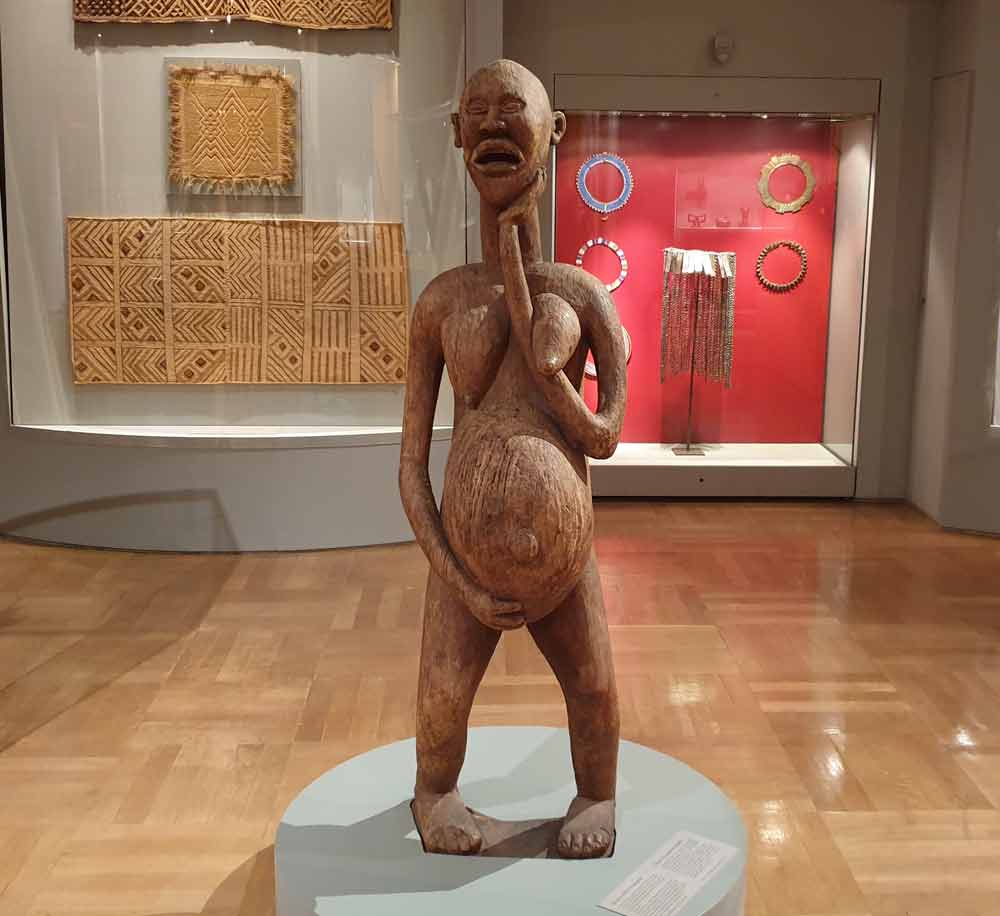
Anonymous artist, first half of the 20th century, wood, 161 cm, Bamileke, Cameroon (Photo Ernst Wagner)
References
- Costa, G. (2019). A communications official for the Amazon synod: https://www.catholicnewsagency.com/news/amazon-synod-final-report-an-instrument-communications-official-says-36081. Retrieved On the 19th March, 2020.
- Agyekum, K. (2006) The Sociolinguistic of Akan Personal Name: http://www.njas.helsinki.fi/pdf-files/vol15num2/agyekum.pdf. Retrieved On the 19th March, 2020.
This article is part of a gallery: Perspectives from Ghana on Museum Objects in Germany, published January 2021
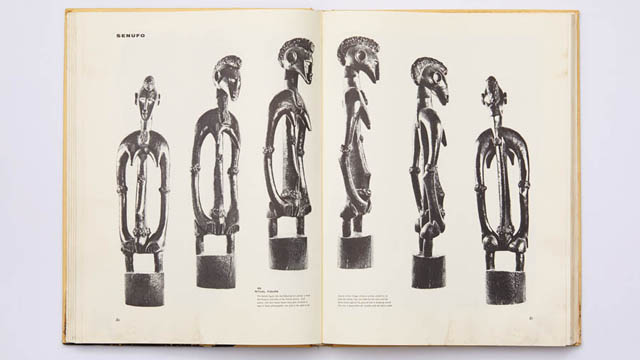
-
 Niklas Wolf
Niklas WolfPhotography as a technique and medium is questioning terminologies of truth and representation as part of the respective and genuinely inscribed authorship of technically enhanced images since the emergence of early photographic works. Through rapid and widespread distribution in print media, photographic images soon became part of the formulation and documentation of shared visual memory in the Global North.
Walker Evans, the father of documentary as one web article states1, heavily influenced the style of modern (not meaning contemporary) photography. His importance as a photographer is essentially based on the photographs he took during the Great Depression in the mid-1930s. The photographic portraits of the three US-american tenant families Fields, Borroughs and Tingle became icons of photographic history and formed the general visual representation of this era by telling a story (in the sense of a historical narrative) at the same time. They, thinking like Evans here, document the person(a), meaning identity or essence, of white, hardworking americans, who, even if they struggle, keep up their integrity. They represent a socio-cultural construct in insisting on their ability of showing, ordering and defining the truth. As Evans' images focus on an American underclass of the time, they show the author of those pictures as part of their own reality.
How does the search for some kind of visual truth in modern photographic images take place when they seem to not look for their own but for the other, which is imagined to be foreign to them and mostly without history? What kind of approach to questions about history and its narratives are they able to re-present as a consequence?
Concepts of history are always entities that reveal just as much about their architects as they do about the evidence integrated into them, which represents constructors and construct at the same time. History rarely appears in a singular form, is never neutral and always normative. It is part of its own discourses, demands order as well as testimony. In documentary terms, the latter (the testimony) should legitimize science and itself. Ordering structures and strategies, on the other hand, require places and institutions where they can appear. Gazes at the end of which historical narratives should stand are seldom equal. Often they are one-sided observations, classifying and hegemonic, alienated observations through mimetic imitation or intended othering. The basis of such categorical observations are specific techniques and strategies for appropriation; results are metaphors or emanations of one's own reality.
The exhibition African Negro Art, which was on view at the Museum of Modern Art New York in 1935, marks the beginning of the institutionalized exhibiting of so-called (or labeled) African Art at major western art museums. Finally coining a terminology often still used today, 603 African objects were exhibited at the MoMA from March 18 to May 19 1935. Walker Evans was commissioned to (literally) photographically document the objects on display.
The resulting images are characterized by long exposure times, which made it possible to guide a light source around the respective object while the cameras aperture was open. The illumination is therefore mostly impressively uniform and soft, strong shadows and the constitution of space are avoided. The images have a hyperfractual clarity.2 The surface of a Bamende facemask for example is uniformly illuminated, the exposure emphasizes the contrasting structures and lines, the formal essence, if one would say so. The actual plasticity of multidimensional objects becomes obvious in a second shot. The face of the same mask appears to be pointedly drawn forward, the slight inclination of a wide comb only becomes apparent here. It almost does not seem to be the same object, so much does the first shot focus on the ornamental surface. Evans used an 8 x 10 medium format camera, the resolution of the images is correspondingly high. The partly dramatic concentration on the object causes a visual monumentalization of things, image sections are often claustrophobic narrow - the objects are not relationally representative, but are re-presented according to their formal characteristics, analyzed by the photographer. This leads to major shifts in reception. One of Evan's most effective images is the photograph of a Pende pendant made of ivory. As if from nowhere, from a timeless, deep black and imponderable background, the masks face emerges from the pictorial ground. The focus lies on the middle plane of its face, which is photographed using a large aperture. Therefore initial blurring starts as early as behind the eyes of the carved face. It is shot from above, not from the front. Viewers are urged to imagine the figure's body (which is neither present nor laid out in the object). Deep shadows let the face appear threatening and alien, framed by sharp contrasts; it becomes clear that the intention of the mask cannot be a good one. Evans gives the alien object an equally alien character, an emotion. The mask stands pars per toto for the ‘other’, the uncanny.
Evans photographs were published quite widely. Starting with the exhibitions catalogue they were used in several publications by the exhibitions curator James Johnson Sweeney focusing on the ‘Art’ of Africa in a broader even more general and art historical perspective: the generalizing and educative intention of pictures and text is already foreshadowed in the somewhat holistic titles of such publications - African Folktales and Sculpture (1952) and African Sculpture (1964) for example . Entering the realm of the photobook as a medium Evans photographic images become part of semi-theatrical stagings, some kind of educational character is inscribed into them, especially looking at the close interlacing of text and pictorial object. Ultimately, the message and content of the images are only self-referential. Evans photographs where often published together with the ones of Elitot Elisofon, who amongst other jobs worked as a photojournalist for the LIFE magazine. In The Sculpture of Africa (1958) Elisofon makes use of the photobook as a medium very consciously. For example he uses different photographic views on the same sculptural object to kind of animate it in a cinematic way, using the photobook as an idea to look at three-dimensional properties of things in a two-dimensional way, making the accessible by flipping through the book. Both photographers work is often labeled as having a documentary style, both seem to have a special interest in photographically analyzing pictorial qualities of the surface and materiality of the things they look at. Exposure and contrasts (re)produce haptic qualities and material properties of the things being looked at through the camera quasi argumentatively, based only in the photographic objects themselves.
Methodically, Walker Evans' documentarism is ergo characterized by the omission of object-immanent information and the simultaneous genesis of image-immanent content. His pictures do not allow conclusions to be drawn about the size, material and context of the representations; a mostly unspecific monochrome background detaches the objects from the contexts inscribed into them. The photographer repeats aspects of the aesthetically and content-wise neutral display of a modern art exhibition and demands that the images focus on purely formal aspects. The representations do not permit any connection between the signifiers in terms of content. In narrow sections, each object is presented in a very specific view - the photographic images ergo become significant only in a Western canonical art context, shifted to its terminology and histories.
Stylistically, Evans' photographs can be described as clean and cerebral.3 The images of African objects are clean (and timeless) in the sense that they are cleansed of any context; they are cerebral in the sense that they are open to new inscriptions and attributions. The highly specific aesthetics of the images serve to conceal and reveal equally specific information at the same time, they are markers of tailored representations4 which are more the presentation of Evans as the author of those images and his techniques to strip pictorial objects from their original terminology and historical narratives, than the representation in the sense of a documentation of the object shown.
1) https://www.theguardian.com/artanddesign/gallery/2015/dec/03/walker-evans-documentary-photography-great-depression-gallery; 15. Juli 2020.
2) Cf. Campany, David: Walker Evans. The magazine work, Göttingen 2014, S. 52.
3) Cf. Strother, Z.S.: Looking for Africa in Carl Einstein’s Negerplastik, in: african arts Winter 2013 VOL. 46, No. 4, S. 8 – 21, S. 8.
4) Cf. Webb, Virginia-Lee: Perfect Documents. Walker Evans and African Art 1935, New York 2000, S. 15.
References
- Eliot Elisofon: The Sculpture of Africa (text: Ralph Linton, William B. Fagg), New York 1978
- James Johnson Sweeney, Paul Radin (eds.): African Folktales and Sculpture, New York 1964
- Kerstin Pinther, Niklas Wolf (eds.): Photobook Africa. Tracing Stories and Imagery, München 2020
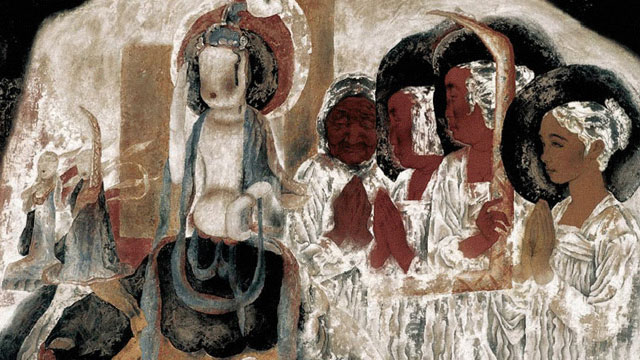
-
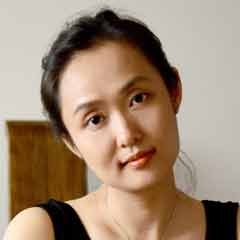 Ming Zhang
Ming ZhangThe importance of the series entitled by "Dream of Dunhuang"
The Dunhuang Dreams series from the 1990s marked the emergence of a new opportunity for meticulous figure painting. After his in-depth study of the Dunhuang murals and his many field trips, Yongli Tang drew inspiration, adhered to the core of traditional painting and incorporated the expressive strengths of Western painting to achieve a bold innovation in artistic expression.
In the creating of meticulous figure paintings, there are three crucial ingredients, including the use of line, modeling and coloring.
Modeling and Line
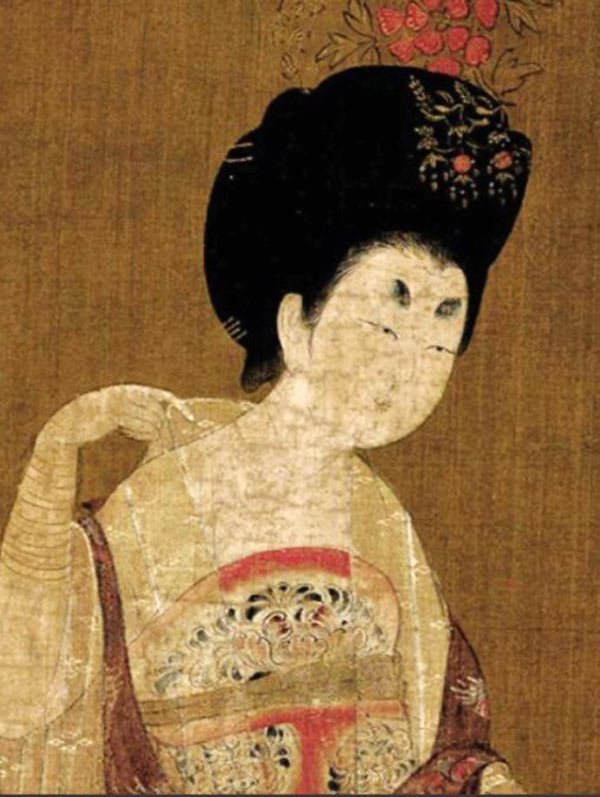
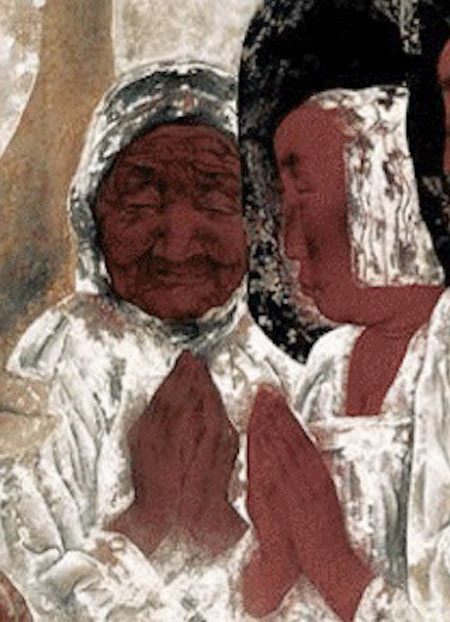
Fig. 2: Part of painting of hairpin ladies in the Tang Dynasty ,Zhou Fang, active late 8th–early 9th century, Ladies Wearing Flowers in Their Hair, handscroll, ink and color on silk, 46 x 180 cm, Liaoning Provincial Museum, Shenyang province, China - copyright: public domain / Wiki Commons.
Fig.3: Part of Memories Of Childhood, Yongli Tang, 1998, Copyright: the artist.Line is the most basic language of Chinese painting, and Chinese painting is concerned with the use of frames and calligraphy and focused on the expression of the structure and rhythm of the object's form, instead of the shading and the in-depth of the object. The series of works is mainly presented by the use of line in the traditional painting while the shading and the linear perspective of the sketch is enlighteningly integrated in the form of relief. The series Dream of Dunhuang innovatively uses linear sketches to portray and shape exaggerated figures, with extreme variations between lines. The spirit of the lines fits the mood created by the picture, while the light and dark faces are integrated to provide a detailed portrayal of the main figure. The juxtaposition of realistic and extracted Dunhuang symbols, modern and ancient figures, temporal and spatial wholeness, and a conceptual form of expression are harmoniously presented in the picture, and the modeling has both traditional cultural roots and modernity.
Coloration
Dunhuang murals have undergone thousands of years of natural and man-made changes in color, with some peeling and mutilating. It looks like a rich, deep, ancient palette that allows the viewer to achieve a secondary aesthetic pleasure. Being in the sacred, quiet rock cave, the soul is purified, and the individual remains in the flow of the years, achieving spiritual transcendence.
In order to pursue the sense of history in Dunhuang murals, Yongli Tang used Black and White as the main colors and interspersed with azurite, stone green, earth red and other traditional colors for embellishment. The color of cooked brown was used to present the figures’ skin. The author could not be confined with the realistic object so that he exaggerated color changes to highlight the subjective emotional orientation of the picture.
In the series of works, virtual dyeing method was innovatively applied to highlight the freehand of the picture. Dyeing high places or low places could be switched freely according to needs, and dyeing is not limited by the line, which presents a vague sense of void. In addition to the traditional color setting techniques, for example, flat painting, rendering and over-dyeing, the author developed the method of shedding. The thick painting and shedding methods set off each other. To be more precise, the author piled up degummed white powder on the base color, then chafed and patted, with some of the white powder falling off naturally. The rest was blended with the base color. The use of large areas of white color does not cause the picture to be chalky. During the painting process the shedding of white color is like the painting of the freehand work. With the controlled brushwork, there are uncontrollable and accidental factors, which gives the mottled and dappled left on the murals by the years. The thickness, light and dark, cold and warm of the white color is presented in an exceptionally subtle way, creating a harmonious and quiet relationship between religious culture and modern beliefs.
Material Texture
Stable social and cultural environment made the painting language of meticulous painting was solely and smoothly developed for quite a long time. In the late 1980s, political, economic and cultural changes leaded to the activation of the painting community and the reflection on tradition. New painting materials were triggered a change in creative thinking.
In his artistic practice, Tang Yongli discovered the texture beauty of the materials and used it in the painting process: mineral colors have a sense of luster, strong covering power, and can be repeatedly modified; the watercolor is rich and delicate; the shedding effect of degummed white powder reproduces the oxidation and wind erosion of mural; the layering of these colors gives the picture a sufficient sense of history and ethereal inspiration. Tang Yongli uses this as an opportunity for a new language, to expand and to strengthen it, as well as to form a new language paradigm. The beauty of the material texture becomes part of the creation and an aspect of the work to be tasted. The author chooses colored silk as the bearer, which is tough and can be used in a variety of techniques such as thick painting, shedding and reverse painting, and pigments such as ink, mineral color, lithopone powder and watercolor are used.
Classical meticulous painting can only do addition, not subtraction. The use of these material techniques breaks the border of the painting on silk. It also allows us to add and subtract freely and to change a single direction to a multi-directional expression (i.e., highly realizing self-consciousness). The expression of the free state of mind, workmanship, painting, color, texture and other factors become a new organism.
Summary
The series of Dunhuang Dream presents the interaction of multiple factors, scholarly artistic interrogation and the creation of diffuse imagery, as well as the attribution and transmission of spirit. It opens artistic horizons for the modern development of meticulous painting. The development of Chinese contemporary art has always been to move forward with the review and inheriting of history. They find visual art resources to reinterpret, redevelop and re-create them with a contemporary view, thinking and aesthetics, which will form a dynamic and growing tradition.
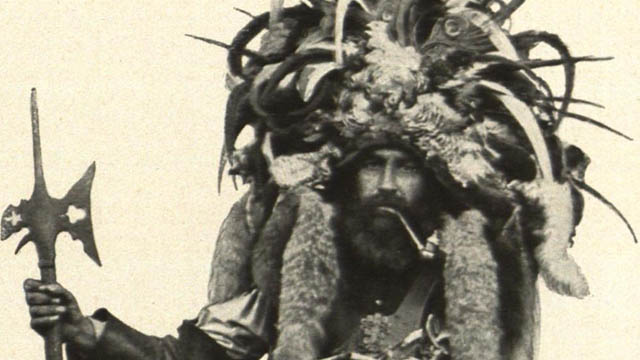
-
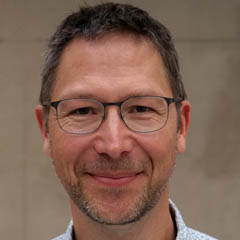 Werner Bloß
Werner BloßAdministrative, esoteric and patriotic purposes until the first half of the 19th century
After an initial sighting the clothing can still prove to be expectable in the context of its time and regionality. While the medieval weapon seems useful for the guard's task, the hat's purpose can be seriously doubted. But peculiar as the outfit might be, it must have identified its possible former wearer as a civil servant, who was authorized, e.g. to punish violations of the rules. To protect the vineyard, a Saltner had to be reliable, vigilant, fearless, persuasive and loud. In addition to this executive function, there was also an esoteric one: Myths have developed claiming that a Saltner is able to defend himself successfully not only against thieves and ravenous animals, but also against attacks from the otherworld. Thus, the formerly more modest hat might have taken on a fetish-like function as well, alongside an expectedly Christian context — similar to the magic „Hexenkreuz“ (a shoe-length iron forged in the shape of a cross, von Hörmann 1872, p. 41-47) which should be part of the equipment of a Saltner too.
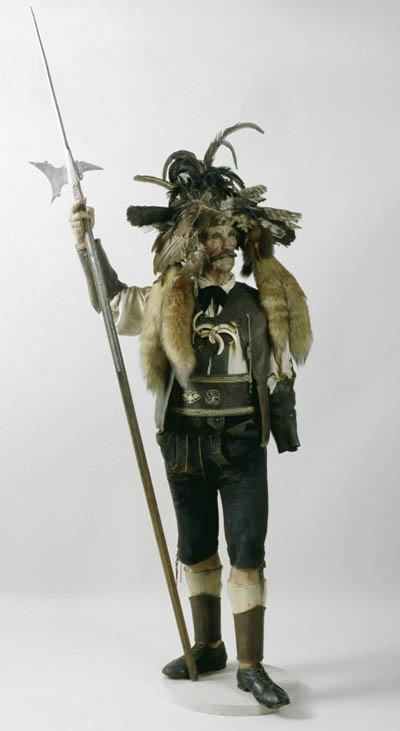
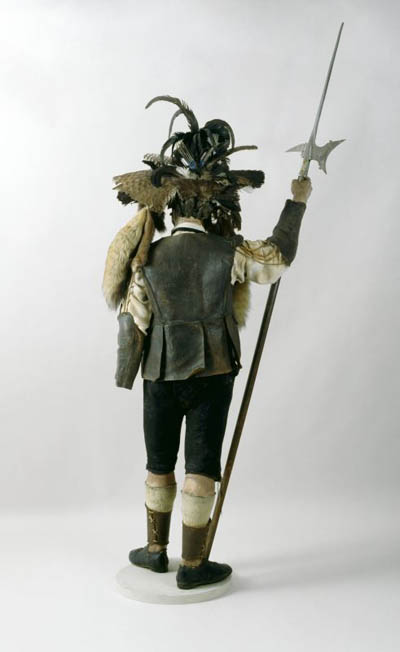
Fig. 1, 2: Meraner Saltner, Germanisches Nationalmuseum, 1875/1899 © Germanisches Nationalmuseum
In addition, there are other striking features of the costume. Apart from the hat, many handed down costumes of vineyard keepers look very similar to that of an outstanding Tyrolean folk hero. As to the beard, most vineyard keepers on contemporary pictures also come very close to Andreas Hofer, the leader of the Tyrolean popular uprising of 1809 (fig. 3). Thus, two hero constructions could be woven into the image of these objects: the brave guardian with supernatural powers and the defiant folk hero who successfully defended his country against the Bavarian occupiers (at least for a short time).
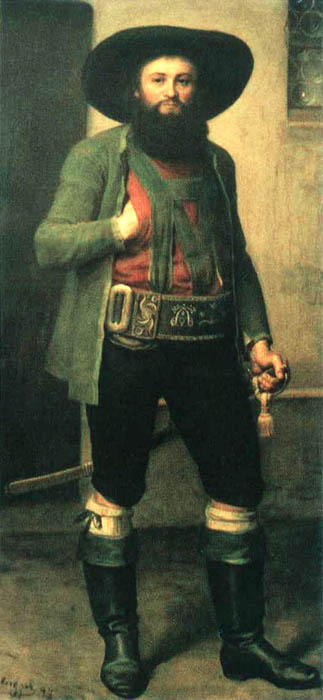
Fig. 3: Franz Defregger: Andreas Hofer, 1894, oil on canvas, Tiroler Kaiserjägermuseum, Innsbruck (© CC-BY-4.0 CC)
Tourist purposes in the course of 19th century
A steady evolution of this appearance towards hypertrophic splendor (cf. Ramming 1997, p. 119) could be observed. Whom did the vineyard keepers want to impress? Did the scary outfit or its models also have the function of a lure, even a courtship dress? One could speculate a lot about this, as well as the question of the addressees and the success of this posing in the rural environment. Indeed, there were harsh rules that state how vineyard keepers had to behave towards women (cf. von Hörmann 1872). Like the myths of nocturnal seduction attempts by witches in the vineyard, they also point to the possibility of their transgression (Matscher 1933, p. 217). The clearest indications of courtship even in the sexual are found indirectly where the vineyard keepers discovered their tourist attractiveness in the later 19th century. Here it was not only a matter of inspiring the exoticism expected from the outside. The Saltner in the role of „Papageno“ (Halbritter 2005, p. 88) offered a masculine performance to a changing — even female — audience, too. And the public, frightened by the wild man in the vineyard, gladly paid for this thrill with the usual, officially regulated tax for trespassing — and then sent a postcard with a picture of such a strange imposing guy out into the world (op. cit. p. 88-104, fig. 4).
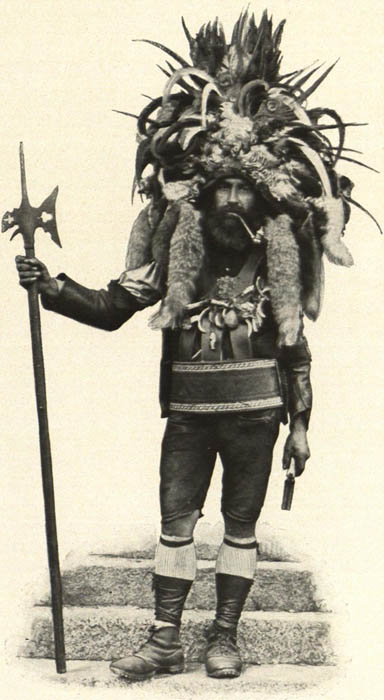
Fig. 4: Meraner Saltner. Postcard sent 1907. © CC-BY-4.0 austria-forum.org
Use in the attempt of nation building until after 1900
The emergence of traditional costumes in the 19th century was due to an increased interest in regional distinctiveness. The dependence on supra-regional trade, a corresponding desire for a special appearance and the burgeoning tourism in picturesque South Tyrol drove this development further. The purchase of the object by the GNM in 1899 was completely in line with the museum's historistic concept. Unique characteristics were to be collected to support the idea of nation-building in the German-speaking area which includes parts of South Tyrol (Austria till 1918, then Italy) too. The interest in the costume can thus be attributed to an implicit concept of „Großdeutschland“, the desire for identification even far beyond the national borders of that time (and also today). In 1905 the Saltner-figurine became a part of a multi-figure panorama of German traditional costumes in the museum. But 100 years later Jutta Zander-Seidel, curator of the exhibition „Kleiderwechsel“ (that means "change of clothes") at the GNM judged harshly about the former exhibition practice: Neither does the object represent the peasant costume of the past in its historical authenticity, nor does it reach beyond documents of historicized festive culture at that time (cf. Zander-Seidel 2002, p. 76).
From carnival use to cultural appropriation and appreciation
On top of that, the object wasn't even bought in South Tyrol at all, but from a Munich costume fund. The painter Franz Defregger is said to have worn it at a Munich artists' masked ball in 1883 (Ramming 1997, p. 16-18). Was it merely a product of his imagination, made to poke fun at the strangers across the near borders, at those archaic mountain people with their culture, which at the time was perceived as weird, backward, even exotic? There is evidence that Defregger designed costumes too (Irgens 2010, p. 14).
Then it would also be possible that parts of the costume were actually copied, e.g. by using early photographs of Native Americans, perhaps to make the appearance seem even more exotic. The foxtails hanging down on both sides of the face, the necklace of wild animal teeth or the splendor of the feathers come quite close to such cliché images. And Franz Defregger showed great interest in Chief Rocky Bear, for example, whom he met and portrayed in 1890. Rocky Bear had come to Munich (Bavaria) with Buffalo Bills' Wild West Show as a living exhibit (Assmann e.a. 2020, p. 123). But this was seven years after the masked ball. In addition, the object at the GNM is said to have been touched up in the early 20th century, so that it could fit the cliché of the pictorial and written sources of the 19th century even better (Selheim 2005, p. 274).
In the same supposedly colonialist view, Defregger made a painting for an Austrian encyclopedia called „Kronprinzenwerk“ (1885-1902, fig. 5). In this illustration, the figure of the Saltner is used just as clichéd and exoticizing for his country, Tyrol, as we know it, e.g. from images of snake charmers and the Indian subcontinent. But the picture shows a man who looks much like both the Nuremberg specimen – and the artist himself. Could this still be a form of self-exaltation, an act of othering (Said 1985)? If we take into account that Defregger himself was a native Tyrolean, this perspective escapes its chauvinistic dress and shows us a completely opposite form of individual expression and a corresponding search for identification: When abroad, the successful painter dressed like a person of status in his native country.
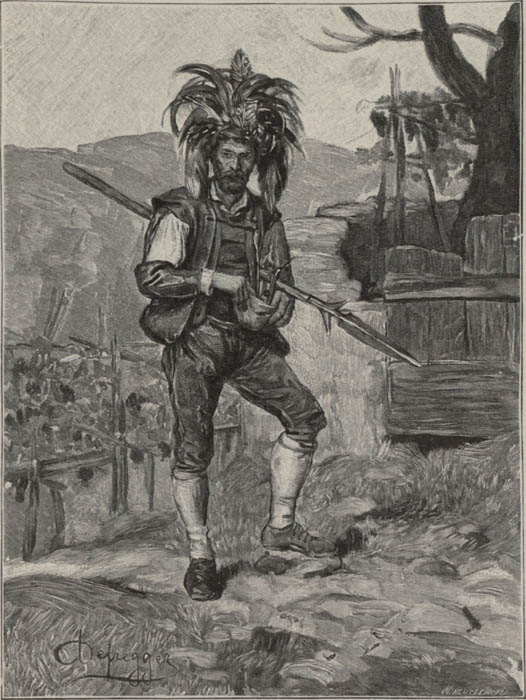
Fig. 5: Franz Defregger: Ein Saltner bei Meran. 1890, Xylography by M. Kluszewski. © CC-BY-4.0 austria-forum.org
Conclusion
It has taken one century for this change in function to be clearly named in the GNM (cf. Zander-Seidel 2002, p. 148): from an uncertain practical object of use to a product of tourist expectations, from a carnival costume to a decided construction of national identification and back again. The outfit of the vineyard keeper is neither particularly artistic nor valuable. But the questions it is able to generate lead far into a dense field of visual communication across times, national borders and continents, to ideas of foreignness and (self-) exoticization and ultimately to the question of how we deal with them today. The costume of the Saltner and its related outfits seem to come from the supposedly “good old time“. But they illuminate a rather fleeting moment in which historical upheavals in Europe (e.g. early globalization, increased emigration, advanced secularization, consequences of colonialism, desperate search for identity and nation building) are reflected in a peculiar object. They can lead to the question of how to deal with other traditions on the one hand or with the individualization of (male) appearance (e.g. in the later star cult) on the other. The fact that a whimsical hat can still serve an extremely dubious yet visually powerful purpose today was demonstrated by the million-fold shared footage of the self-proclaimed "shaman" storming the Washington Capitol in early 2021.
Special thanks to my students at Gymnasium Wendelstein who enriched this analysis with plenty of valuable questions and discoveries.
References
- Assmann, Peter/Irgens-Defregger, Angelika/Hess, Helmut. 2020. Defregger. Mythos — Missbrauch — Moderne. Innsbruck, München: Hirmer.
- Ramming, Jochen. 1997. Weinberghüter und Heimatwächter. Der ‚Meraner Saltner‘ zwischen Amt und Emblem. In: Jahrbuch für Volkskunde 20. Paderborn. München. Wien. Zürich: Schöningh. p. 116-141.
- Halbritter, Roland. 2005. Saltner – Weinberghüter – Touristenschreck – Vogelscheuche – Papageno – Alpenindianer. „Ihm gebe Kreizer a comprar tabacco; dann still sein gut Freund“. In: Der Schlern, Bozen. August edition 2005, p. 88-104.
- Irgens, Angelika. 2010. Was Tiroler und Indianer im Herzen verbindet, Bayerische Staatszeitung (BSZ). 23.04.2010 (ePaper) and: Unser Bayern 4/2010, München (Verlag Bayerische Staatszeitung)
- von Hörmann, Ludwig. 1872. Die Saltner. In: Der Alpenfreund, Monatshefte für Verbreitung von Alpenkunde unter Jung und Alt in populären Schilderungen aus dem Gesammtgebiet der Alpenwelt und mit praktischen Winken zur genußvollen Bereisung derselben. Dr. Eduard Amthor (ed.), Volume 5, Gera, p. 41-47, proofread for SAGEN.at by Mag. Renate Erhart, august 2005. Spelling carefully reworked and brought up to date: http://www.sagen.at/doku/hoermann_beitraege/saltner.html. Called on 7.02.2021
- Matscher, Hans. 1933. Der Burggräfler in Glaube und Sage. Bozen 1933. Found at sagen.at and carefully reworked by Leoni Wallner. December 2005. http://www.sagen.at/texte/sagen/italien/meran/burggraefler_matscher/wimmetzeit.htm. Called on 7.02.2021.
- Said, Edward. 1985. Orientalism: Western Conceptions of the Orient. London: Penguin Books.
- Selheim, Claudia. 2005. Die Entdeckung der Tracht um 1900. Die Sammlung Oskar Kling zur ländlichen Kleidung im Germanischen Nationalmuseum. Published by Germanisches Nationalmuseum Nürnberg.
- Zander-Seidel, Jutta (ed.). 2002. Kleiderwechsel. Frauen-, Männer- und Kinderkleidung des 18. bis 20. Jahrhunderts (Die Schausammlungen des Germanischen Nationalmuseums). Published by Germanisches Nationalmuseum Nürnberg.
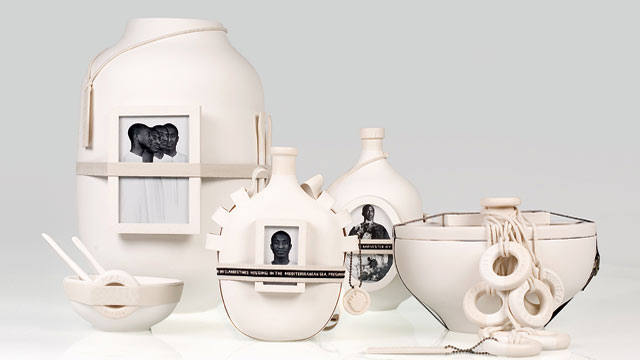
-
 Kerstin Pinther
Kerstin PintherMoulding Tradition (2009) is a work done by the designers Andrea Trimarchi and Simone Farresin of Studio Formafantasma: It consists of a group of five ceramics in different shapes and forms: boat-like bowls of various sizes, vases and bottles. Some of the maiolica objects display special attributes which refer to the sea and to rescue operations on the water such as a pair of paddles and lifebuoys. Others use ribbons, printed with historical and immigration data, to tie framed photographs and other ‘décor’ to the vessels. The project is informed by the tin-glazed maiolica from Caltagirone in Sicily – itself a result of the encounter with (Moorish) Islamic ceramic traditions in the eleventh and twelfth centuries, which in the following centuries triggered a technical and content-related process of adaptation. From the early modern age onwards, maiolica thus became “an excellent indicator and agent of design transmission across the globe” (Ajmar-Wollheim/Molà 2011, 17).
Among the ceramic vessels being produced up till now is the genre of the so-called teste di moro – vases that in a stereotypical, often grotesque and derogative manner depict the faces of people referred to as either ‘African’ or as ‘Arabic.’ In their original form as busts they most probably date back to the seventeenth century, when they were used as flowerpots to decorate balconies and terraces, suggesting an exuberant vegetation. By replacing this generic image with a black-and-white photograph of a known and thus named immigrant from Nigeria, Sofien Adeyemi, Andrea Trimarchi and Simone Farresin update the references and create a link to recent migration movements. A flask with an attached ceramic tile lists the names of the countries Adeyemi has traveled through on his way from West Africa to Italy. His (multiplied) portrait together with written information on present-day migration policies is attached to the ceramic form, thus literally adding a new level of meaning. Yet another wine bottle recalls fruit picking, predominantly done by migrant workers under harsh and exploitative conditions.
By introducing further elements of reality in traditional forms, Formafantasma with Moulding Tradition create complex discourses on the historical and present-day entanglements between Africa and Europe and the imbalance in their economic and political conditions. According to the designers, “contemporary public opinion polls have claimed that 65% of Italians believe that the immigrants are ‘a danger for our culture.’” In this context Moulding Tradition speaks of the blind spots of contemporary culture: Neither the explicit transcultural character of the maiolica which had contributed to – if not established – the fame of Caltagirone’s craft tradition is valued, nor are the descendants of those who once introduced this new ceramic technique welcomed. Moulding Tradition also alludes to the fact that in the most recent age of globalization nearly everything – data, information, images, objects – is free-flowing, but some people’s movements from specific geographies are monitored and restricted. Thus, it questions the ideology of cultural segregation and confronts it with the factual migration of people and goods as well as with the various historical entanglements. Furthermore, Moulding Tradition, for which the designers cooperated with a local craftsperson, can also be read as a comment on the role of craft in contemporary society as well as on the question of how craft is sometimes “locked into a tradition repeating [moulding, author’s note] the same objects over and over again” (Studio Formafantasma 2015). In order to counter this tendency, the designers left their products with a kind of raw surface, since normally maiolica ceramic is painted in bold colors after being dried thoroughly. In the case of Formafantasma’s maiolica, the objects remain ‘unfinished’ – a (blank) space to metaphorically be worked on and to open up a debate. Thus, Moulding Tradition stands for Studio Formafantasma’s conceptual and critical design-thinking approach. In this approach, the duo relies on textual information as well as on the haptic and aesthetic qualities of the substances they use: “[M]aterials are not only functional but also have the ability to evoke memories or to testify historical knowledge” (Studio Formafantasma 2015).
The authors of Global Design History make clear how the most recent phase of globalization not only accelerates flows of people, images, information, commodities and capital, but also contributes to the various types of exclusion and border control regimes (Adamson, et al. 2010, 1f.). At a time when design is becoming increasingly politicized, the question of how designers respond to the hitherto biggest wave of flight and migration in the years 2015/16 becomes obvious. Indeed, similar to Moulding Tradition, there are other design objects as well as works at the interface of design and art which can be seen as tools for reflecting on migration and flight. In using design as a tool, the migrancy reference can often be found on more than only one level. Besides its content-related presence, it is also tangible via the objects’ materiality or techniques, which for their part often bear traces of mobility and cultural transfer. Thus, these objects speak strongly to the historical and cultural migration of forms.
References
- Adamson, Glenn, et al., editors. Global Design History. Routledge, 2011.
- Ajmar-Wollheim, Marta, and Luca Molà. “The Global Renaissance. Cross-cultural Objects in the Early Modern Period.” Global Design History, edited by Glenn Adamson, Giorgio Riello and Sarah Teasly, Routledge, 2011, pp. 11–20.
- Studio Formafantasma. “Studio Formafantasma on Words as a Tool for Design.” Design Indaba Conference, Talk on November 3rd 2015, http://www.designindaba.com/videos/conference-talks/studio-formafantasma-words-tool-design.
published February 2020

